Gustave dore paradiso dante Stock Photos and Images
(289)See gustave dore paradiso dante stock video clipsQuick filters:
Gustave dore paradiso dante Stock Photos and Images
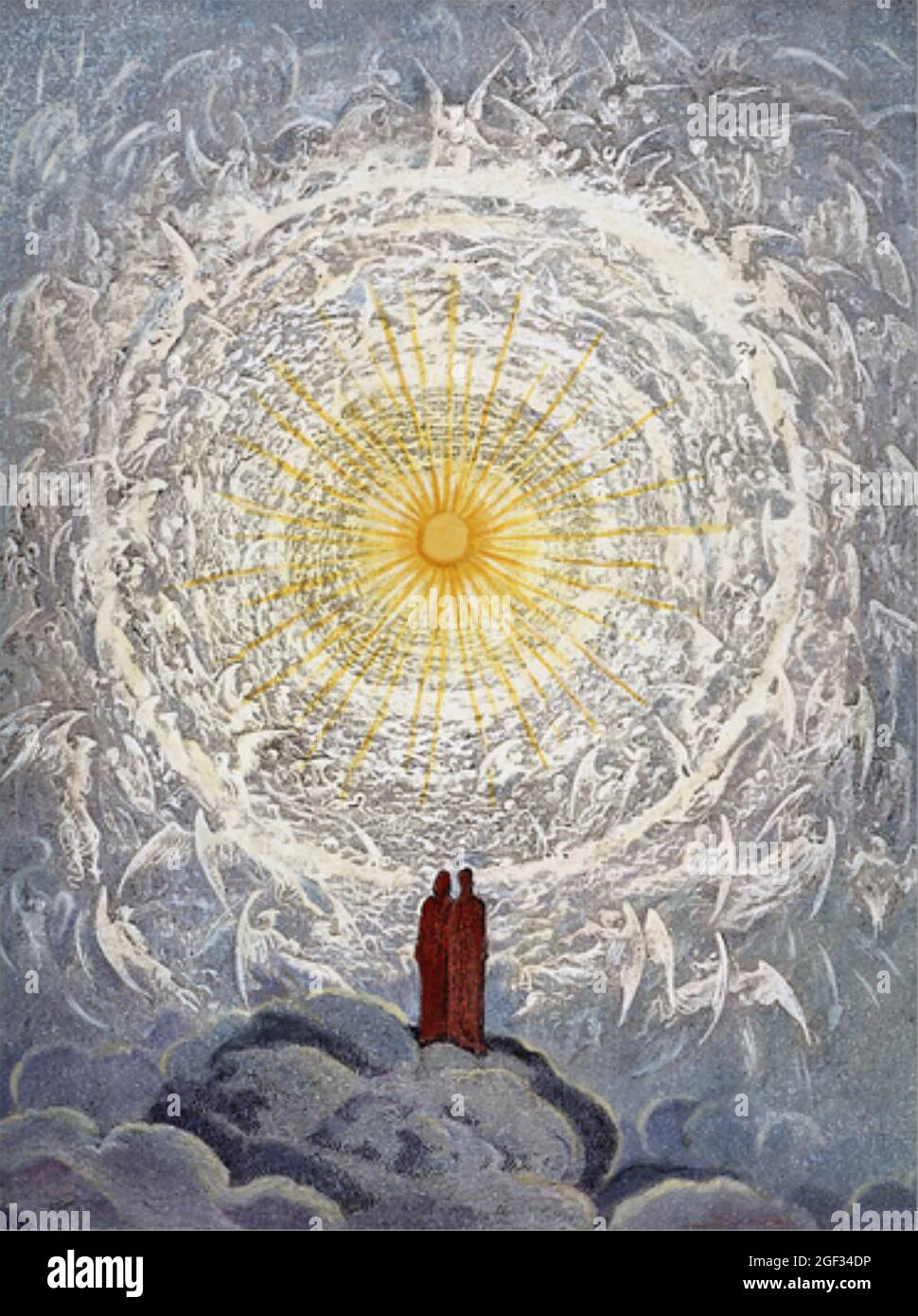 DANTE AND BEATRICE in Heaven as drawn by Gustave Doré in 1868 to illustrate part of Dante's Divine Comedy Stock Photohttps://www.alamy.com/image-license-details/?v=1https://www.alamy.com/dante-and-beatrice-in-heaven-as-drawn-by-gustave-dor-in-1868-to-illustrate-part-of-dantes-divine-comedy-image439548418.html
DANTE AND BEATRICE in Heaven as drawn by Gustave Doré in 1868 to illustrate part of Dante's Divine Comedy Stock Photohttps://www.alamy.com/image-license-details/?v=1https://www.alamy.com/dante-and-beatrice-in-heaven-as-drawn-by-gustave-dor-in-1868-to-illustrate-part-of-dantes-divine-comedy-image439548418.htmlRM2GF34DP–DANTE AND BEATRICE in Heaven as drawn by Gustave Doré in 1868 to illustrate part of Dante's Divine Comedy
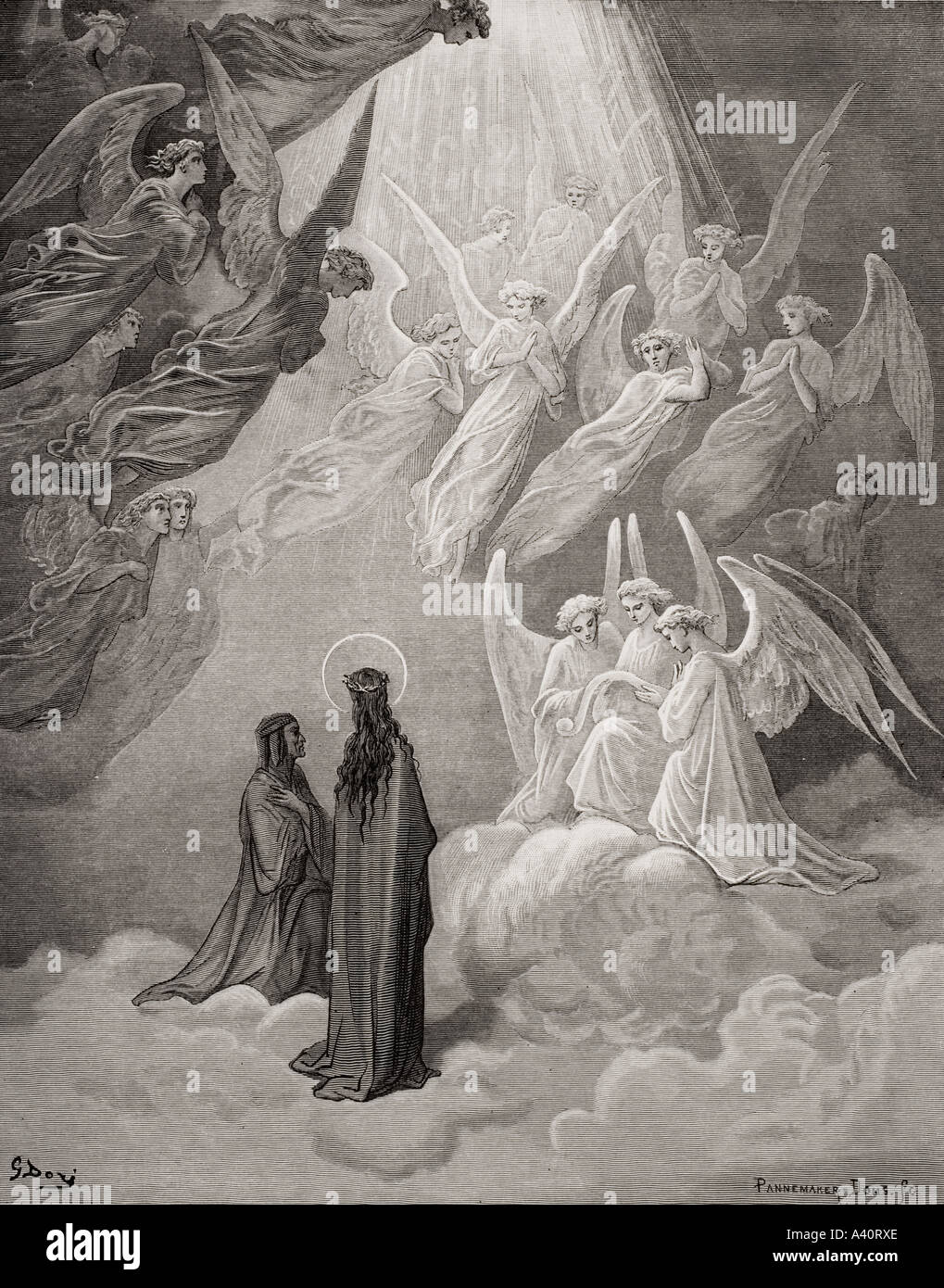 Illustration for Paradiso by Dante Alighieri, Canto XX, lines 10 to 12, by Gustave Dore, 1832 - 1883. French artist and illustrator. Stock Photohttps://www.alamy.com/image-license-details/?v=1https://www.alamy.com/illustration-for-paradiso-by-dante-alighieri-canto-xx-lines-10-to-image6226413.html
Illustration for Paradiso by Dante Alighieri, Canto XX, lines 10 to 12, by Gustave Dore, 1832 - 1883. French artist and illustrator. Stock Photohttps://www.alamy.com/image-license-details/?v=1https://www.alamy.com/illustration-for-paradiso-by-dante-alighieri-canto-xx-lines-10-to-image6226413.htmlRMA40RXE–Illustration for Paradiso by Dante Alighieri, Canto XX, lines 10 to 12, by Gustave Dore, 1832 - 1883. French artist and illustrator.
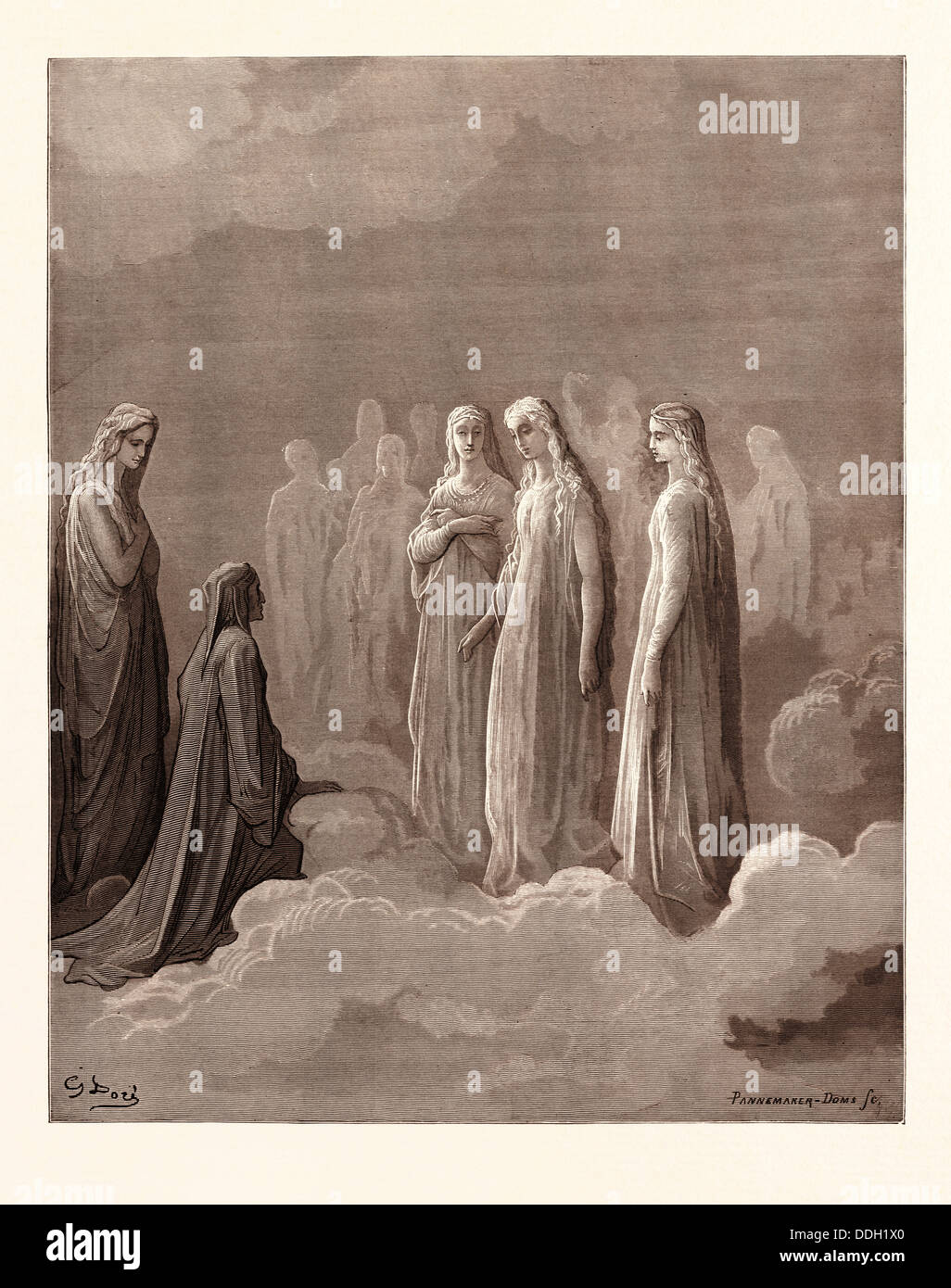 DANTE AND THE SPIRITS OF THE MOON, BY GUSTAVE DORÉ. Dore, 1832 - 1883, French. Engraving for Paradiso by Dante. 1870, Art Stock Photohttps://www.alamy.com/image-license-details/?v=1https://www.alamy.com/stock-photo-dante-and-the-spirits-of-the-moon-by-gustave-dor-dore-1832-1883-french-59996328.html
DANTE AND THE SPIRITS OF THE MOON, BY GUSTAVE DORÉ. Dore, 1832 - 1883, French. Engraving for Paradiso by Dante. 1870, Art Stock Photohttps://www.alamy.com/image-license-details/?v=1https://www.alamy.com/stock-photo-dante-and-the-spirits-of-the-moon-by-gustave-dor-dore-1832-1883-french-59996328.htmlRMDDH1X0–DANTE AND THE SPIRITS OF THE MOON, BY GUSTAVE DORÉ. Dore, 1832 - 1883, French. Engraving for Paradiso by Dante. 1870, Art
 From the Divine Comedy by 14th century Italian poet Dante Alighieri. 1860 artwork, by French artist Gustave Dore and engraved by Stephane Pannemaker, from 'The Vision of Hell' (1868), Cary's English translation of the Inferno. Dante wrote his epic poem 'Divina Commedia' (The Divine Comedy) between 1308 and his death in 1321. Consisting of 14,233 lines, and divided into three parts (Inferno, Purgatorio, and Paradiso), it is considered the greatest literary work in the Italian language and a world masterpiece. It is a comprehensive survey of medieval theology, literature and thought. The new non Stock Photohttps://www.alamy.com/image-license-details/?v=1https://www.alamy.com/from-the-divine-comedy-by-14th-century-italian-poet-dante-alighieri-1860-artwork-by-french-artist-gustave-dore-and-engraved-by-stephane-pannemaker-from-the-vision-of-hell-1868-carys-english-translation-of-the-inferno-dante-wrote-his-epic-poem-divina-commedia-the-divine-comedy-between-1308-and-his-death-in-1321-consisting-of-14233-lines-and-divided-into-three-parts-inferno-purgatorio-and-paradiso-it-is-considered-the-greatest-literary-work-in-the-italian-language-and-a-world-masterpiece-it-is-a-comprehensive-survey-of-medieval-theology-literature-and-thought-the-new-non-image358668127.html
From the Divine Comedy by 14th century Italian poet Dante Alighieri. 1860 artwork, by French artist Gustave Dore and engraved by Stephane Pannemaker, from 'The Vision of Hell' (1868), Cary's English translation of the Inferno. Dante wrote his epic poem 'Divina Commedia' (The Divine Comedy) between 1308 and his death in 1321. Consisting of 14,233 lines, and divided into three parts (Inferno, Purgatorio, and Paradiso), it is considered the greatest literary work in the Italian language and a world masterpiece. It is a comprehensive survey of medieval theology, literature and thought. The new non Stock Photohttps://www.alamy.com/image-license-details/?v=1https://www.alamy.com/from-the-divine-comedy-by-14th-century-italian-poet-dante-alighieri-1860-artwork-by-french-artist-gustave-dore-and-engraved-by-stephane-pannemaker-from-the-vision-of-hell-1868-carys-english-translation-of-the-inferno-dante-wrote-his-epic-poem-divina-commedia-the-divine-comedy-between-1308-and-his-death-in-1321-consisting-of-14233-lines-and-divided-into-three-parts-inferno-purgatorio-and-paradiso-it-is-considered-the-greatest-literary-work-in-the-italian-language-and-a-world-masterpiece-it-is-a-comprehensive-survey-of-medieval-theology-literature-and-thought-the-new-non-image358668127.htmlRM2BREMRY–From the Divine Comedy by 14th century Italian poet Dante Alighieri. 1860 artwork, by French artist Gustave Dore and engraved by Stephane Pannemaker, from 'The Vision of Hell' (1868), Cary's English translation of the Inferno. Dante wrote his epic poem 'Divina Commedia' (The Divine Comedy) between 1308 and his death in 1321. Consisting of 14,233 lines, and divided into three parts (Inferno, Purgatorio, and Paradiso), it is considered the greatest literary work in the Italian language and a world masterpiece. It is a comprehensive survey of medieval theology, literature and thought. The new non
 Dante and the Spirits of the Moon, by Gustave Doré, 1832 - 1883, French. Engraving for Paradiso by Dante. 1870, Art, Artist, Romanticism, Colour, Color Engraving Stock Photohttps://www.alamy.com/image-license-details/?v=1https://www.alamy.com/dante-and-the-spirits-of-the-moon-by-gustave-dor-1832-1883-french-engraving-for-paradiso-by-dante-1870-art-artist-romanticism-colour-color-engraving-image240631634.html
Dante and the Spirits of the Moon, by Gustave Doré, 1832 - 1883, French. Engraving for Paradiso by Dante. 1870, Art, Artist, Romanticism, Colour, Color Engraving Stock Photohttps://www.alamy.com/image-license-details/?v=1https://www.alamy.com/dante-and-the-spirits-of-the-moon-by-gustave-dor-1832-1883-french-engraving-for-paradiso-by-dante-1870-art-artist-romanticism-colour-color-engraving-image240631634.htmlRMRYDM2X–Dante and the Spirits of the Moon, by Gustave Doré, 1832 - 1883, French. Engraving for Paradiso by Dante. 1870, Art, Artist, Romanticism, Colour, Color Engraving
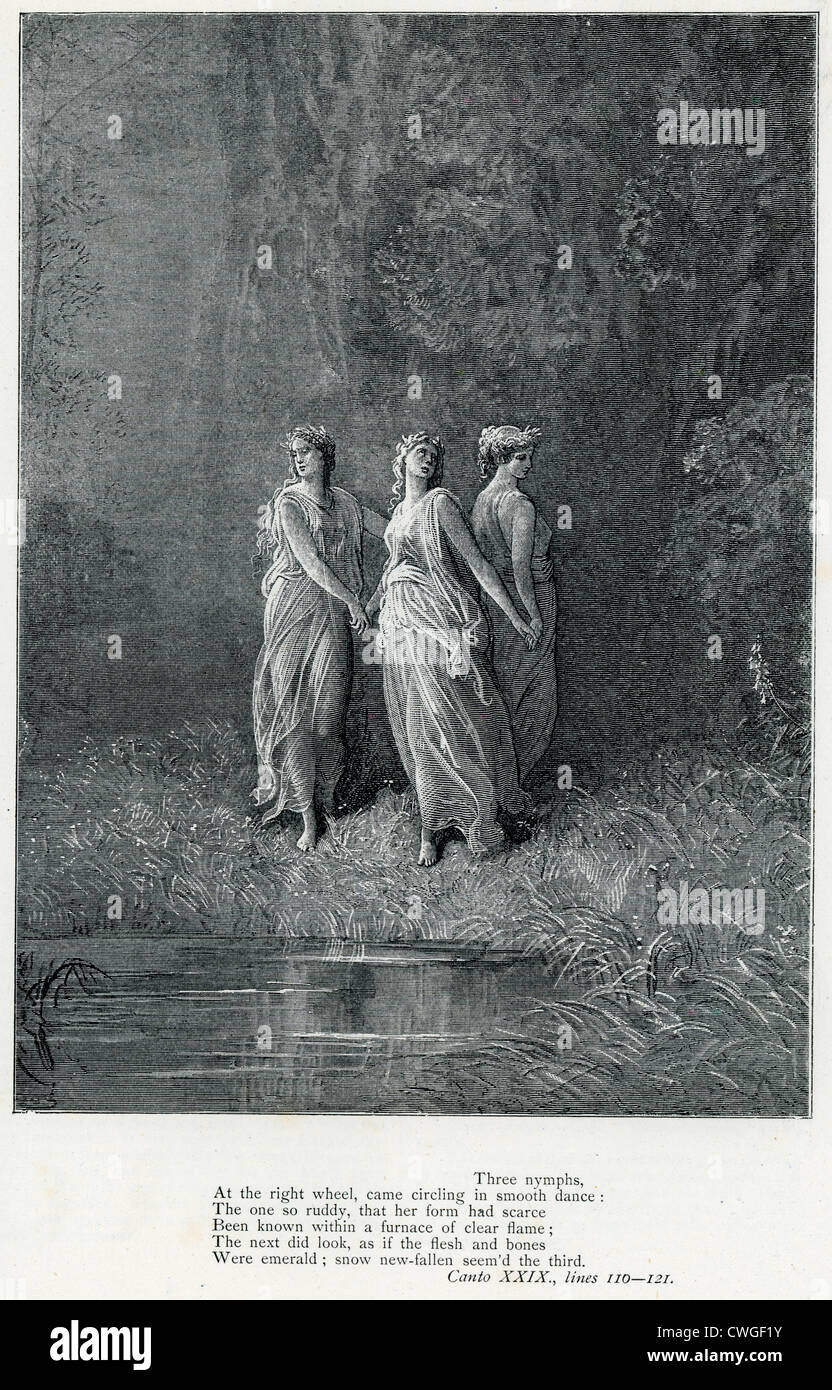 Illustration by Gustave Dore from The Vision of Purgatory and Paradise by Dante Alighieri Stock Photohttps://www.alamy.com/image-license-details/?v=1https://www.alamy.com/stock-photo-illustration-by-gustave-dore-from-the-vision-of-purgatory-and-paradise-50150183.html
Illustration by Gustave Dore from The Vision of Purgatory and Paradise by Dante Alighieri Stock Photohttps://www.alamy.com/image-license-details/?v=1https://www.alamy.com/stock-photo-illustration-by-gustave-dore-from-the-vision-of-purgatory-and-paradise-50150183.htmlRMCWGF1Y–Illustration by Gustave Dore from The Vision of Purgatory and Paradise by Dante Alighieri
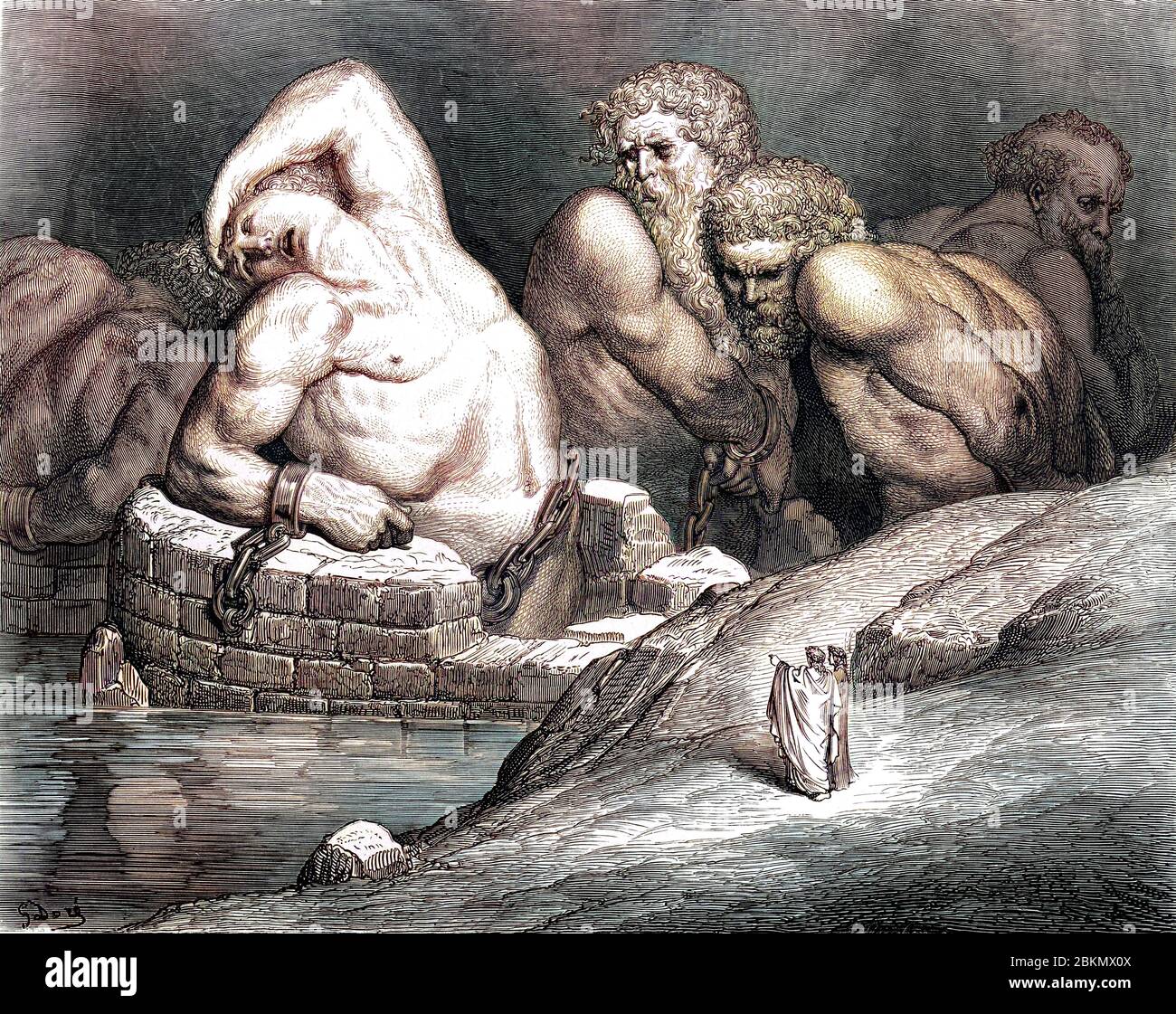 Machine colorized with Artificial Intelligence (AI) From the Divine Comedy by 14th century Italian poet Dante Alighieri. 1860 artwork, by French artist Gustave Dore and engraved by Stephane Pannemaker, from 'The Vision of Hell' (1868), Cary's English translation of the Inferno. Dante wrote his epic poem 'Divina Commedia' (The Divine Comedy) between 1308 and his death in 1321. Consisting of 14,233 lines, and divided into three parts (Inferno, Purgatorio, and Paradiso), it is considered the greatest literary work in the Italian language and a world masterpiece. It is a comprehensive survey of me Stock Photohttps://www.alamy.com/image-license-details/?v=1https://www.alamy.com/machine-colorized-with-artificial-intelligence-ai-from-the-divine-comedy-by-14th-century-italian-poet-dante-alighieri-1860-artwork-by-french-artist-gustave-dore-and-engraved-by-stephane-pannemaker-from-the-vision-of-hell-1868-carys-english-translation-of-the-inferno-dante-wrote-his-epic-poem-divina-commedia-the-divine-comedy-between-1308-and-his-death-in-1321-consisting-of-14233-lines-and-divided-into-three-parts-inferno-purgatorio-and-paradiso-it-is-considered-the-greatest-literary-work-in-the-italian-language-and-a-world-masterpiece-it-is-a-comprehensive-survey-of-me-image356345274.html
Machine colorized with Artificial Intelligence (AI) From the Divine Comedy by 14th century Italian poet Dante Alighieri. 1860 artwork, by French artist Gustave Dore and engraved by Stephane Pannemaker, from 'The Vision of Hell' (1868), Cary's English translation of the Inferno. Dante wrote his epic poem 'Divina Commedia' (The Divine Comedy) between 1308 and his death in 1321. Consisting of 14,233 lines, and divided into three parts (Inferno, Purgatorio, and Paradiso), it is considered the greatest literary work in the Italian language and a world masterpiece. It is a comprehensive survey of me Stock Photohttps://www.alamy.com/image-license-details/?v=1https://www.alamy.com/machine-colorized-with-artificial-intelligence-ai-from-the-divine-comedy-by-14th-century-italian-poet-dante-alighieri-1860-artwork-by-french-artist-gustave-dore-and-engraved-by-stephane-pannemaker-from-the-vision-of-hell-1868-carys-english-translation-of-the-inferno-dante-wrote-his-epic-poem-divina-commedia-the-divine-comedy-between-1308-and-his-death-in-1321-consisting-of-14233-lines-and-divided-into-three-parts-inferno-purgatorio-and-paradiso-it-is-considered-the-greatest-literary-work-in-the-italian-language-and-a-world-masterpiece-it-is-a-comprehensive-survey-of-me-image356345274.htmlRM2BKMX0X–Machine colorized with Artificial Intelligence (AI) From the Divine Comedy by 14th century Italian poet Dante Alighieri. 1860 artwork, by French artist Gustave Dore and engraved by Stephane Pannemaker, from 'The Vision of Hell' (1868), Cary's English translation of the Inferno. Dante wrote his epic poem 'Divina Commedia' (The Divine Comedy) between 1308 and his death in 1321. Consisting of 14,233 lines, and divided into three parts (Inferno, Purgatorio, and Paradiso), it is considered the greatest literary work in the Italian language and a world masterpiece. It is a comprehensive survey of me
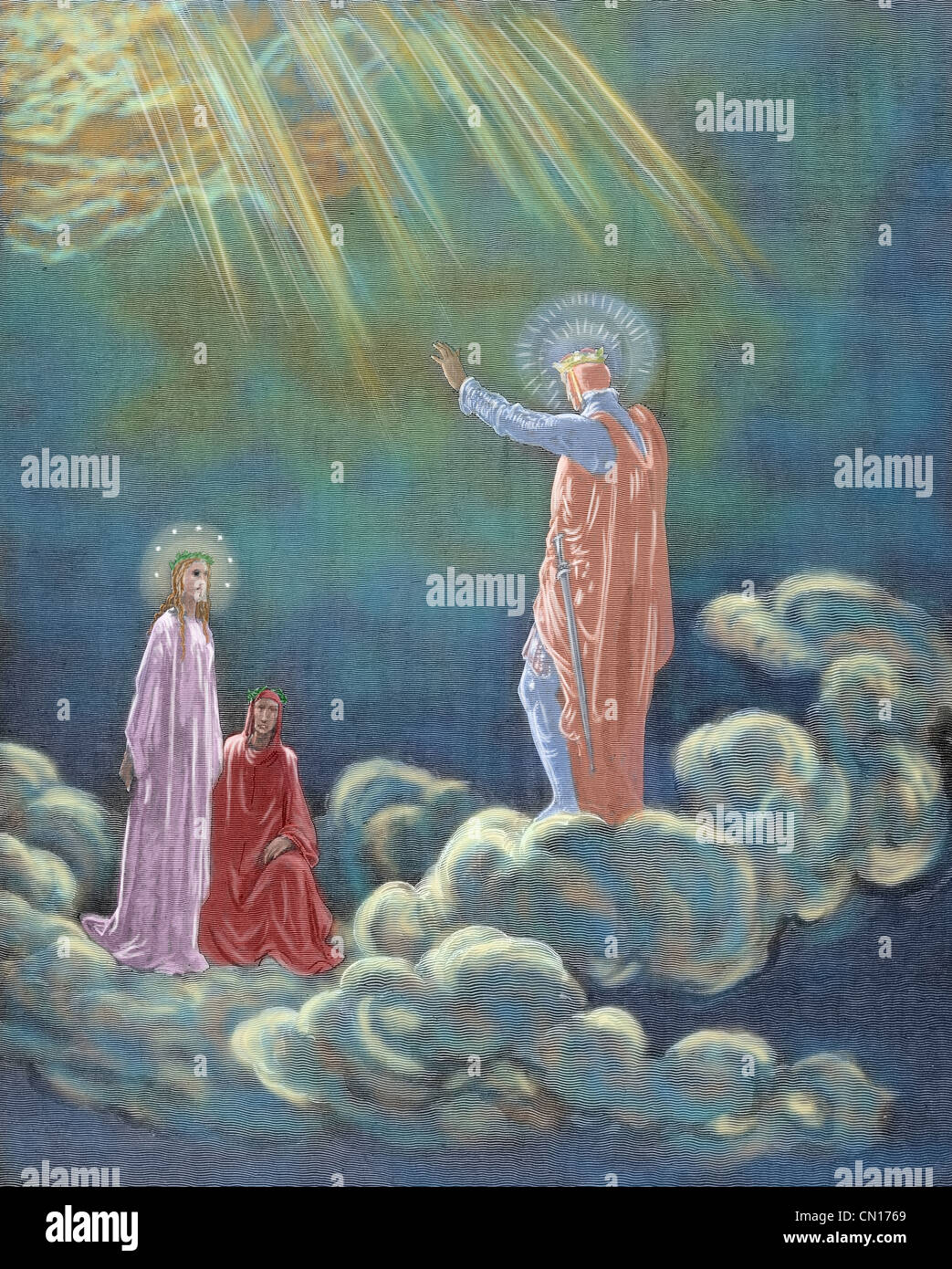 Divine Comedy. Purgatory. Hell. Dante finds Ciacco among the gourmands. Sixth Canto. By Dore. Stock Photohttps://www.alamy.com/image-license-details/?v=1https://www.alamy.com/stock-photo-divine-comedy-purgatory-hell-dante-finds-ciacco-among-the-gourmands-47356129.html
Divine Comedy. Purgatory. Hell. Dante finds Ciacco among the gourmands. Sixth Canto. By Dore. Stock Photohttps://www.alamy.com/image-license-details/?v=1https://www.alamy.com/stock-photo-divine-comedy-purgatory-hell-dante-finds-ciacco-among-the-gourmands-47356129.htmlRMCN1769–Divine Comedy. Purgatory. Hell. Dante finds Ciacco among the gourmands. Sixth Canto. By Dore.
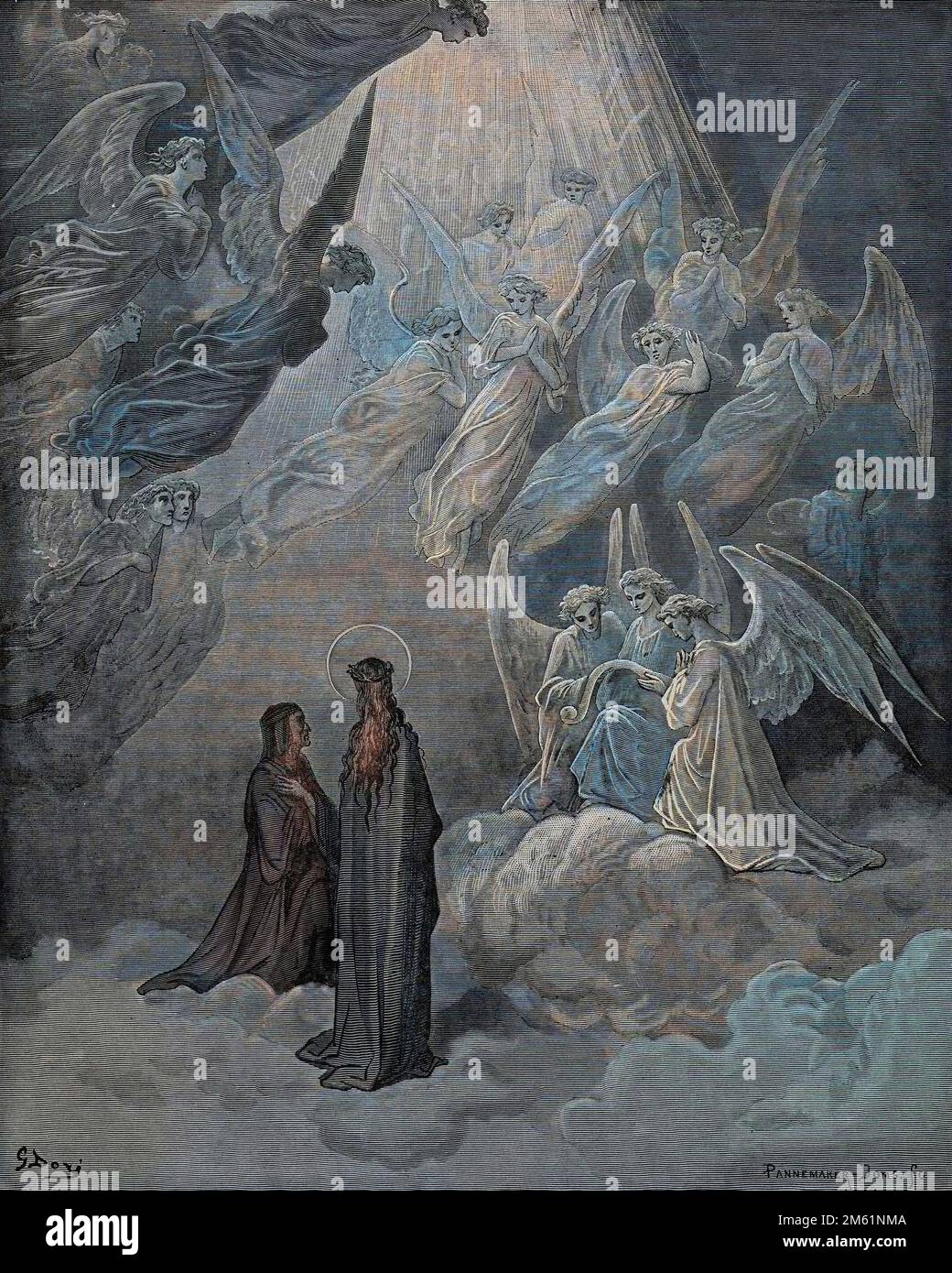 The Divine Comedy by Dante Alighieri , Paradiso, Canto 20 : The luminous souls sing - by Dante Alighieri (1265-1321) - Illustration de Gustave Dore (1832-1883), 1885 - Colorisation digitale d'apres l'originale Stock Photohttps://www.alamy.com/image-license-details/?v=1https://www.alamy.com/the-divine-comedy-by-dante-alighieri-paradiso-canto-20-the-luminous-souls-sing-by-dante-alighieri-1265-1321-illustration-de-gustave-dore-1832-1883-1885-colorisation-digitale-dapres-loriginale-image502827594.html
The Divine Comedy by Dante Alighieri , Paradiso, Canto 20 : The luminous souls sing - by Dante Alighieri (1265-1321) - Illustration de Gustave Dore (1832-1883), 1885 - Colorisation digitale d'apres l'originale Stock Photohttps://www.alamy.com/image-license-details/?v=1https://www.alamy.com/the-divine-comedy-by-dante-alighieri-paradiso-canto-20-the-luminous-souls-sing-by-dante-alighieri-1265-1321-illustration-de-gustave-dore-1832-1883-1885-colorisation-digitale-dapres-loriginale-image502827594.htmlRM2M61NMA–The Divine Comedy by Dante Alighieri , Paradiso, Canto 20 : The luminous souls sing - by Dante Alighieri (1265-1321) - Illustration de Gustave Dore (1832-1883), 1885 - Colorisation digitale d'apres l'originale
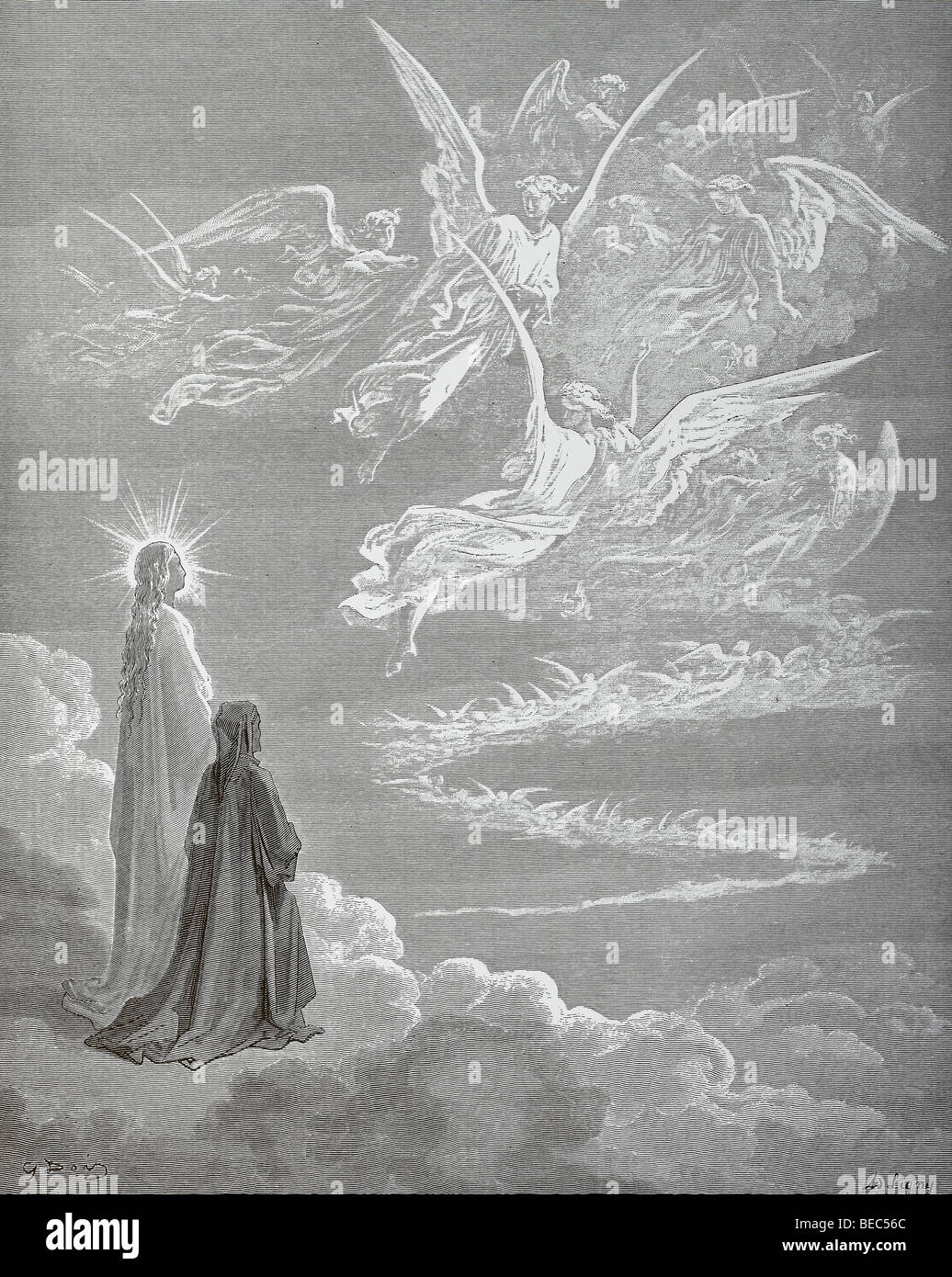 Gustave Dore's Illustration 'Jupiter' from Dante's Divine Comedy Stock Photohttps://www.alamy.com/image-license-details/?v=1https://www.alamy.com/stock-photo-gustave-dores-illustration-jupiter-from-dantes-divine-comedy-26083076.html
Gustave Dore's Illustration 'Jupiter' from Dante's Divine Comedy Stock Photohttps://www.alamy.com/image-license-details/?v=1https://www.alamy.com/stock-photo-gustave-dores-illustration-jupiter-from-dantes-divine-comedy-26083076.htmlRMBEC56C–Gustave Dore's Illustration 'Jupiter' from Dante's Divine Comedy
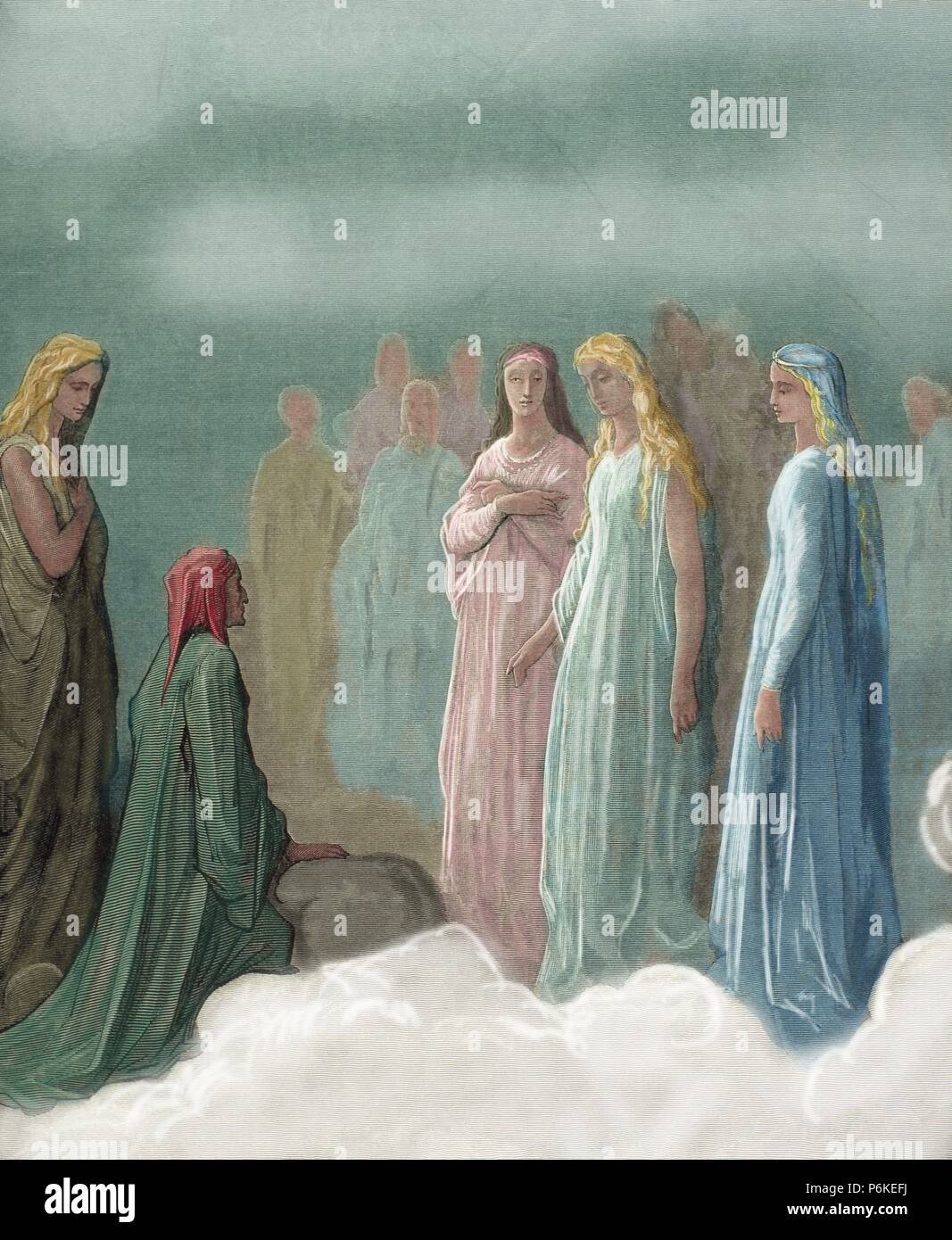 Divine Comedy. Epic poem written by Dante Alighieri (1265-1321) between 1308 and his death in 1321. Paradiso Canto III. Piccarda Donati and souls whose vows had been broken. Engraving by Gustave Dore, 1868. Colored. Stock Photohttps://www.alamy.com/image-license-details/?v=1https://www.alamy.com/divine-comedy-epic-poem-written-by-dante-alighieri-1265-1321-between-1308-and-his-death-in-1321-paradiso-canto-iii-piccarda-donati-and-souls-whose-vows-had-been-broken-engraving-by-gustave-dore-1868-colored-image210640854.html
Divine Comedy. Epic poem written by Dante Alighieri (1265-1321) between 1308 and his death in 1321. Paradiso Canto III. Piccarda Donati and souls whose vows had been broken. Engraving by Gustave Dore, 1868. Colored. Stock Photohttps://www.alamy.com/image-license-details/?v=1https://www.alamy.com/divine-comedy-epic-poem-written-by-dante-alighieri-1265-1321-between-1308-and-his-death-in-1321-paradiso-canto-iii-piccarda-donati-and-souls-whose-vows-had-been-broken-engraving-by-gustave-dore-1868-colored-image210640854.htmlRMP6KEFJ–Divine Comedy. Epic poem written by Dante Alighieri (1265-1321) between 1308 and his death in 1321. Paradiso Canto III. Piccarda Donati and souls whose vows had been broken. Engraving by Gustave Dore, 1868. Colored.
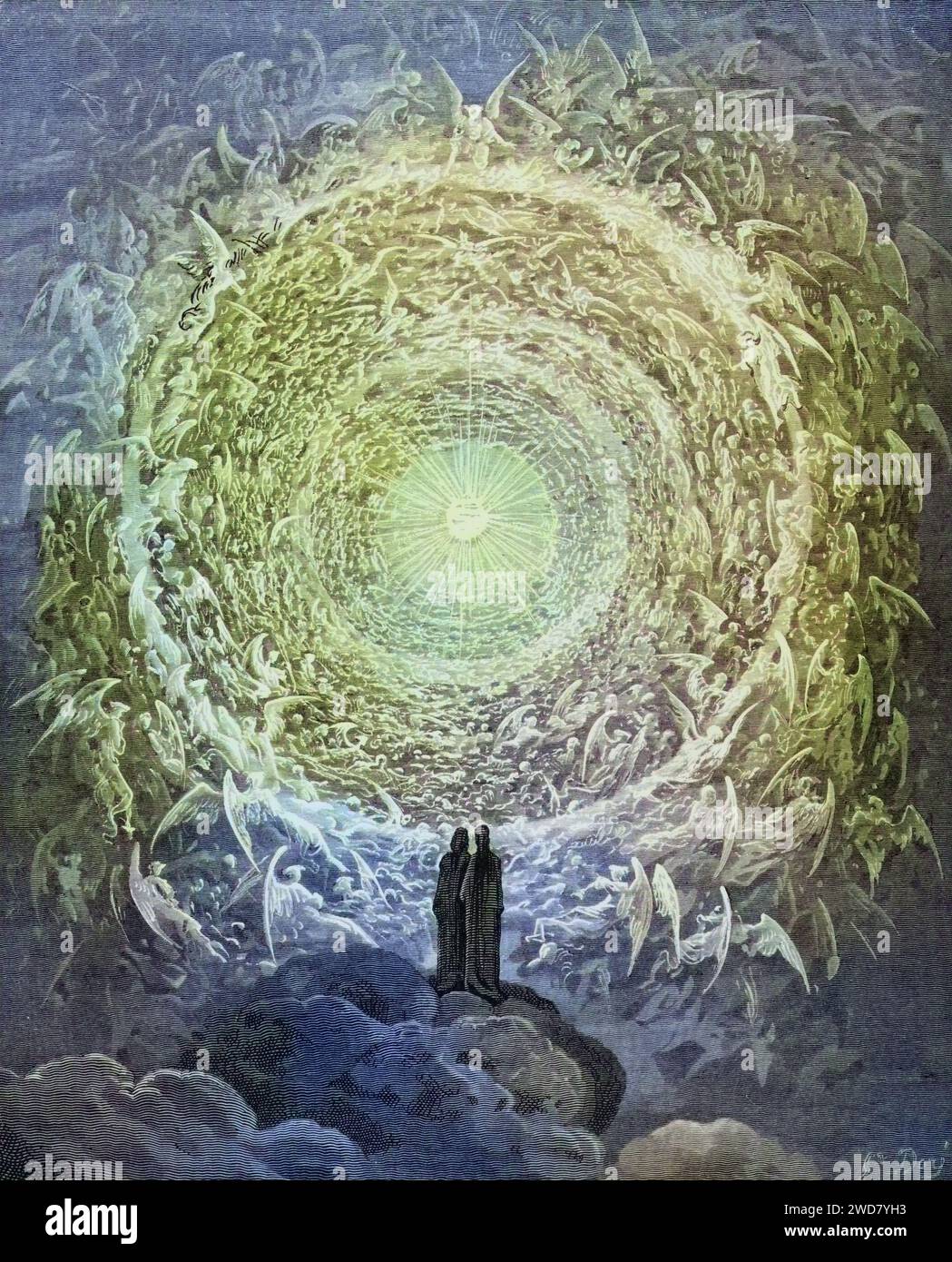 Illustration für Paradiso, die Göttliche Komödie von Dante Alighieri von Gustave Dore 1832-1883, französischer Künstler, Inferno, Hölle, Paradies, Engel, Verdammnis, Historisch, digital restaurierte Reproduktion von einer Vorlage aus dem 19. Jahrhundert, Record date not stated Stock Photohttps://www.alamy.com/image-license-details/?v=1https://www.alamy.com/illustration-fr-paradiso-die-gttliche-komdie-von-dante-alighieri-von-gustave-dore-1832-1883-franzsischer-knstler-inferno-hlle-paradies-engel-verdammnis-historisch-digital-restaurierte-reproduktion-von-einer-vorlage-aus-dem-19-jahrhundert-record-date-not-stated-image593318351.html
Illustration für Paradiso, die Göttliche Komödie von Dante Alighieri von Gustave Dore 1832-1883, französischer Künstler, Inferno, Hölle, Paradies, Engel, Verdammnis, Historisch, digital restaurierte Reproduktion von einer Vorlage aus dem 19. Jahrhundert, Record date not stated Stock Photohttps://www.alamy.com/image-license-details/?v=1https://www.alamy.com/illustration-fr-paradiso-die-gttliche-komdie-von-dante-alighieri-von-gustave-dore-1832-1883-franzsischer-knstler-inferno-hlle-paradies-engel-verdammnis-historisch-digital-restaurierte-reproduktion-von-einer-vorlage-aus-dem-19-jahrhundert-record-date-not-stated-image593318351.htmlRF2WD7YH3–Illustration für Paradiso, die Göttliche Komödie von Dante Alighieri von Gustave Dore 1832-1883, französischer Künstler, Inferno, Hölle, Paradies, Engel, Verdammnis, Historisch, digital restaurierte Reproduktion von einer Vorlage aus dem 19. Jahrhundert, Record date not stated
 Dante and the Spirits of the Moon, by Gustave Doré, 1832 - 1883, French. Engraving for Paradiso by Dante. 1870, Art reimagined Stock Photohttps://www.alamy.com/image-license-details/?v=1https://www.alamy.com/dante-and-the-spirits-of-the-moon-by-gustave-dor-1832-1883-french-engraving-for-paradiso-by-dante-1870-art-reimagined-image230058609.html
Dante and the Spirits of the Moon, by Gustave Doré, 1832 - 1883, French. Engraving for Paradiso by Dante. 1870, Art reimagined Stock Photohttps://www.alamy.com/image-license-details/?v=1https://www.alamy.com/dante-and-the-spirits-of-the-moon-by-gustave-dor-1832-1883-french-engraving-for-paradiso-by-dante-1870-art-reimagined-image230058609.htmlRFRA822W–Dante and the Spirits of the Moon, by Gustave Doré, 1832 - 1883, French. Engraving for Paradiso by Dante. 1870, Art reimagined
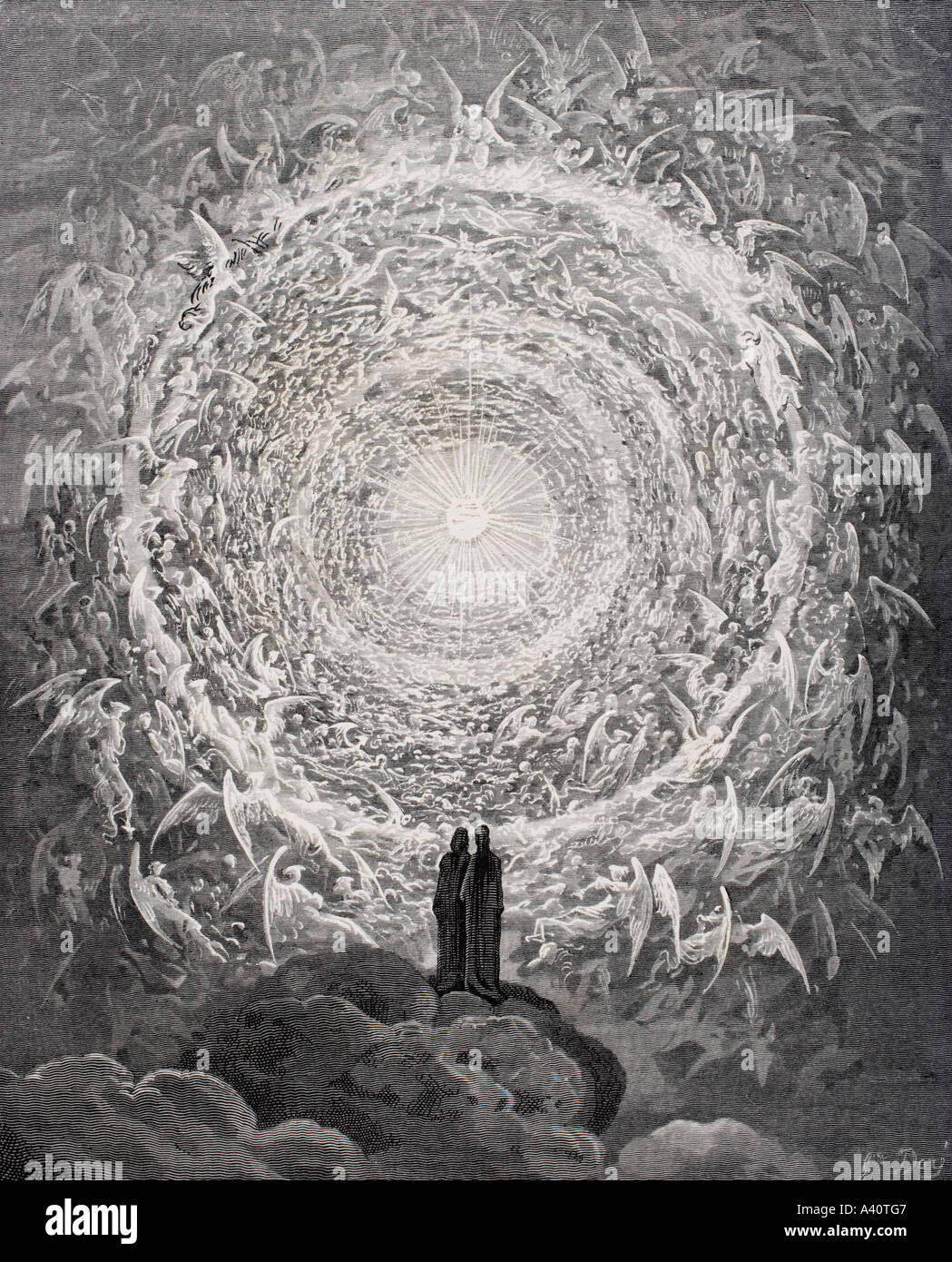 Illustration for Paradiso by Dante Alighieri. Canto XXXI, lines 1 to 3, by Gustave Dore, 1832 - 1883. French artist and illustrator. Stock Photohttps://www.alamy.com/image-license-details/?v=1https://www.alamy.com/illustration-for-paradiso-by-dante-alighieri-canto-xxxi-lines-1-to-image6226438.html
Illustration for Paradiso by Dante Alighieri. Canto XXXI, lines 1 to 3, by Gustave Dore, 1832 - 1883. French artist and illustrator. Stock Photohttps://www.alamy.com/image-license-details/?v=1https://www.alamy.com/illustration-for-paradiso-by-dante-alighieri-canto-xxxi-lines-1-to-image6226438.htmlRMA40TG7–Illustration for Paradiso by Dante Alighieri. Canto XXXI, lines 1 to 3, by Gustave Dore, 1832 - 1883. French artist and illustrator.
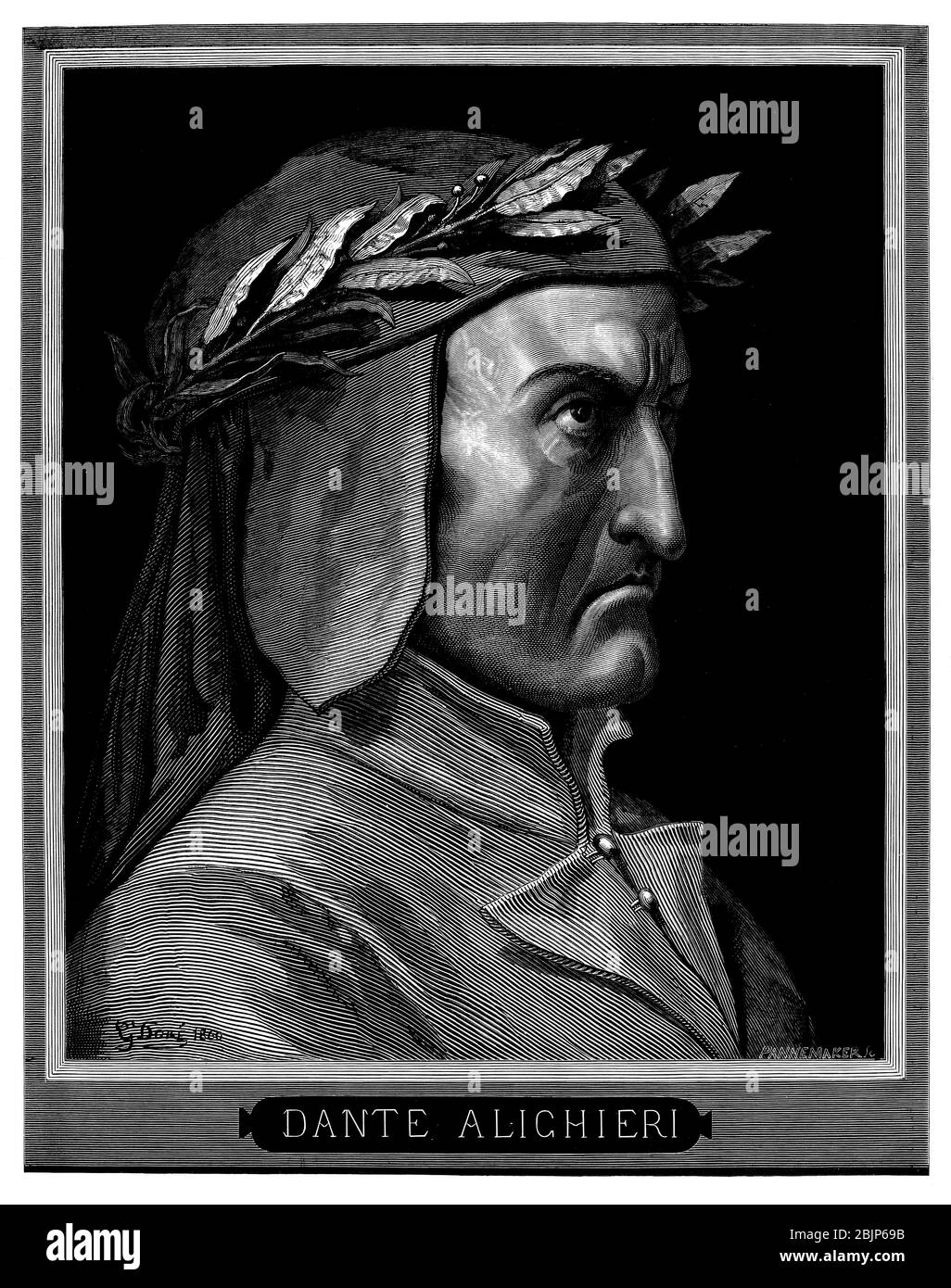 The 14th century c Italian poet Dante Alighieri, author of the Divine Comedy. 1860 artwork, by French artist Gustave Dore and engraved by Stephane Pannemaker, being the frontispiece from 'The Vision of Hell' (1868), Cary's English translation of the Inferno Dante wrote his epic poem 'Divina Commedia' (The Divine Comedy) between 1308 and his death in 1321. Consisting of 14,233 lines, and divided into three parts (Inferno, Purgatorio, and Paradiso), it is considered the greatest literary work in the Italian language and a world masterpiece. It is a comprehensive survey of medieval theology, lite Stock Photohttps://www.alamy.com/image-license-details/?v=1https://www.alamy.com/the-14th-century-c-italian-poet-dante-alighieri-author-of-the-divine-comedy-1860-artwork-by-french-artist-gustave-dore-and-engraved-by-stephane-pannemaker-being-the-frontispiece-from-the-vision-of-hell-1868-carys-english-translation-of-the-inferno-dante-wrote-his-epic-poem-divina-commedia-the-divine-comedy-between-1308-and-his-death-in-1321-consisting-of-14233-lines-and-divided-into-three-parts-inferno-purgatorio-and-paradiso-it-is-considered-the-greatest-literary-work-in-the-italian-language-and-a-world-masterpiece-it-is-a-comprehensive-survey-of-medieval-theology-lite-image355759079.html
The 14th century c Italian poet Dante Alighieri, author of the Divine Comedy. 1860 artwork, by French artist Gustave Dore and engraved by Stephane Pannemaker, being the frontispiece from 'The Vision of Hell' (1868), Cary's English translation of the Inferno Dante wrote his epic poem 'Divina Commedia' (The Divine Comedy) between 1308 and his death in 1321. Consisting of 14,233 lines, and divided into three parts (Inferno, Purgatorio, and Paradiso), it is considered the greatest literary work in the Italian language and a world masterpiece. It is a comprehensive survey of medieval theology, lite Stock Photohttps://www.alamy.com/image-license-details/?v=1https://www.alamy.com/the-14th-century-c-italian-poet-dante-alighieri-author-of-the-divine-comedy-1860-artwork-by-french-artist-gustave-dore-and-engraved-by-stephane-pannemaker-being-the-frontispiece-from-the-vision-of-hell-1868-carys-english-translation-of-the-inferno-dante-wrote-his-epic-poem-divina-commedia-the-divine-comedy-between-1308-and-his-death-in-1321-consisting-of-14233-lines-and-divided-into-three-parts-inferno-purgatorio-and-paradiso-it-is-considered-the-greatest-literary-work-in-the-italian-language-and-a-world-masterpiece-it-is-a-comprehensive-survey-of-medieval-theology-lite-image355759079.htmlRM2BJP69B–The 14th century c Italian poet Dante Alighieri, author of the Divine Comedy. 1860 artwork, by French artist Gustave Dore and engraved by Stephane Pannemaker, being the frontispiece from 'The Vision of Hell' (1868), Cary's English translation of the Inferno Dante wrote his epic poem 'Divina Commedia' (The Divine Comedy) between 1308 and his death in 1321. Consisting of 14,233 lines, and divided into three parts (Inferno, Purgatorio, and Paradiso), it is considered the greatest literary work in the Italian language and a world masterpiece. It is a comprehensive survey of medieval theology, lite
 Dante and the Spirits of the Moon, by Gustave Doré, 1832 - 1883, French. Engraving for Paradiso by Dante. 1870, Art, Artist Stock Photohttps://www.alamy.com/image-license-details/?v=1https://www.alamy.com/stock-photo-dante-and-the-spirits-of-the-moon-by-gustave-dor-1832-1883-french-123361715.html
Dante and the Spirits of the Moon, by Gustave Doré, 1832 - 1883, French. Engraving for Paradiso by Dante. 1870, Art, Artist Stock Photohttps://www.alamy.com/image-license-details/?v=1https://www.alamy.com/stock-photo-dante-and-the-spirits-of-the-moon-by-gustave-dor-1832-1883-french-123361715.htmlRMH4KH3F–Dante and the Spirits of the Moon, by Gustave Doré, 1832 - 1883, French. Engraving for Paradiso by Dante. 1870, Art, Artist
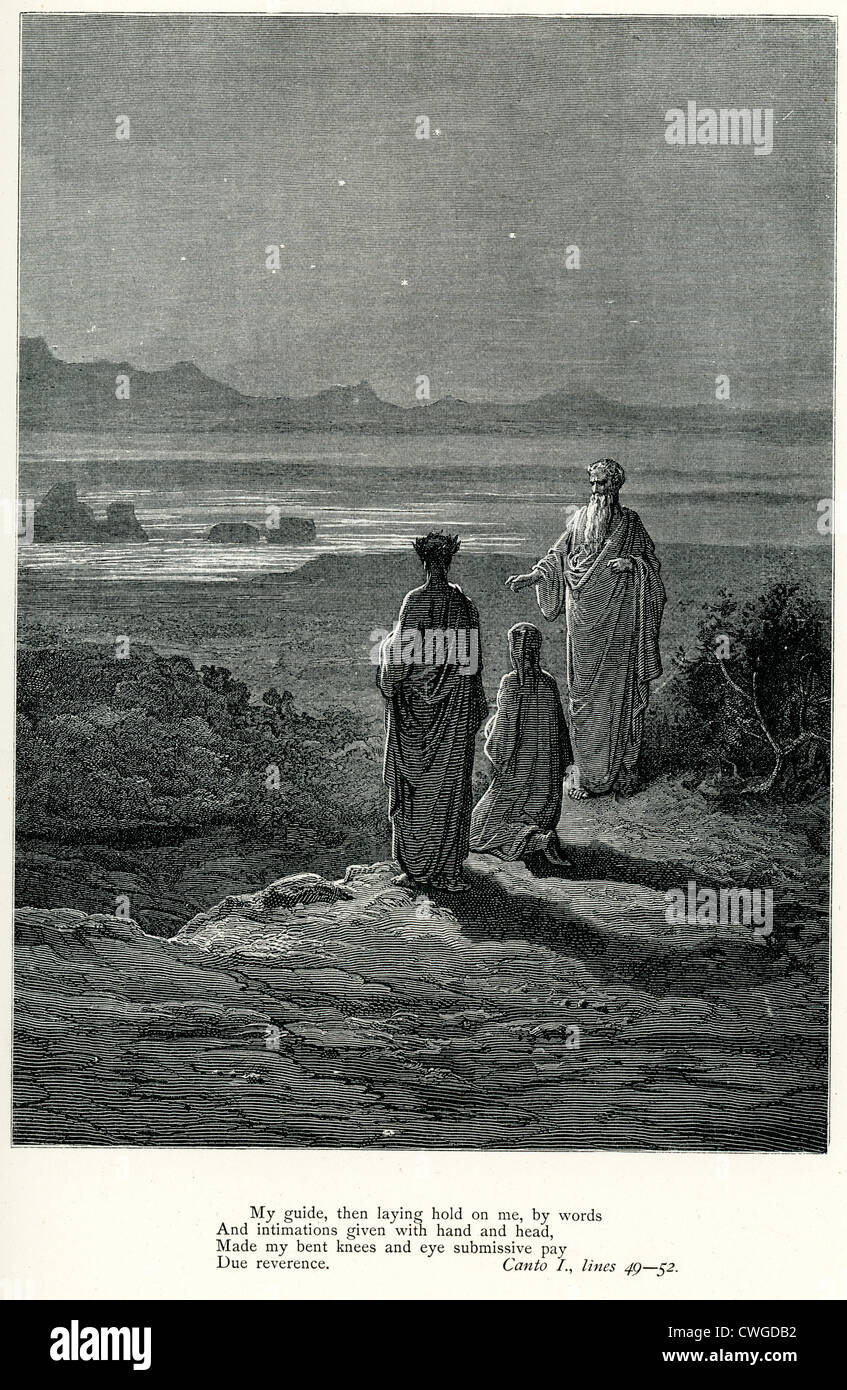 Illustration by Gustave Dore from The Vision of Purgatory and Paradise by Dante Alighieri Stock Photohttps://www.alamy.com/image-license-details/?v=1https://www.alamy.com/stock-photo-illustration-by-gustave-dore-from-the-vision-of-purgatory-and-paradise-50148870.html
Illustration by Gustave Dore from The Vision of Purgatory and Paradise by Dante Alighieri Stock Photohttps://www.alamy.com/image-license-details/?v=1https://www.alamy.com/stock-photo-illustration-by-gustave-dore-from-the-vision-of-purgatory-and-paradise-50148870.htmlRMCWGDB2–Illustration by Gustave Dore from The Vision of Purgatory and Paradise by Dante Alighieri
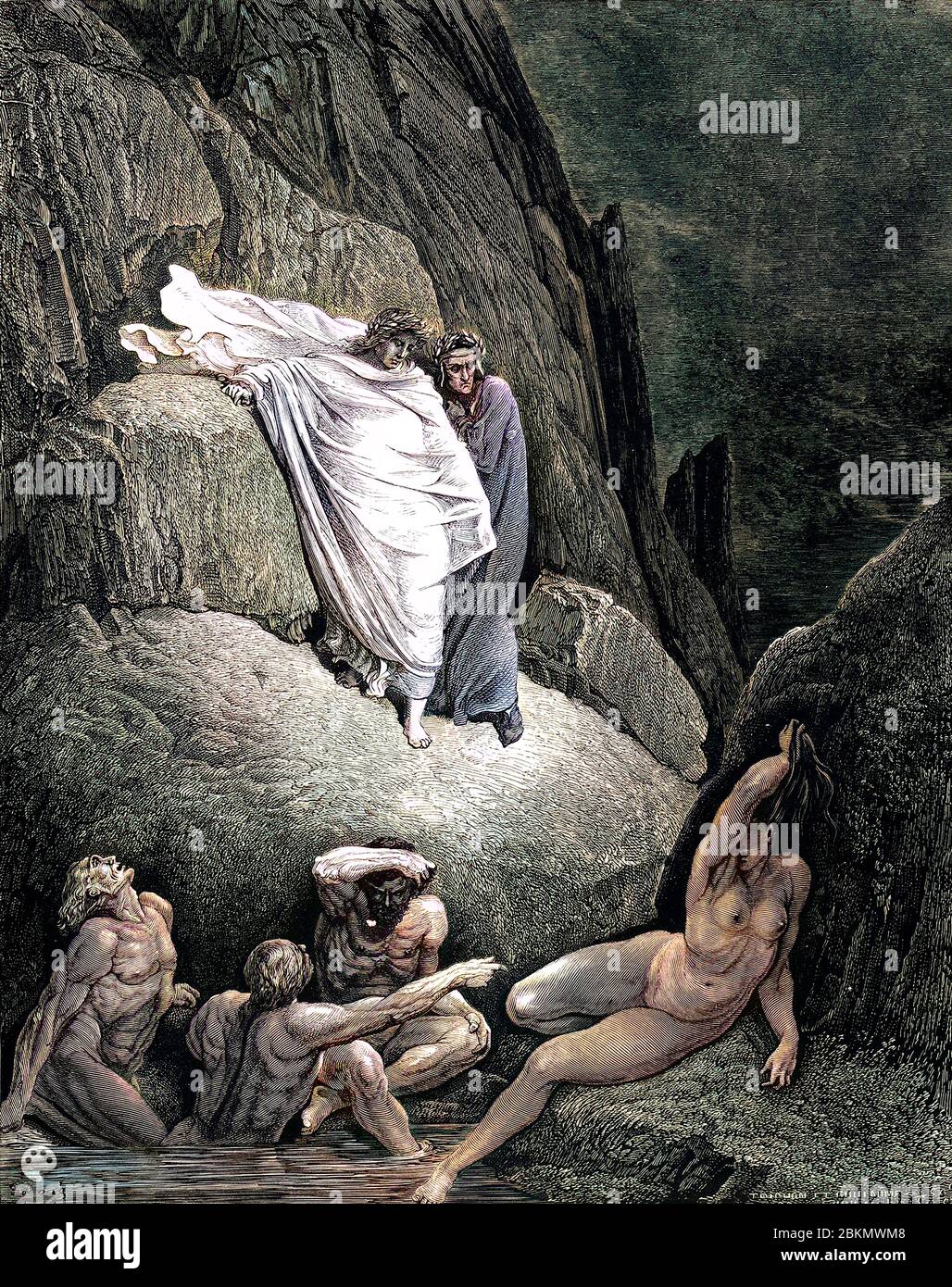 Machine colorized with Artificial Intelligence (AI) From the Divine Comedy by 14th century Italian poet Dante Alighieri. 1860 artwork, by French artist Gustave Dore and engraved by Stephane Pannemaker, from 'The Vision of Hell' (1868), Cary's English translation of the Inferno. Dante wrote his epic poem 'Divina Commedia' (The Divine Comedy) between 1308 and his death in 1321. Consisting of 14,233 lines, and divided into three parts (Inferno, Purgatorio, and Paradiso), it is considered the greatest literary work in the Italian language and a world masterpiece. It is a comprehensive survey of me Stock Photohttps://www.alamy.com/image-license-details/?v=1https://www.alamy.com/machine-colorized-with-artificial-intelligence-ai-from-the-divine-comedy-by-14th-century-italian-poet-dante-alighieri-1860-artwork-by-french-artist-gustave-dore-and-engraved-by-stephane-pannemaker-from-the-vision-of-hell-1868-carys-english-translation-of-the-inferno-dante-wrote-his-epic-poem-divina-commedia-the-divine-comedy-between-1308-and-his-death-in-1321-consisting-of-14233-lines-and-divided-into-three-parts-inferno-purgatorio-and-paradiso-it-is-considered-the-greatest-literary-work-in-the-italian-language-and-a-world-masterpiece-it-is-a-comprehensive-survey-of-me-image356345032.html
Machine colorized with Artificial Intelligence (AI) From the Divine Comedy by 14th century Italian poet Dante Alighieri. 1860 artwork, by French artist Gustave Dore and engraved by Stephane Pannemaker, from 'The Vision of Hell' (1868), Cary's English translation of the Inferno. Dante wrote his epic poem 'Divina Commedia' (The Divine Comedy) between 1308 and his death in 1321. Consisting of 14,233 lines, and divided into three parts (Inferno, Purgatorio, and Paradiso), it is considered the greatest literary work in the Italian language and a world masterpiece. It is a comprehensive survey of me Stock Photohttps://www.alamy.com/image-license-details/?v=1https://www.alamy.com/machine-colorized-with-artificial-intelligence-ai-from-the-divine-comedy-by-14th-century-italian-poet-dante-alighieri-1860-artwork-by-french-artist-gustave-dore-and-engraved-by-stephane-pannemaker-from-the-vision-of-hell-1868-carys-english-translation-of-the-inferno-dante-wrote-his-epic-poem-divina-commedia-the-divine-comedy-between-1308-and-his-death-in-1321-consisting-of-14233-lines-and-divided-into-three-parts-inferno-purgatorio-and-paradiso-it-is-considered-the-greatest-literary-work-in-the-italian-language-and-a-world-masterpiece-it-is-a-comprehensive-survey-of-me-image356345032.htmlRM2BKMWM8–Machine colorized with Artificial Intelligence (AI) From the Divine Comedy by 14th century Italian poet Dante Alighieri. 1860 artwork, by French artist Gustave Dore and engraved by Stephane Pannemaker, from 'The Vision of Hell' (1868), Cary's English translation of the Inferno. Dante wrote his epic poem 'Divina Commedia' (The Divine Comedy) between 1308 and his death in 1321. Consisting of 14,233 lines, and divided into three parts (Inferno, Purgatorio, and Paradiso), it is considered the greatest literary work in the Italian language and a world masterpiece. It is a comprehensive survey of me
 THE VISION OF THE SIXTH HEAVEN, BY GUSTAVE DORÉ. Dore, 1832 - 1883, French. Engraving for Paradiso by Dante. Wood engraving Stock Photohttps://www.alamy.com/image-license-details/?v=1https://www.alamy.com/stock-photo-the-vision-of-the-sixth-heaven-by-gustave-dor-dore-1832-1883-french-59996770.html
THE VISION OF THE SIXTH HEAVEN, BY GUSTAVE DORÉ. Dore, 1832 - 1883, French. Engraving for Paradiso by Dante. Wood engraving Stock Photohttps://www.alamy.com/image-license-details/?v=1https://www.alamy.com/stock-photo-the-vision-of-the-sixth-heaven-by-gustave-dor-dore-1832-1883-french-59996770.htmlRMDDH2DP–THE VISION OF THE SIXTH HEAVEN, BY GUSTAVE DORÉ. Dore, 1832 - 1883, French. Engraving for Paradiso by Dante. Wood engraving
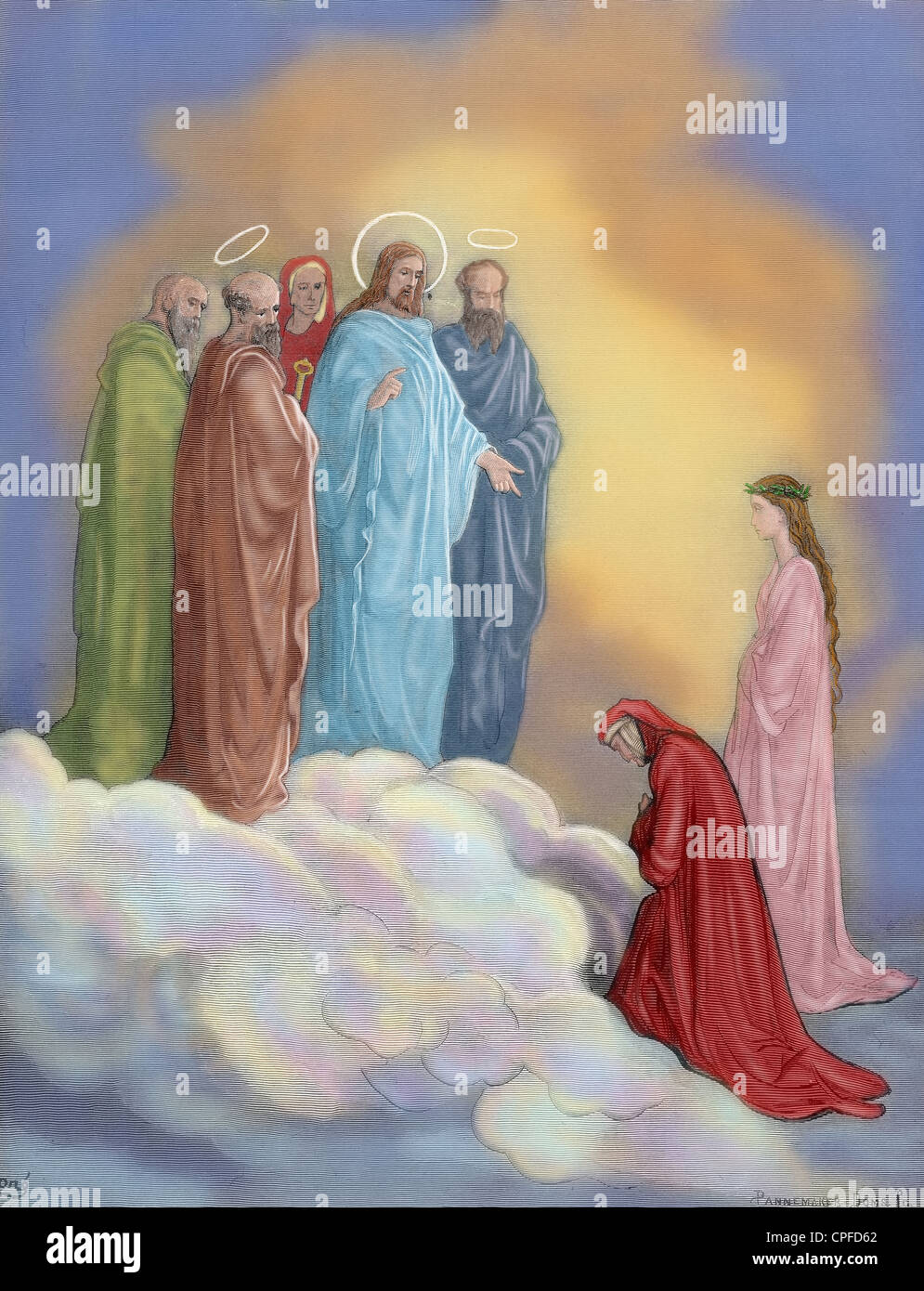 Divine Comedy. Paradise. XXVI Canto. St. John examines Dante concerning love. By Dore. Stock Photohttps://www.alamy.com/image-license-details/?v=1https://www.alamy.com/stock-photo-divine-comedy-paradise-xxvi-canto-st-john-examines-dante-concerning-48282810.html
Divine Comedy. Paradise. XXVI Canto. St. John examines Dante concerning love. By Dore. Stock Photohttps://www.alamy.com/image-license-details/?v=1https://www.alamy.com/stock-photo-divine-comedy-paradise-xxvi-canto-st-john-examines-dante-concerning-48282810.htmlRMCPFD62–Divine Comedy. Paradise. XXVI Canto. St. John examines Dante concerning love. By Dore.
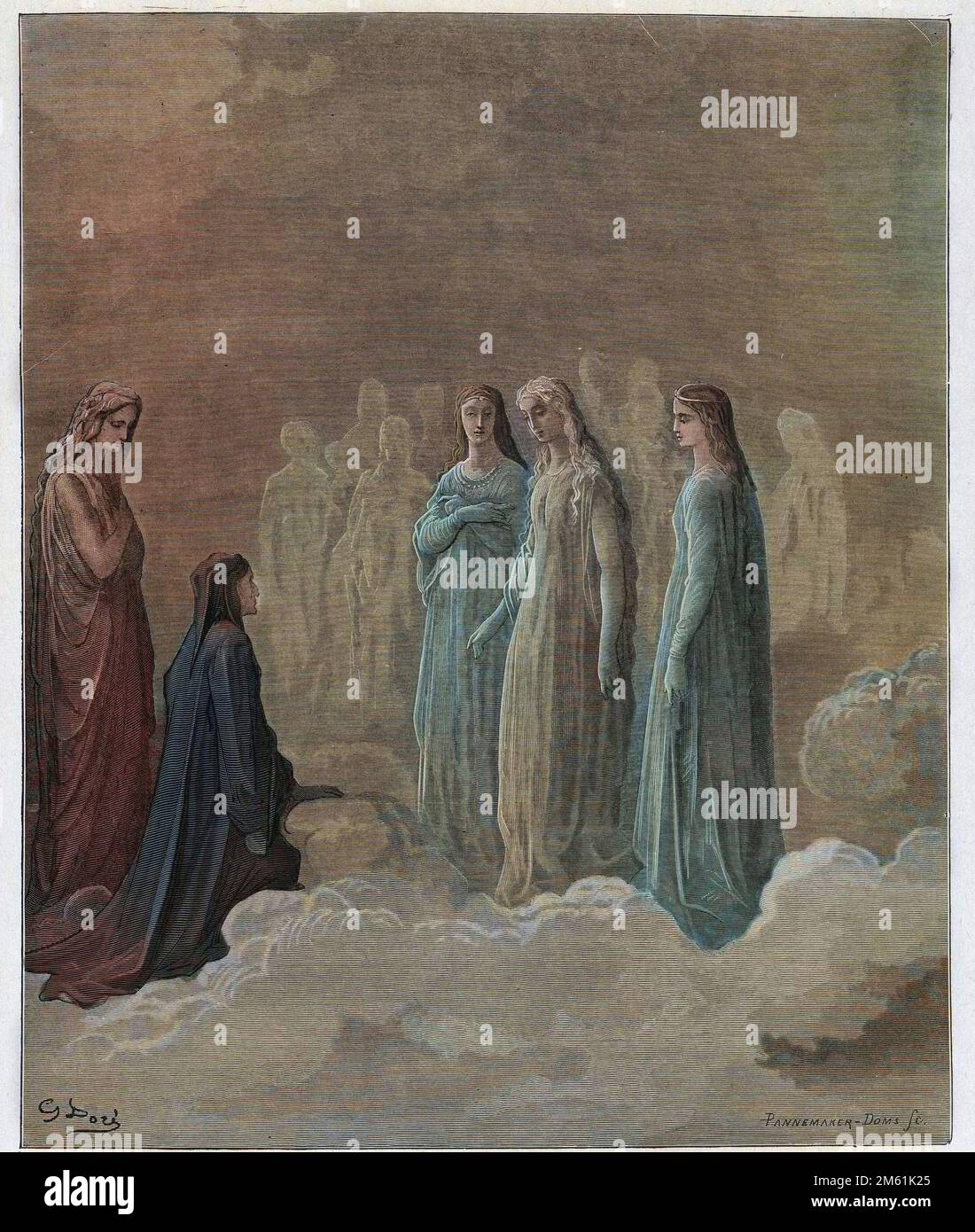 The Divine Comedy by Dante Alighieri , Paradiso, Canto 3 : The first realm : Piccarda Donati and the souls whose vows had been broken - by Dante Alighieri (1265-1321) - Illustration de Gustave Dore (1832-1883), 1885 - Colorisation digitale d'apres l'originale Stock Photohttps://www.alamy.com/image-license-details/?v=1https://www.alamy.com/the-divine-comedy-by-dante-alighieri-paradiso-canto-3-the-first-realm-piccarda-donati-and-the-souls-whose-vows-had-been-broken-by-dante-alighieri-1265-1321-illustration-de-gustave-dore-1832-1883-1885-colorisation-digitale-dapres-loriginale-image502825517.html
The Divine Comedy by Dante Alighieri , Paradiso, Canto 3 : The first realm : Piccarda Donati and the souls whose vows had been broken - by Dante Alighieri (1265-1321) - Illustration de Gustave Dore (1832-1883), 1885 - Colorisation digitale d'apres l'originale Stock Photohttps://www.alamy.com/image-license-details/?v=1https://www.alamy.com/the-divine-comedy-by-dante-alighieri-paradiso-canto-3-the-first-realm-piccarda-donati-and-the-souls-whose-vows-had-been-broken-by-dante-alighieri-1265-1321-illustration-de-gustave-dore-1832-1883-1885-colorisation-digitale-dapres-loriginale-image502825517.htmlRM2M61K25–The Divine Comedy by Dante Alighieri , Paradiso, Canto 3 : The first realm : Piccarda Donati and the souls whose vows had been broken - by Dante Alighieri (1265-1321) - Illustration de Gustave Dore (1832-1883), 1885 - Colorisation digitale d'apres l'originale
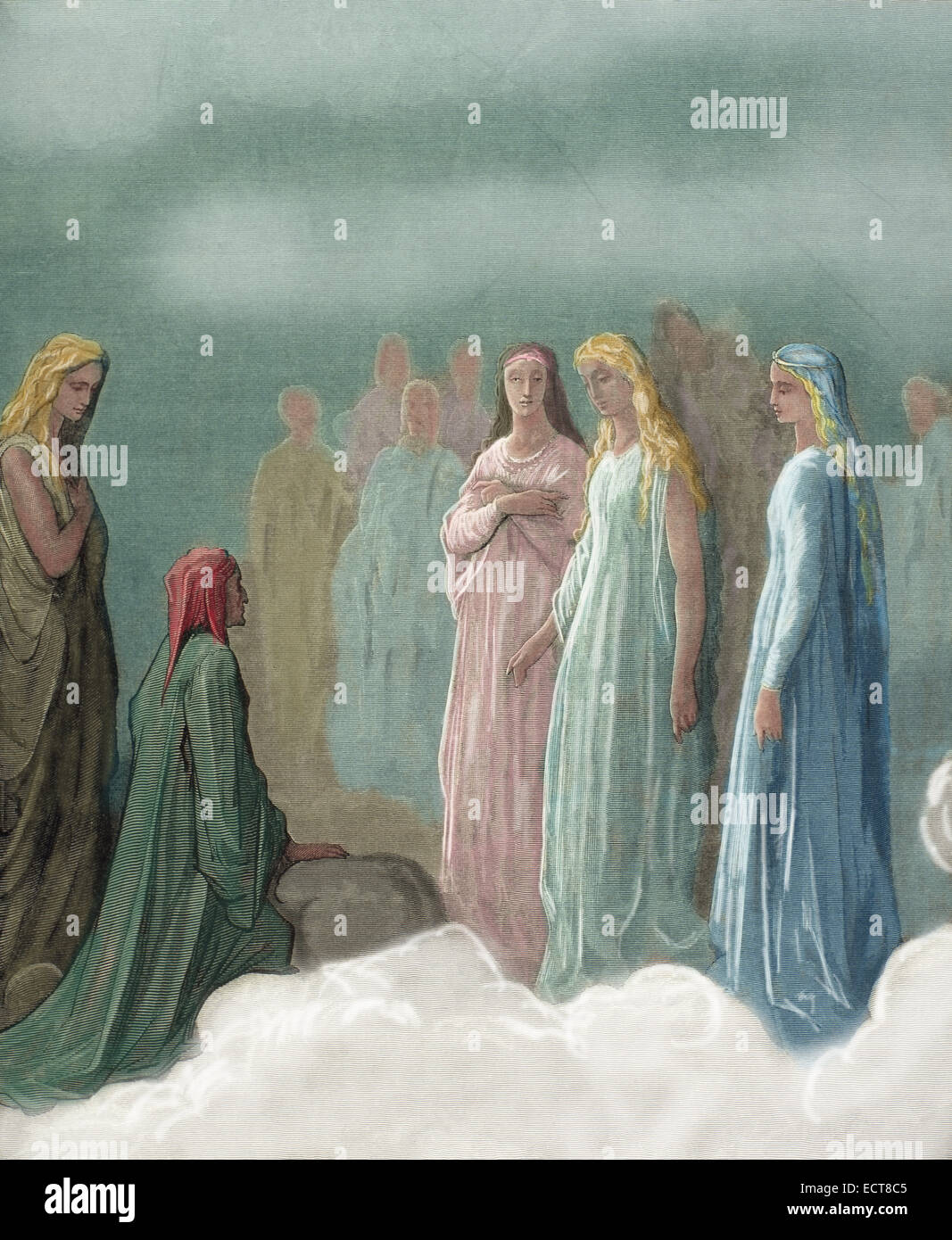 Divine Comedy. Epic poem written by Dante Alighieri (1265-1321) between 1308 and his death in 1321. Paradiso Canto III. Piccarda Donati and souls whose vows had been broken. Engraving by Gustave Dore, 1868. Colored. Stock Photohttps://www.alamy.com/image-license-details/?v=1https://www.alamy.com/stock-photo-divine-comedy-epic-poem-written-by-dante-alighieri-1265-1321-between-76750805.html
Divine Comedy. Epic poem written by Dante Alighieri (1265-1321) between 1308 and his death in 1321. Paradiso Canto III. Piccarda Donati and souls whose vows had been broken. Engraving by Gustave Dore, 1868. Colored. Stock Photohttps://www.alamy.com/image-license-details/?v=1https://www.alamy.com/stock-photo-divine-comedy-epic-poem-written-by-dante-alighieri-1265-1321-between-76750805.htmlRMECT8C5–Divine Comedy. Epic poem written by Dante Alighieri (1265-1321) between 1308 and his death in 1321. Paradiso Canto III. Piccarda Donati and souls whose vows had been broken. Engraving by Gustave Dore, 1868. Colored.
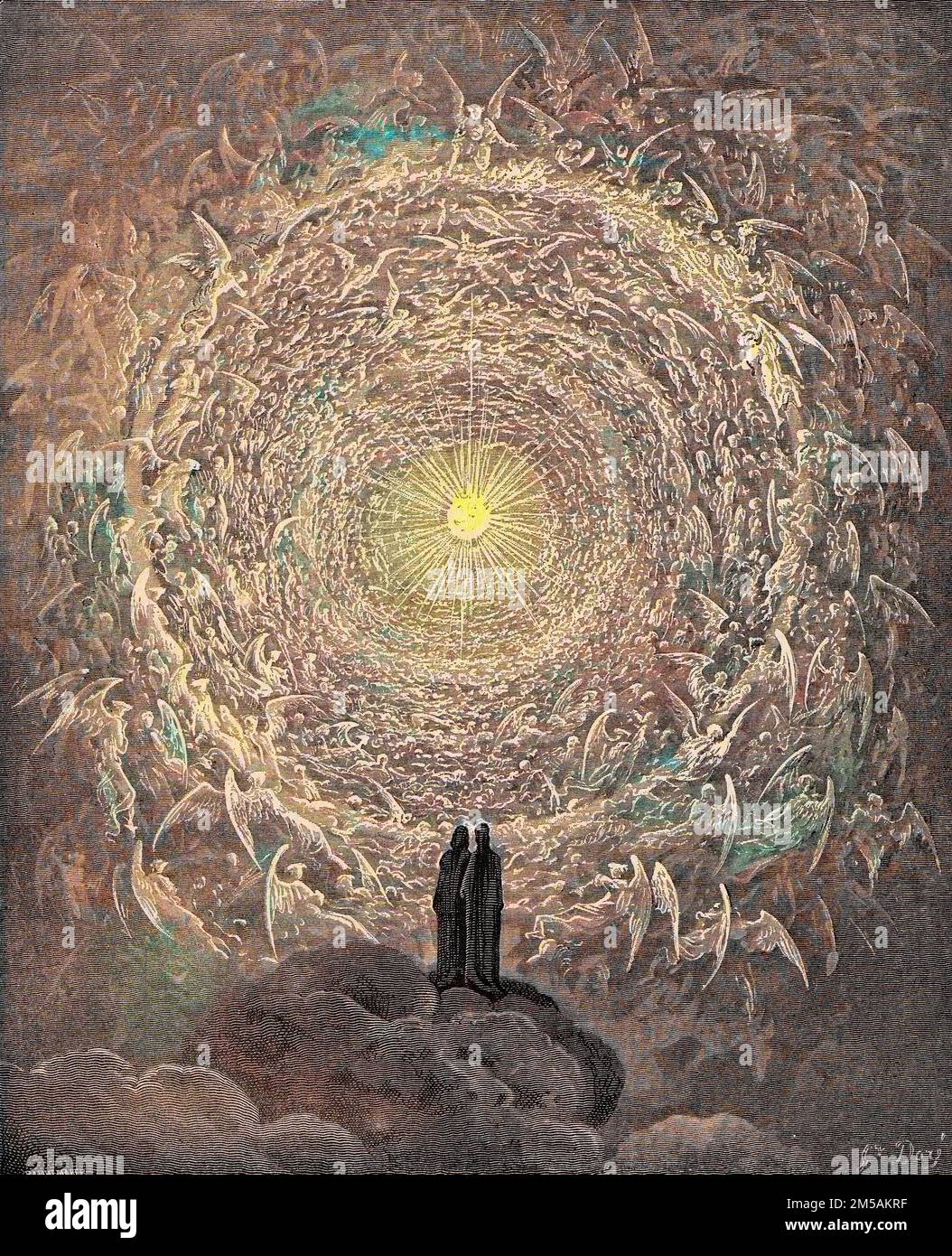 ROSA CELESTE - The Divine Comedy (La Divina Commedia, La Divine Comedie), Paradiso, Canto 31 : The saintly throng form a rose in the empyrean (rose celeste) - by Dante Alighieri (1265-1321) - Illustration de Gustave Dore (1832-1883), 1885 Stock Photohttps://www.alamy.com/image-license-details/?v=1https://www.alamy.com/rosa-celeste-the-divine-comedy-la-divina-commedia-la-divine-comedie-paradiso-canto-31-the-saintly-throng-form-a-rose-in-the-empyrean-rose-celeste-by-dante-alighieri-1265-1321-illustration-de-gustave-dore-1832-1883-1885-image502409027.html
ROSA CELESTE - The Divine Comedy (La Divina Commedia, La Divine Comedie), Paradiso, Canto 31 : The saintly throng form a rose in the empyrean (rose celeste) - by Dante Alighieri (1265-1321) - Illustration de Gustave Dore (1832-1883), 1885 Stock Photohttps://www.alamy.com/image-license-details/?v=1https://www.alamy.com/rosa-celeste-the-divine-comedy-la-divina-commedia-la-divine-comedie-paradiso-canto-31-the-saintly-throng-form-a-rose-in-the-empyrean-rose-celeste-by-dante-alighieri-1265-1321-illustration-de-gustave-dore-1832-1883-1885-image502409027.htmlRM2M5AKRF–ROSA CELESTE - The Divine Comedy (La Divina Commedia, La Divine Comedie), Paradiso, Canto 31 : The saintly throng form a rose in the empyrean (rose celeste) - by Dante Alighieri (1265-1321) - Illustration de Gustave Dore (1832-1883), 1885
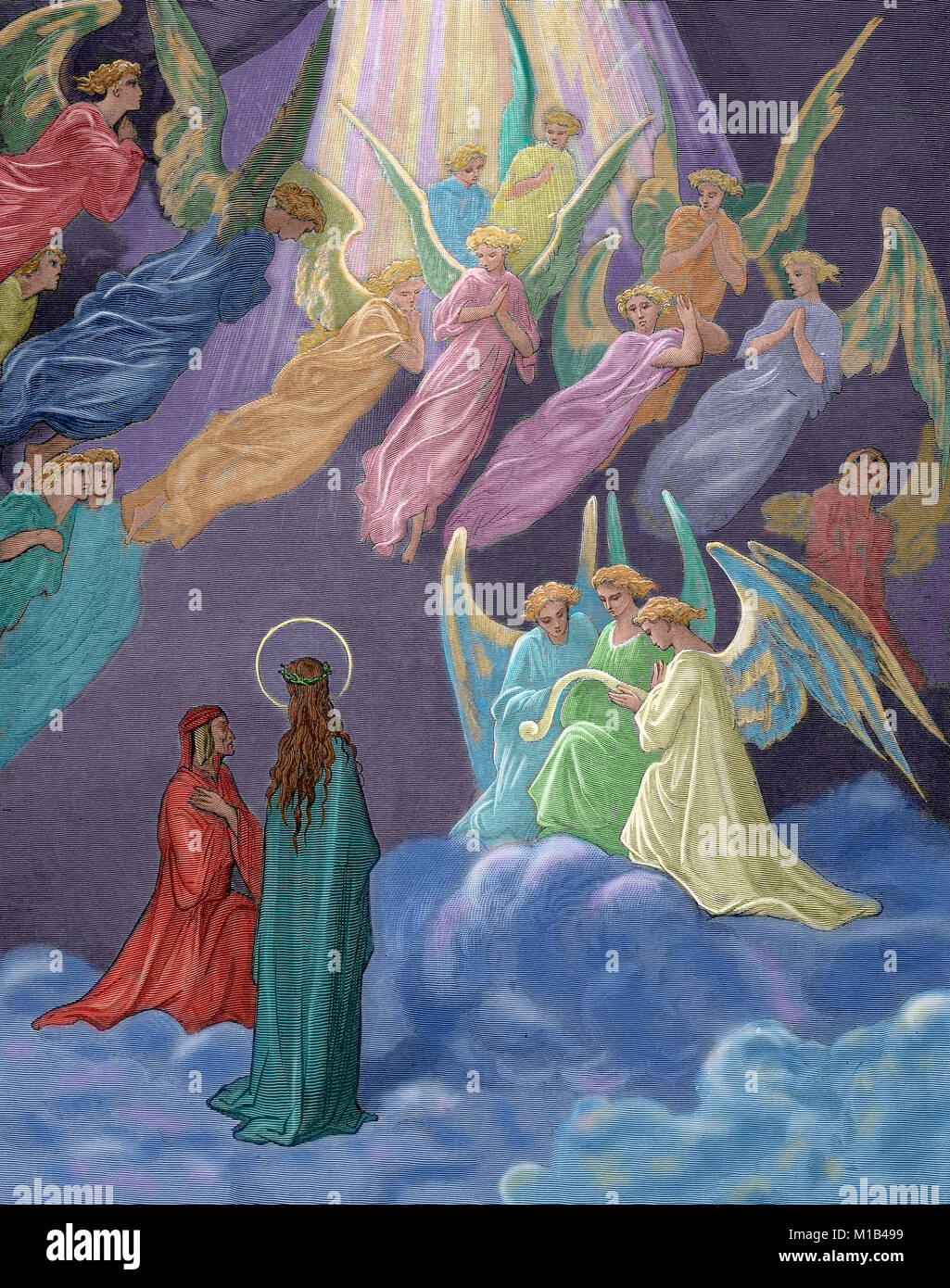 'Divine Comedy'. Epic poem written by Dante Alighieri between 1308 and his death in 1321. Paradise. XX Canto. The luminous souls sing. For that all those living lights, waxing in splendour, burst forth into songs, such as from memory glide and fall away. Engraving by Gustave Dore. Colored. Stock Photohttps://www.alamy.com/image-license-details/?v=1https://www.alamy.com/stock-photo-divine-comedy-epic-poem-written-by-dante-alighieri-between-1308-and-172963205.html
'Divine Comedy'. Epic poem written by Dante Alighieri between 1308 and his death in 1321. Paradise. XX Canto. The luminous souls sing. For that all those living lights, waxing in splendour, burst forth into songs, such as from memory glide and fall away. Engraving by Gustave Dore. Colored. Stock Photohttps://www.alamy.com/image-license-details/?v=1https://www.alamy.com/stock-photo-divine-comedy-epic-poem-written-by-dante-alighieri-between-1308-and-172963205.htmlRMM1B499–'Divine Comedy'. Epic poem written by Dante Alighieri between 1308 and his death in 1321. Paradise. XX Canto. The luminous souls sing. For that all those living lights, waxing in splendour, burst forth into songs, such as from memory glide and fall away. Engraving by Gustave Dore. Colored.
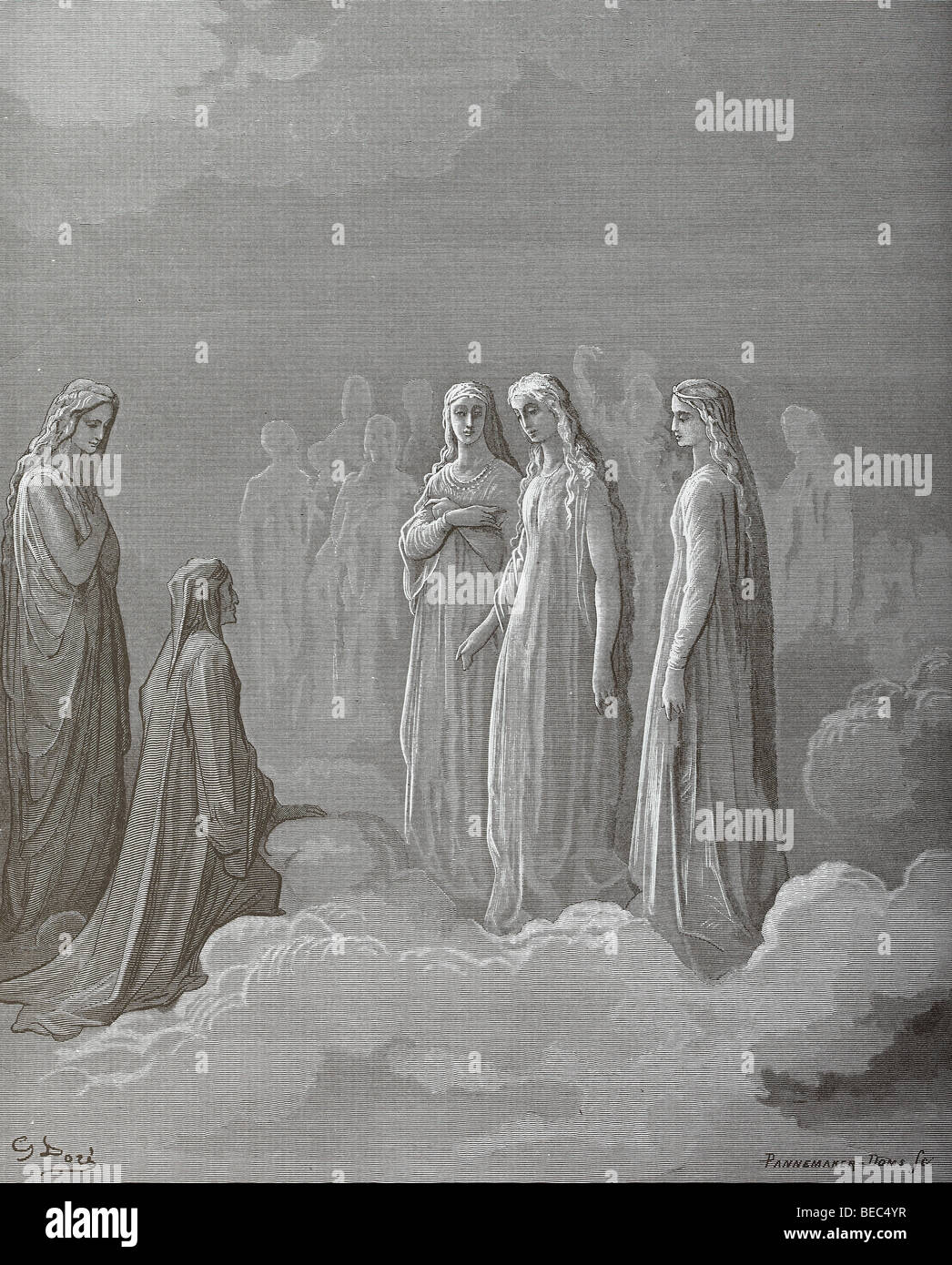 Gustave Dore's Illustration 'The Moon' from Dante's Divine Comedy Stock Photohttps://www.alamy.com/image-license-details/?v=1https://www.alamy.com/stock-photo-gustave-dores-illustration-the-moon-from-dantes-divine-comedy-26082891.html
Gustave Dore's Illustration 'The Moon' from Dante's Divine Comedy Stock Photohttps://www.alamy.com/image-license-details/?v=1https://www.alamy.com/stock-photo-gustave-dores-illustration-the-moon-from-dantes-divine-comedy-26082891.htmlRMBEC4YR–Gustave Dore's Illustration 'The Moon' from Dante's Divine Comedy
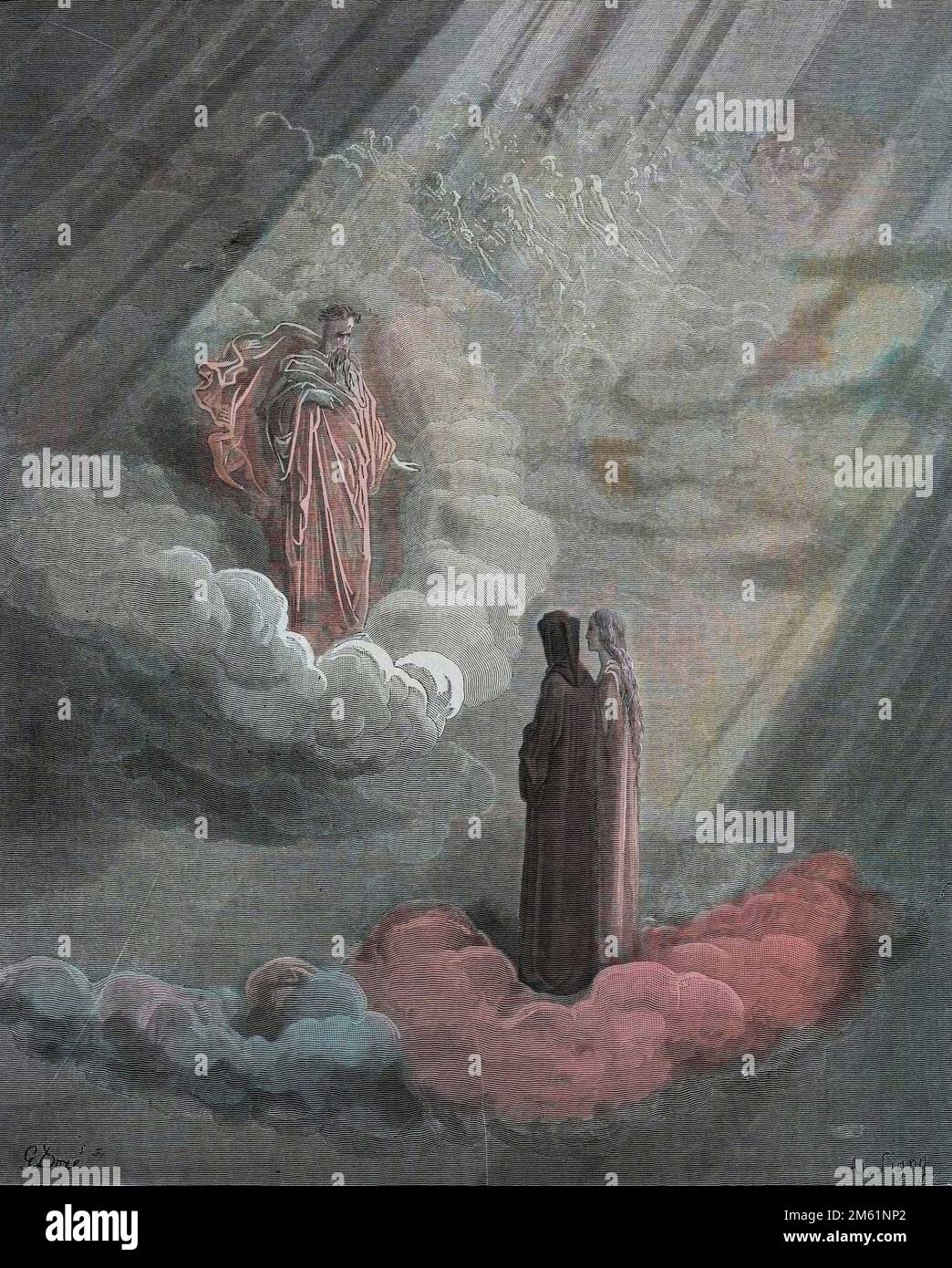 The Divine Comedy by Dante Alighieri , Paradiso, Canto 16 : The soul of Caddiaguida speaks of Florence - by Dante Alighieri (1265-1321) - Illustration de Gustave Dore (1832-1883), 1885 - Colorisation digitale d'apres l'originale Stock Photohttps://www.alamy.com/image-license-details/?v=1https://www.alamy.com/the-divine-comedy-by-dante-alighieri-paradiso-canto-16-the-soul-of-caddiaguida-speaks-of-florence-by-dante-alighieri-1265-1321-illustration-de-gustave-dore-1832-1883-1885-colorisation-digitale-dapres-loriginale-image502827642.html
The Divine Comedy by Dante Alighieri , Paradiso, Canto 16 : The soul of Caddiaguida speaks of Florence - by Dante Alighieri (1265-1321) - Illustration de Gustave Dore (1832-1883), 1885 - Colorisation digitale d'apres l'originale Stock Photohttps://www.alamy.com/image-license-details/?v=1https://www.alamy.com/the-divine-comedy-by-dante-alighieri-paradiso-canto-16-the-soul-of-caddiaguida-speaks-of-florence-by-dante-alighieri-1265-1321-illustration-de-gustave-dore-1832-1883-1885-colorisation-digitale-dapres-loriginale-image502827642.htmlRM2M61NP2–The Divine Comedy by Dante Alighieri , Paradiso, Canto 16 : The soul of Caddiaguida speaks of Florence - by Dante Alighieri (1265-1321) - Illustration de Gustave Dore (1832-1883), 1885 - Colorisation digitale d'apres l'originale
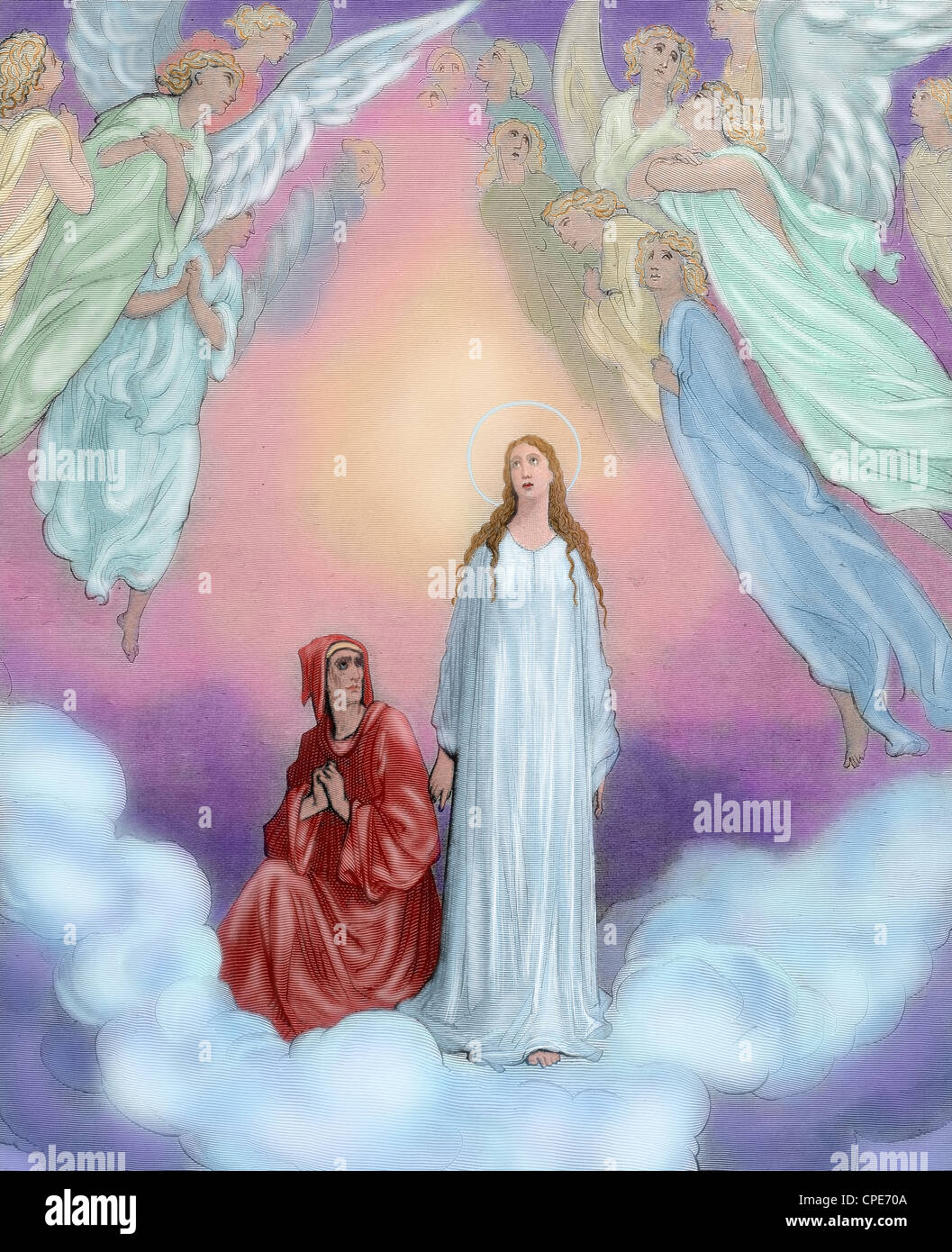 Divine Comedy. Paradise. XXI Canto. Dante ascends with Beatrice to the seventh heaven, which is the planet Saturn. By Dore. Stock Photohttps://www.alamy.com/image-license-details/?v=1https://www.alamy.com/stock-photo-divine-comedy-paradise-xxi-canto-dante-ascends-with-beatrice-to-the-48255994.html
Divine Comedy. Paradise. XXI Canto. Dante ascends with Beatrice to the seventh heaven, which is the planet Saturn. By Dore. Stock Photohttps://www.alamy.com/image-license-details/?v=1https://www.alamy.com/stock-photo-divine-comedy-paradise-xxi-canto-dante-ascends-with-beatrice-to-the-48255994.htmlRMCPE70A–Divine Comedy. Paradise. XXI Canto. Dante ascends with Beatrice to the seventh heaven, which is the planet Saturn. By Dore.
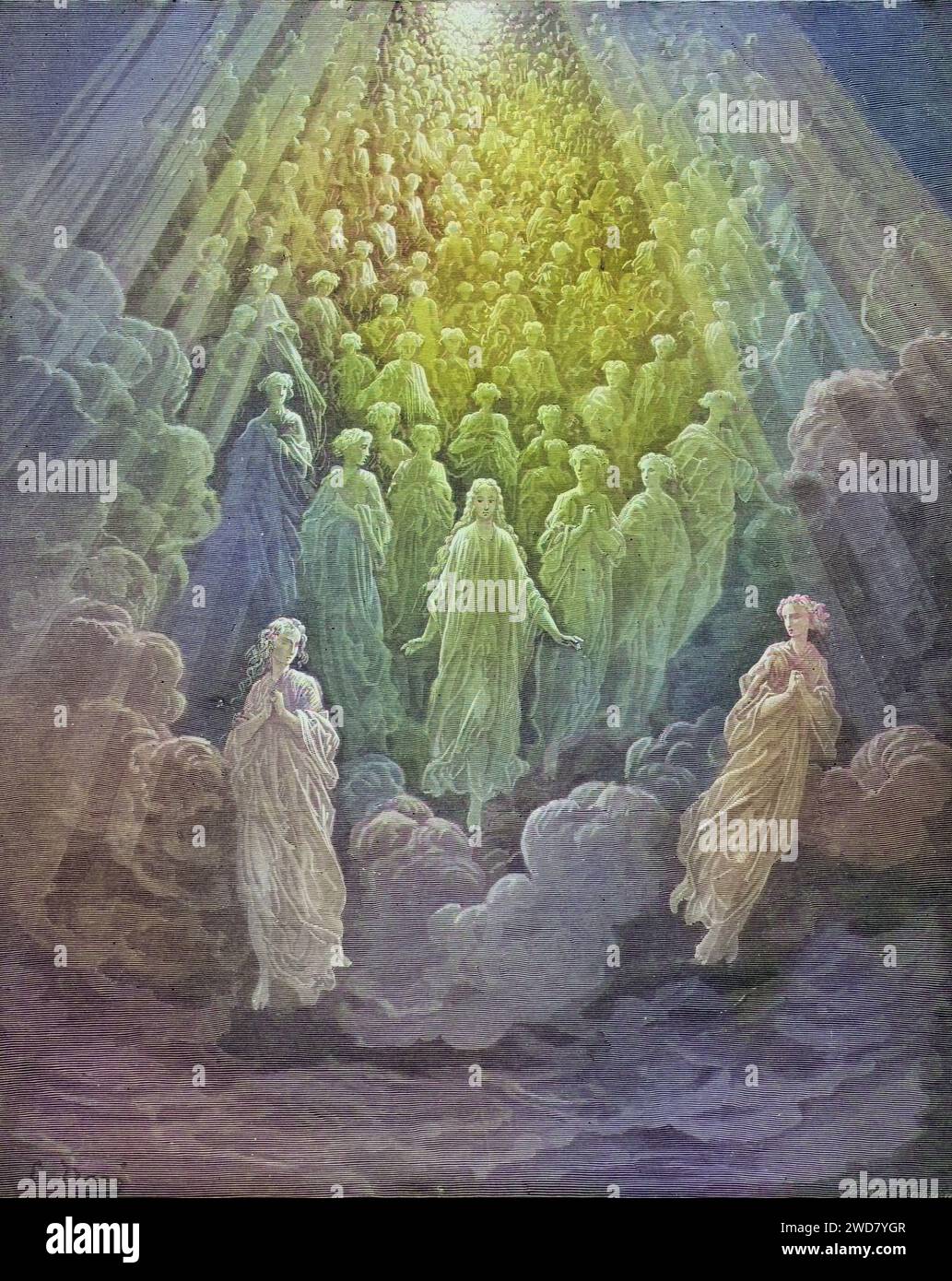 Illustration für Paradiso, die Göttliche Komödie von Dante Alighieri Canto von Gustave Dore 1832-1883, französischer Künstler, Inferno, Hölle, Paradies, Engel, Verdammnis, Historisch, digital restaurierte Reproduktion von einer Vorlage aus dem 19. Jahrhundert, Record date not stated Stock Photohttps://www.alamy.com/image-license-details/?v=1https://www.alamy.com/illustration-fr-paradiso-die-gttliche-komdie-von-dante-alighieri-canto-von-gustave-dore-1832-1883-franzsischer-knstler-inferno-hlle-paradies-engel-verdammnis-historisch-digital-restaurierte-reproduktion-von-einer-vorlage-aus-dem-19-jahrhundert-record-date-not-stated-image593318343.html
Illustration für Paradiso, die Göttliche Komödie von Dante Alighieri Canto von Gustave Dore 1832-1883, französischer Künstler, Inferno, Hölle, Paradies, Engel, Verdammnis, Historisch, digital restaurierte Reproduktion von einer Vorlage aus dem 19. Jahrhundert, Record date not stated Stock Photohttps://www.alamy.com/image-license-details/?v=1https://www.alamy.com/illustration-fr-paradiso-die-gttliche-komdie-von-dante-alighieri-canto-von-gustave-dore-1832-1883-franzsischer-knstler-inferno-hlle-paradies-engel-verdammnis-historisch-digital-restaurierte-reproduktion-von-einer-vorlage-aus-dem-19-jahrhundert-record-date-not-stated-image593318343.htmlRF2WD7YGR–Illustration für Paradiso, die Göttliche Komödie von Dante Alighieri Canto von Gustave Dore 1832-1883, französischer Künstler, Inferno, Hölle, Paradies, Engel, Verdammnis, Historisch, digital restaurierte Reproduktion von einer Vorlage aus dem 19. Jahrhundert, Record date not stated
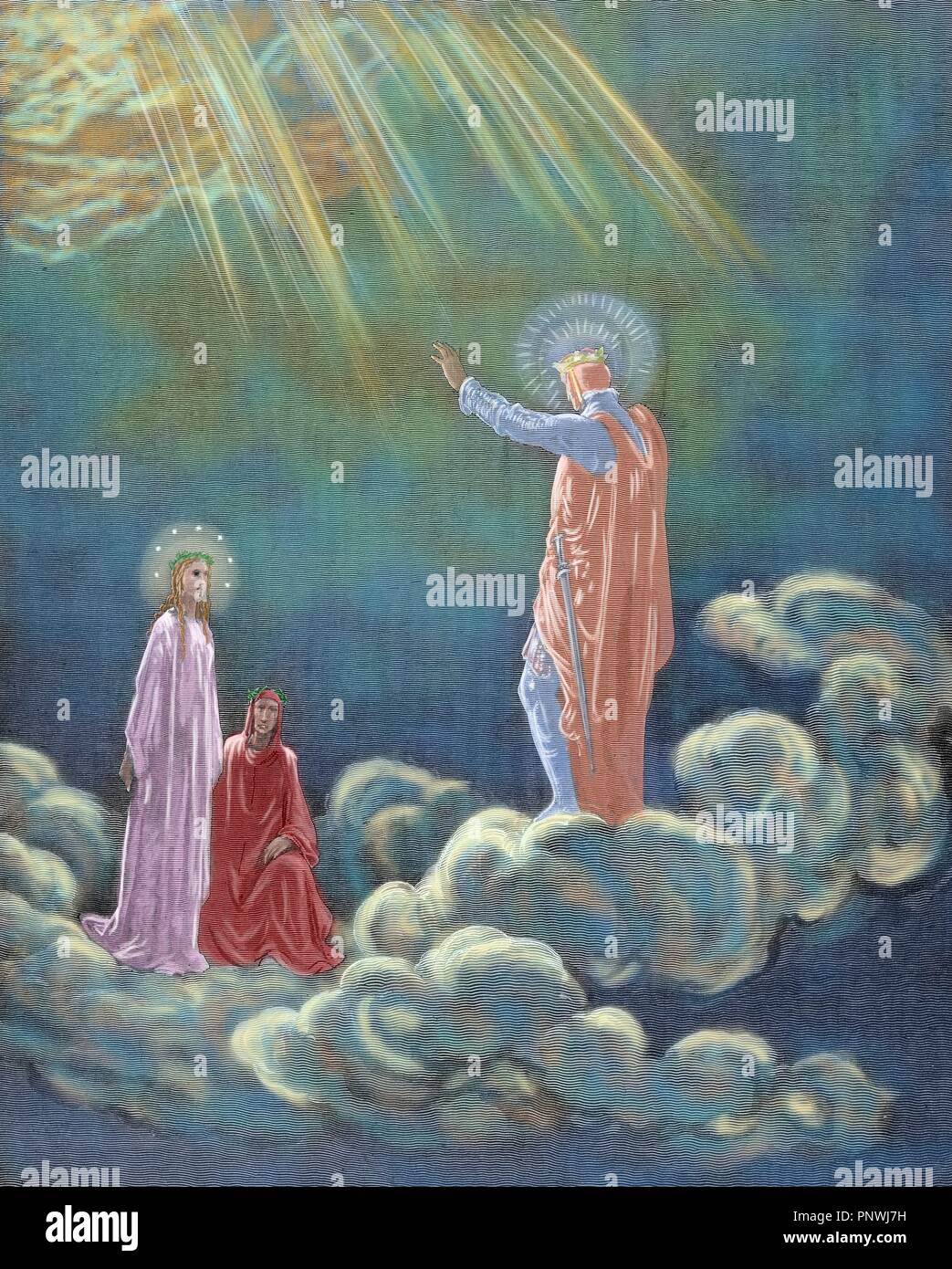 Divine Comedy. Epic poem written by Dante Alighieri between 1308 and his death in 1321. Paradise. Eight Canto. Charles Martel addresses Dante and Beatrice. Engraving by Gustave Dore. Colored. Stock Photohttps://www.alamy.com/image-license-details/?v=1https://www.alamy.com/divine-comedy-epic-poem-written-by-dante-alighieri-between-1308-and-his-death-in-1321-paradise-eight-canto-charles-martel-addresses-dante-and-beatrice-engraving-by-gustave-dore-colored-image219995317.html
Divine Comedy. Epic poem written by Dante Alighieri between 1308 and his death in 1321. Paradise. Eight Canto. Charles Martel addresses Dante and Beatrice. Engraving by Gustave Dore. Colored. Stock Photohttps://www.alamy.com/image-license-details/?v=1https://www.alamy.com/divine-comedy-epic-poem-written-by-dante-alighieri-between-1308-and-his-death-in-1321-paradise-eight-canto-charles-martel-addresses-dante-and-beatrice-engraving-by-gustave-dore-colored-image219995317.htmlRMPNWJ7H–Divine Comedy. Epic poem written by Dante Alighieri between 1308 and his death in 1321. Paradise. Eight Canto. Charles Martel addresses Dante and Beatrice. Engraving by Gustave Dore. Colored.
 The Heavenly Choir, by Gustave Doré, 1832 - 1883, French. Engraving for Paradiso by Dante. 1870, Art, Artist reimagined Stock Photohttps://www.alamy.com/image-license-details/?v=1https://www.alamy.com/the-heavenly-choir-by-gustave-dor-1832-1883-french-engraving-for-paradiso-by-dante-1870-art-artist-reimagined-image230058712.html
The Heavenly Choir, by Gustave Doré, 1832 - 1883, French. Engraving for Paradiso by Dante. 1870, Art, Artist reimagined Stock Photohttps://www.alamy.com/image-license-details/?v=1https://www.alamy.com/the-heavenly-choir-by-gustave-dor-1832-1883-french-engraving-for-paradiso-by-dante-1870-art-artist-reimagined-image230058712.htmlRFRA826G–The Heavenly Choir, by Gustave Doré, 1832 - 1883, French. Engraving for Paradiso by Dante. 1870, Art, Artist reimagined
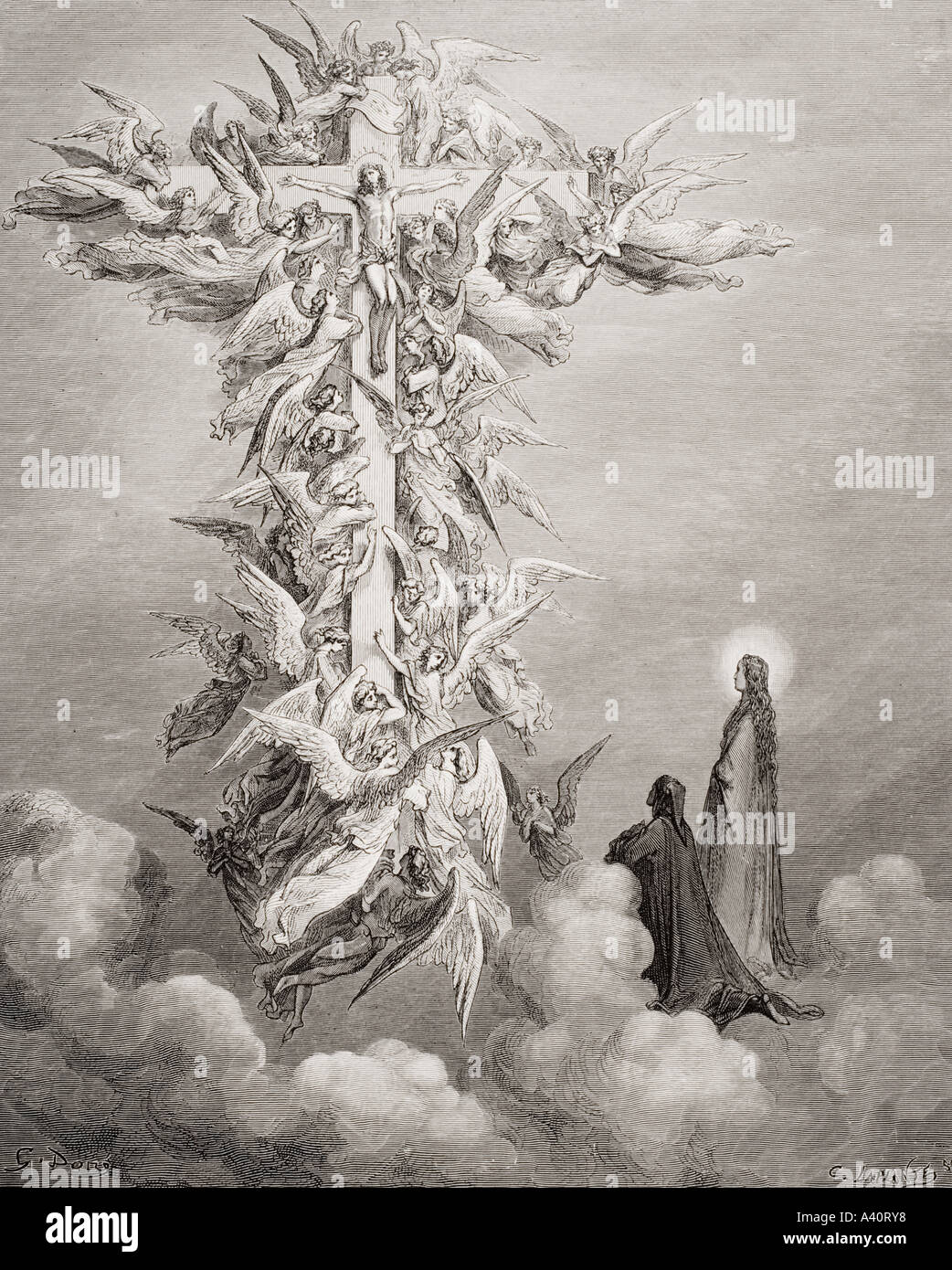 Illustration for Paradiso by Dante Alighieri, Canto XIV lines 96 and 97 by Gustave Dore, 1832 - 1883. French artist and illustrator. Stock Photohttps://www.alamy.com/image-license-details/?v=1https://www.alamy.com/illustration-for-paradiso-by-dante-alighieri-canto-xiv-lines-96-and-image6226423.html
Illustration for Paradiso by Dante Alighieri, Canto XIV lines 96 and 97 by Gustave Dore, 1832 - 1883. French artist and illustrator. Stock Photohttps://www.alamy.com/image-license-details/?v=1https://www.alamy.com/illustration-for-paradiso-by-dante-alighieri-canto-xiv-lines-96-and-image6226423.htmlRMA40RY8–Illustration for Paradiso by Dante Alighieri, Canto XIV lines 96 and 97 by Gustave Dore, 1832 - 1883. French artist and illustrator.
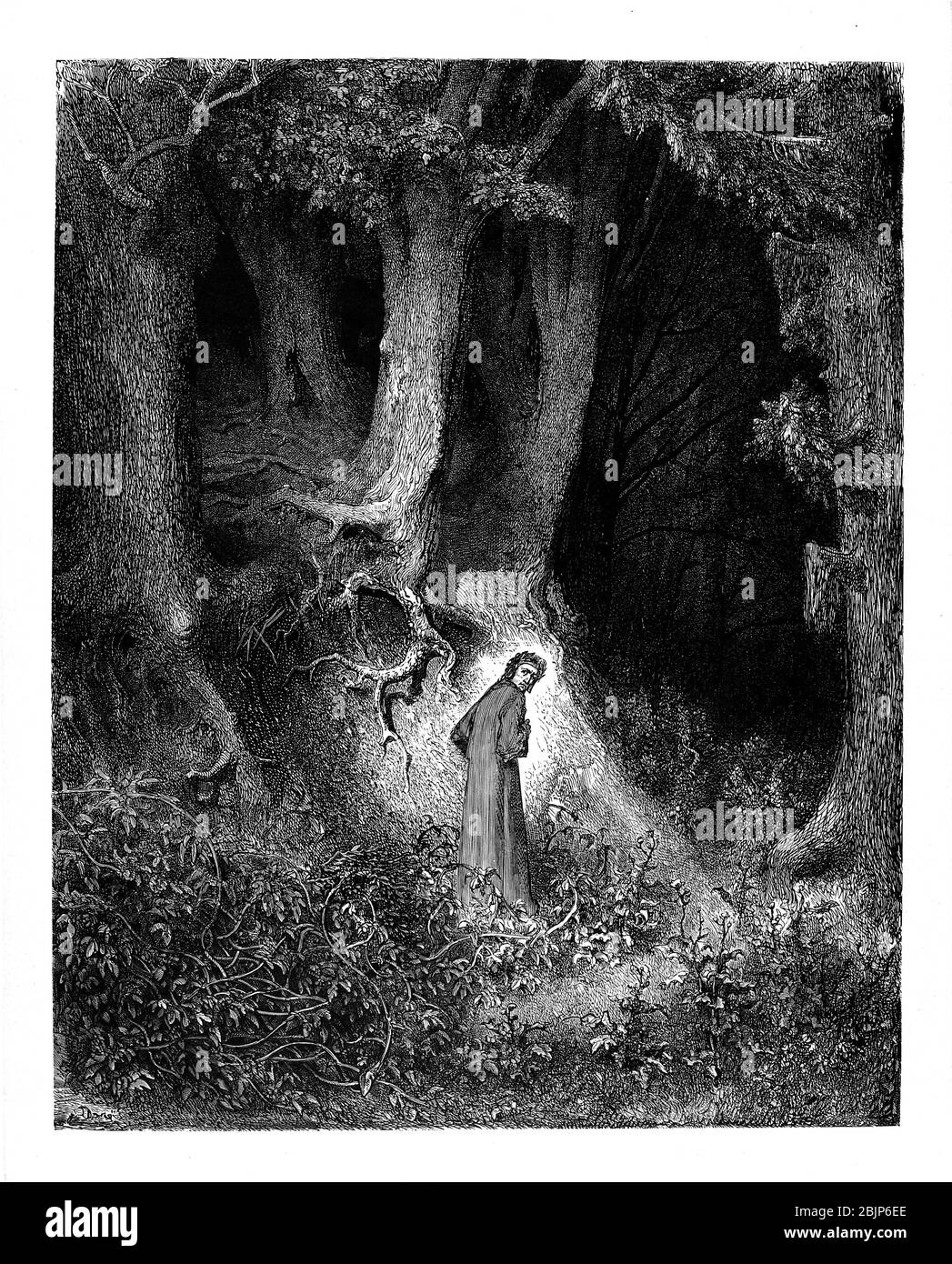 The Dark forest From the Divine Comedy by 14th century Italian poet Dante Alighieri. 1860 artwork, by French artist Gustave Dore and engraved by Stephane Pannemaker, from 'The Vision of Hell' (1868), Cary's English translation of the Inferno. Dante wrote his epic poem 'Divina Commedia' (The Divine Comedy) between 1308 and his death in 1321. Consisting of 14,233 lines, and divided into three parts (Inferno, Purgatorio, and Paradiso), it is considered the greatest literary work in the Italian language and a world masterpiece. It is a comprehensive survey of medieval theology, literature and thou Stock Photohttps://www.alamy.com/image-license-details/?v=1https://www.alamy.com/the-dark-forest-from-the-divine-comedy-by-14th-century-italian-poet-dante-alighieri-1860-artwork-by-french-artist-gustave-dore-and-engraved-by-stephane-pannemaker-from-the-vision-of-hell-1868-carys-english-translation-of-the-inferno-dante-wrote-his-epic-poem-divina-commedia-the-divine-comedy-between-1308-and-his-death-in-1321-consisting-of-14233-lines-and-divided-into-three-parts-inferno-purgatorio-and-paradiso-it-is-considered-the-greatest-literary-work-in-the-italian-language-and-a-world-masterpiece-it-is-a-comprehensive-survey-of-medieval-theology-literature-and-thou-image355759222.html
The Dark forest From the Divine Comedy by 14th century Italian poet Dante Alighieri. 1860 artwork, by French artist Gustave Dore and engraved by Stephane Pannemaker, from 'The Vision of Hell' (1868), Cary's English translation of the Inferno. Dante wrote his epic poem 'Divina Commedia' (The Divine Comedy) between 1308 and his death in 1321. Consisting of 14,233 lines, and divided into three parts (Inferno, Purgatorio, and Paradiso), it is considered the greatest literary work in the Italian language and a world masterpiece. It is a comprehensive survey of medieval theology, literature and thou Stock Photohttps://www.alamy.com/image-license-details/?v=1https://www.alamy.com/the-dark-forest-from-the-divine-comedy-by-14th-century-italian-poet-dante-alighieri-1860-artwork-by-french-artist-gustave-dore-and-engraved-by-stephane-pannemaker-from-the-vision-of-hell-1868-carys-english-translation-of-the-inferno-dante-wrote-his-epic-poem-divina-commedia-the-divine-comedy-between-1308-and-his-death-in-1321-consisting-of-14233-lines-and-divided-into-three-parts-inferno-purgatorio-and-paradiso-it-is-considered-the-greatest-literary-work-in-the-italian-language-and-a-world-masterpiece-it-is-a-comprehensive-survey-of-medieval-theology-literature-and-thou-image355759222.htmlRM2BJP6EE–The Dark forest From the Divine Comedy by 14th century Italian poet Dante Alighieri. 1860 artwork, by French artist Gustave Dore and engraved by Stephane Pannemaker, from 'The Vision of Hell' (1868), Cary's English translation of the Inferno. Dante wrote his epic poem 'Divina Commedia' (The Divine Comedy) between 1308 and his death in 1321. Consisting of 14,233 lines, and divided into three parts (Inferno, Purgatorio, and Paradiso), it is considered the greatest literary work in the Italian language and a world masterpiece. It is a comprehensive survey of medieval theology, literature and thou
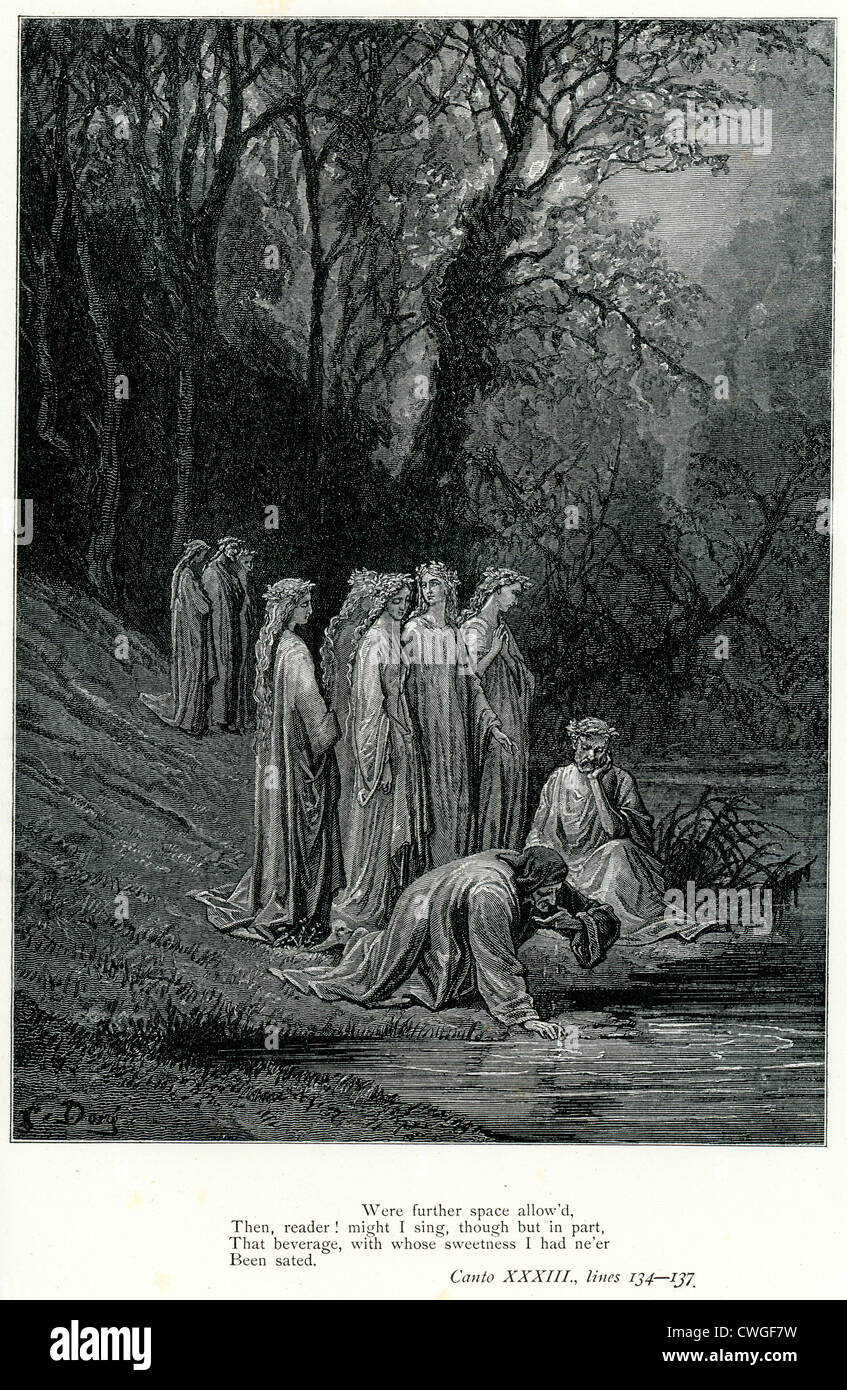 Illustration by Gustave Dore from The Vision of Purgatory and Paradise by Dante Alighieri Stock Photohttps://www.alamy.com/image-license-details/?v=1https://www.alamy.com/stock-photo-illustration-by-gustave-dore-from-the-vision-of-purgatory-and-paradise-50150349.html
Illustration by Gustave Dore from The Vision of Purgatory and Paradise by Dante Alighieri Stock Photohttps://www.alamy.com/image-license-details/?v=1https://www.alamy.com/stock-photo-illustration-by-gustave-dore-from-the-vision-of-purgatory-and-paradise-50150349.htmlRMCWGF7W–Illustration by Gustave Dore from The Vision of Purgatory and Paradise by Dante Alighieri
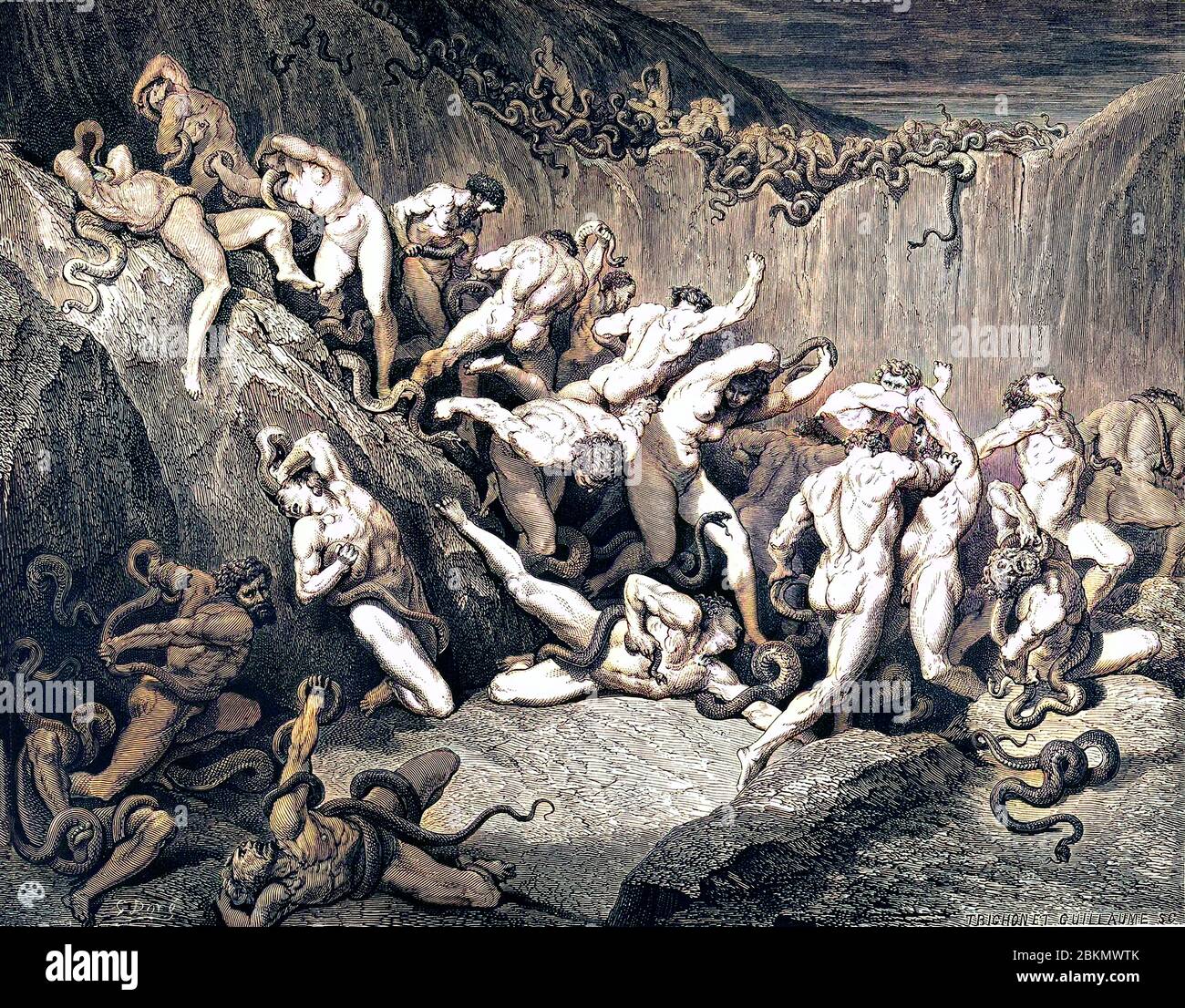 Machine colorized with Artificial Intelligence (AI) From the Divine Comedy by 14th century Italian poet Dante Alighieri. 1860 artwork, by French artist Gustave Dore and engraved by Stephane Pannemaker, from 'The Vision of Hell' (1868), Cary's English translation of the Inferno. Dante wrote his epic poem 'Divina Commedia' (The Divine Comedy) between 1308 and his death in 1321. Consisting of 14,233 lines, and divided into three parts (Inferno, Purgatorio, and Paradiso), it is considered the greatest literary work in the Italian language and a world masterpiece. It is a comprehensive survey of me Stock Photohttps://www.alamy.com/image-license-details/?v=1https://www.alamy.com/machine-colorized-with-artificial-intelligence-ai-from-the-divine-comedy-by-14th-century-italian-poet-dante-alighieri-1860-artwork-by-french-artist-gustave-dore-and-engraved-by-stephane-pannemaker-from-the-vision-of-hell-1868-carys-english-translation-of-the-inferno-dante-wrote-his-epic-poem-divina-commedia-the-divine-comedy-between-1308-and-his-death-in-1321-consisting-of-14233-lines-and-divided-into-three-parts-inferno-purgatorio-and-paradiso-it-is-considered-the-greatest-literary-work-in-the-italian-language-and-a-world-masterpiece-it-is-a-comprehensive-survey-of-me-image356345155.html
Machine colorized with Artificial Intelligence (AI) From the Divine Comedy by 14th century Italian poet Dante Alighieri. 1860 artwork, by French artist Gustave Dore and engraved by Stephane Pannemaker, from 'The Vision of Hell' (1868), Cary's English translation of the Inferno. Dante wrote his epic poem 'Divina Commedia' (The Divine Comedy) between 1308 and his death in 1321. Consisting of 14,233 lines, and divided into three parts (Inferno, Purgatorio, and Paradiso), it is considered the greatest literary work in the Italian language and a world masterpiece. It is a comprehensive survey of me Stock Photohttps://www.alamy.com/image-license-details/?v=1https://www.alamy.com/machine-colorized-with-artificial-intelligence-ai-from-the-divine-comedy-by-14th-century-italian-poet-dante-alighieri-1860-artwork-by-french-artist-gustave-dore-and-engraved-by-stephane-pannemaker-from-the-vision-of-hell-1868-carys-english-translation-of-the-inferno-dante-wrote-his-epic-poem-divina-commedia-the-divine-comedy-between-1308-and-his-death-in-1321-consisting-of-14233-lines-and-divided-into-three-parts-inferno-purgatorio-and-paradiso-it-is-considered-the-greatest-literary-work-in-the-italian-language-and-a-world-masterpiece-it-is-a-comprehensive-survey-of-me-image356345155.htmlRM2BKMWTK–Machine colorized with Artificial Intelligence (AI) From the Divine Comedy by 14th century Italian poet Dante Alighieri. 1860 artwork, by French artist Gustave Dore and engraved by Stephane Pannemaker, from 'The Vision of Hell' (1868), Cary's English translation of the Inferno. Dante wrote his epic poem 'Divina Commedia' (The Divine Comedy) between 1308 and his death in 1321. Consisting of 14,233 lines, and divided into three parts (Inferno, Purgatorio, and Paradiso), it is considered the greatest literary work in the Italian language and a world masterpiece. It is a comprehensive survey of me
 THE HEAVENLY CHOIR, BY GUSTAVE DORÉ. Gustave Dore, 1832 - 1883, French. Engraving for Paradiso by Dante. 1870, Art, Artist Stock Photohttps://www.alamy.com/image-license-details/?v=1https://www.alamy.com/stock-photo-the-heavenly-choir-by-gustave-dor-gustave-dore-1832-1883-french-engraving-59997402.html
THE HEAVENLY CHOIR, BY GUSTAVE DORÉ. Gustave Dore, 1832 - 1883, French. Engraving for Paradiso by Dante. 1870, Art, Artist Stock Photohttps://www.alamy.com/image-license-details/?v=1https://www.alamy.com/stock-photo-the-heavenly-choir-by-gustave-dor-gustave-dore-1832-1883-french-engraving-59997402.htmlRMDDH38A–THE HEAVENLY CHOIR, BY GUSTAVE DORÉ. Gustave Dore, 1832 - 1883, French. Engraving for Paradiso by Dante. 1870, Art, Artist
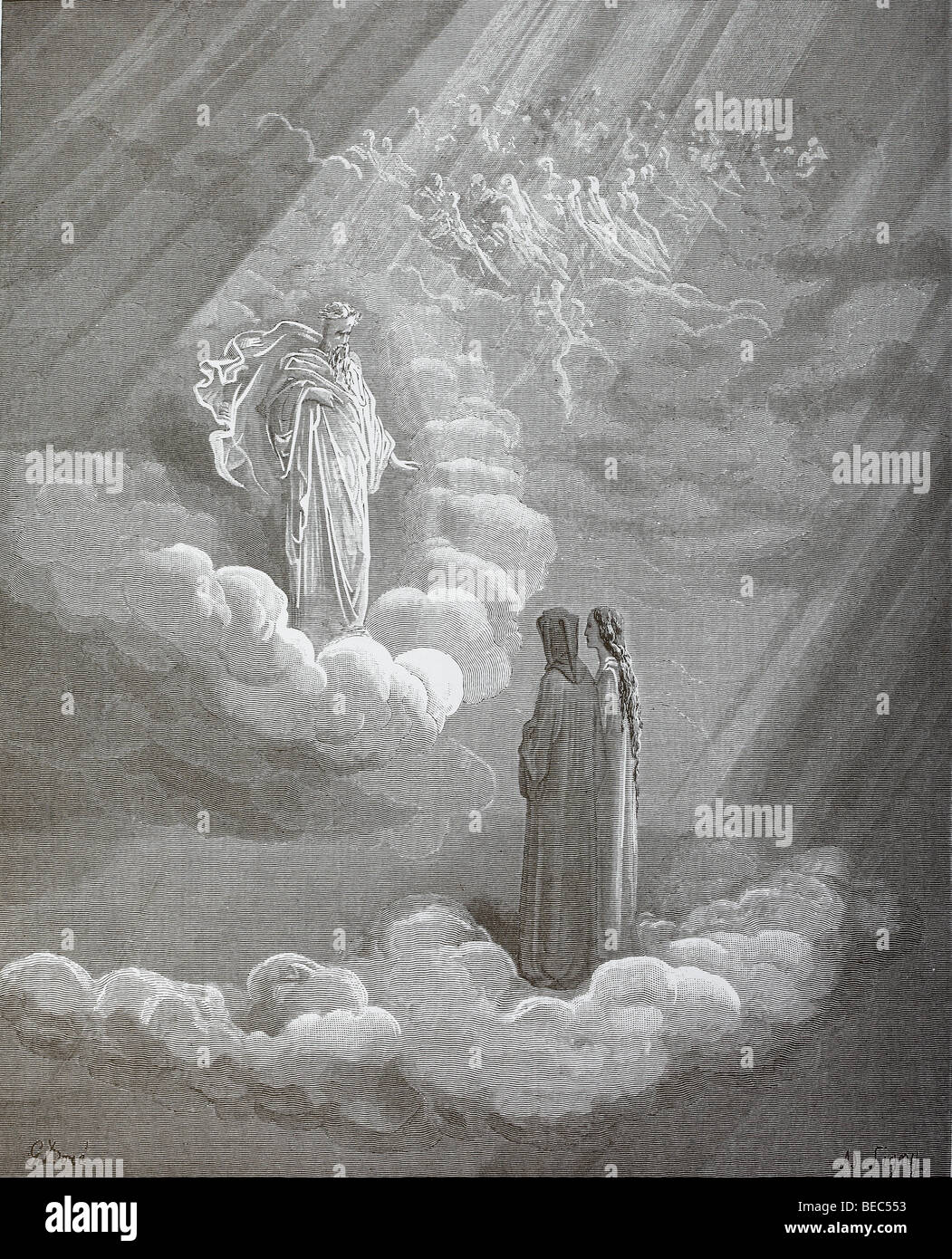 Gustave Dore's Illustration 'Cacciaguida' from Dante's Divine Comedy Stock Photohttps://www.alamy.com/image-license-details/?v=1https://www.alamy.com/stock-photo-gustave-dores-illustration-cacciaguida-from-dantes-divine-comedy-26083039.html
Gustave Dore's Illustration 'Cacciaguida' from Dante's Divine Comedy Stock Photohttps://www.alamy.com/image-license-details/?v=1https://www.alamy.com/stock-photo-gustave-dores-illustration-cacciaguida-from-dantes-divine-comedy-26083039.htmlRMBEC553–Gustave Dore's Illustration 'Cacciaguida' from Dante's Divine Comedy
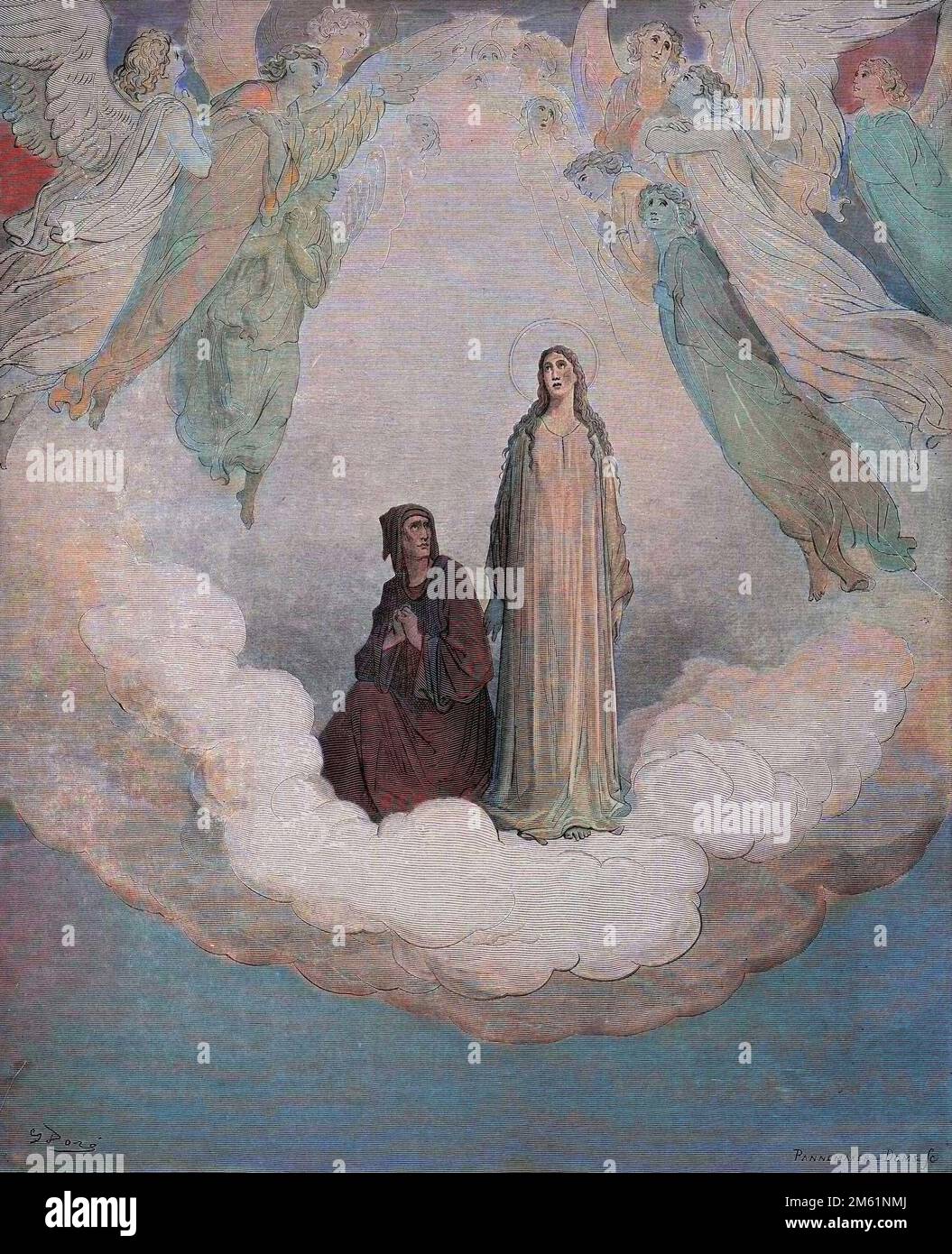 The Divine Comedy by Dante Alighieri , Paradiso, Canto 21 : Blessed Beatrice in the seventh circle - by Dante Alighieri (1265-1321) - Illustration de Gustave Dore (1832-1883), 1885 - Colorisation digitale d'apres l'originale Stock Photohttps://www.alamy.com/image-license-details/?v=1https://www.alamy.com/the-divine-comedy-by-dante-alighieri-paradiso-canto-21-blessed-beatrice-in-the-seventh-circle-by-dante-alighieri-1265-1321-illustration-de-gustave-dore-1832-1883-1885-colorisation-digitale-dapres-loriginale-image502827602.html
The Divine Comedy by Dante Alighieri , Paradiso, Canto 21 : Blessed Beatrice in the seventh circle - by Dante Alighieri (1265-1321) - Illustration de Gustave Dore (1832-1883), 1885 - Colorisation digitale d'apres l'originale Stock Photohttps://www.alamy.com/image-license-details/?v=1https://www.alamy.com/the-divine-comedy-by-dante-alighieri-paradiso-canto-21-blessed-beatrice-in-the-seventh-circle-by-dante-alighieri-1265-1321-illustration-de-gustave-dore-1832-1883-1885-colorisation-digitale-dapres-loriginale-image502827602.htmlRM2M61NMJ–The Divine Comedy by Dante Alighieri , Paradiso, Canto 21 : Blessed Beatrice in the seventh circle - by Dante Alighieri (1265-1321) - Illustration de Gustave Dore (1832-1883), 1885 - Colorisation digitale d'apres l'originale
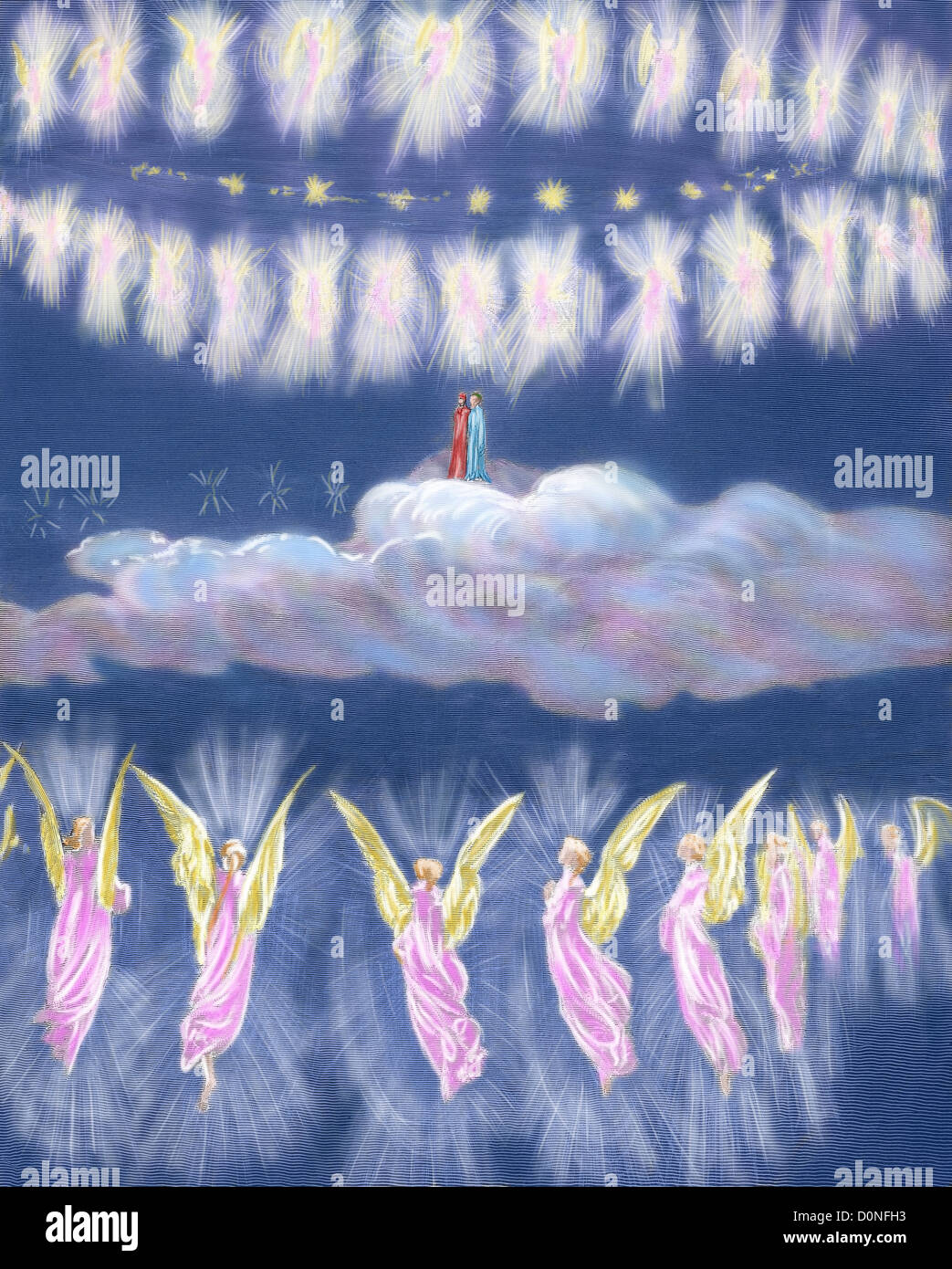 Divine Comedy. Paradise. XII Canto. Fourth heaven: the Sun. Souls of the wise and the Doctors of the Church. By Dore. Stock Photohttps://www.alamy.com/image-license-details/?v=1https://www.alamy.com/stock-photo-divine-comedy-paradise-xii-canto-fourth-heaven-the-sun-souls-of-the-52104335.html
Divine Comedy. Paradise. XII Canto. Fourth heaven: the Sun. Souls of the wise and the Doctors of the Church. By Dore. Stock Photohttps://www.alamy.com/image-license-details/?v=1https://www.alamy.com/stock-photo-divine-comedy-paradise-xii-canto-fourth-heaven-the-sun-souls-of-the-52104335.htmlRMD0NFH3–Divine Comedy. Paradise. XII Canto. Fourth heaven: the Sun. Souls of the wise and the Doctors of the Church. By Dore.
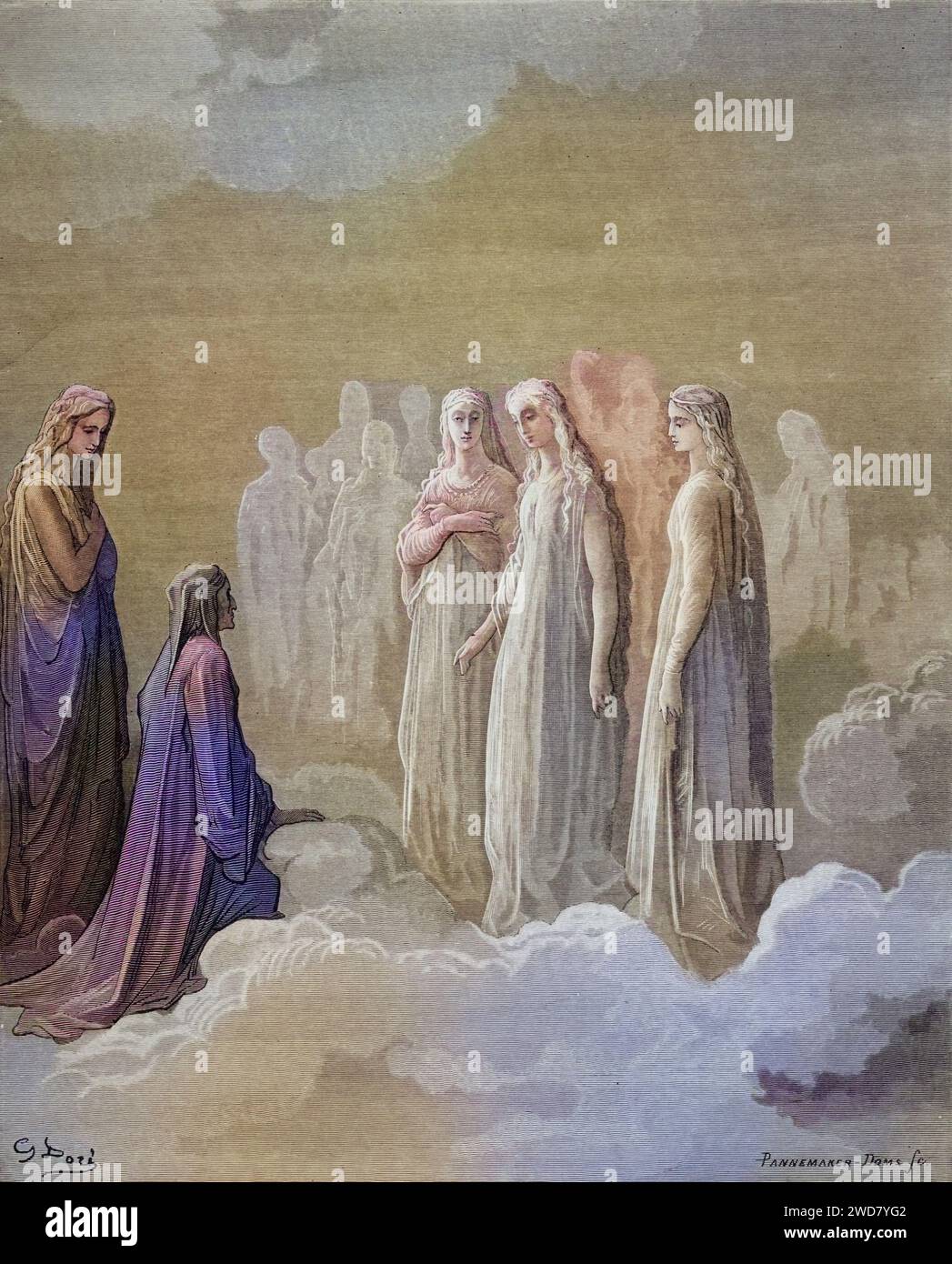 Illustration für Paradiso, die Göttliche Komödie von Dante Alighieri Canto von Gustave Dore 1832-1883, französischer Künstler, Inferno, Hölle, Paradies, Engel, Verdammnis, Historisch, digital restaurierte Reproduktion von einer Vorlage aus dem 19. Jahrhundert, Record date not stated Stock Photohttps://www.alamy.com/image-license-details/?v=1https://www.alamy.com/illustration-fr-paradiso-die-gttliche-komdie-von-dante-alighieri-canto-von-gustave-dore-1832-1883-franzsischer-knstler-inferno-hlle-paradies-engel-verdammnis-historisch-digital-restaurierte-reproduktion-von-einer-vorlage-aus-dem-19-jahrhundert-record-date-not-stated-image593318322.html
Illustration für Paradiso, die Göttliche Komödie von Dante Alighieri Canto von Gustave Dore 1832-1883, französischer Künstler, Inferno, Hölle, Paradies, Engel, Verdammnis, Historisch, digital restaurierte Reproduktion von einer Vorlage aus dem 19. Jahrhundert, Record date not stated Stock Photohttps://www.alamy.com/image-license-details/?v=1https://www.alamy.com/illustration-fr-paradiso-die-gttliche-komdie-von-dante-alighieri-canto-von-gustave-dore-1832-1883-franzsischer-knstler-inferno-hlle-paradies-engel-verdammnis-historisch-digital-restaurierte-reproduktion-von-einer-vorlage-aus-dem-19-jahrhundert-record-date-not-stated-image593318322.htmlRF2WD7YG2–Illustration für Paradiso, die Göttliche Komödie von Dante Alighieri Canto von Gustave Dore 1832-1883, französischer Künstler, Inferno, Hölle, Paradies, Engel, Verdammnis, Historisch, digital restaurierte Reproduktion von einer Vorlage aus dem 19. Jahrhundert, Record date not stated
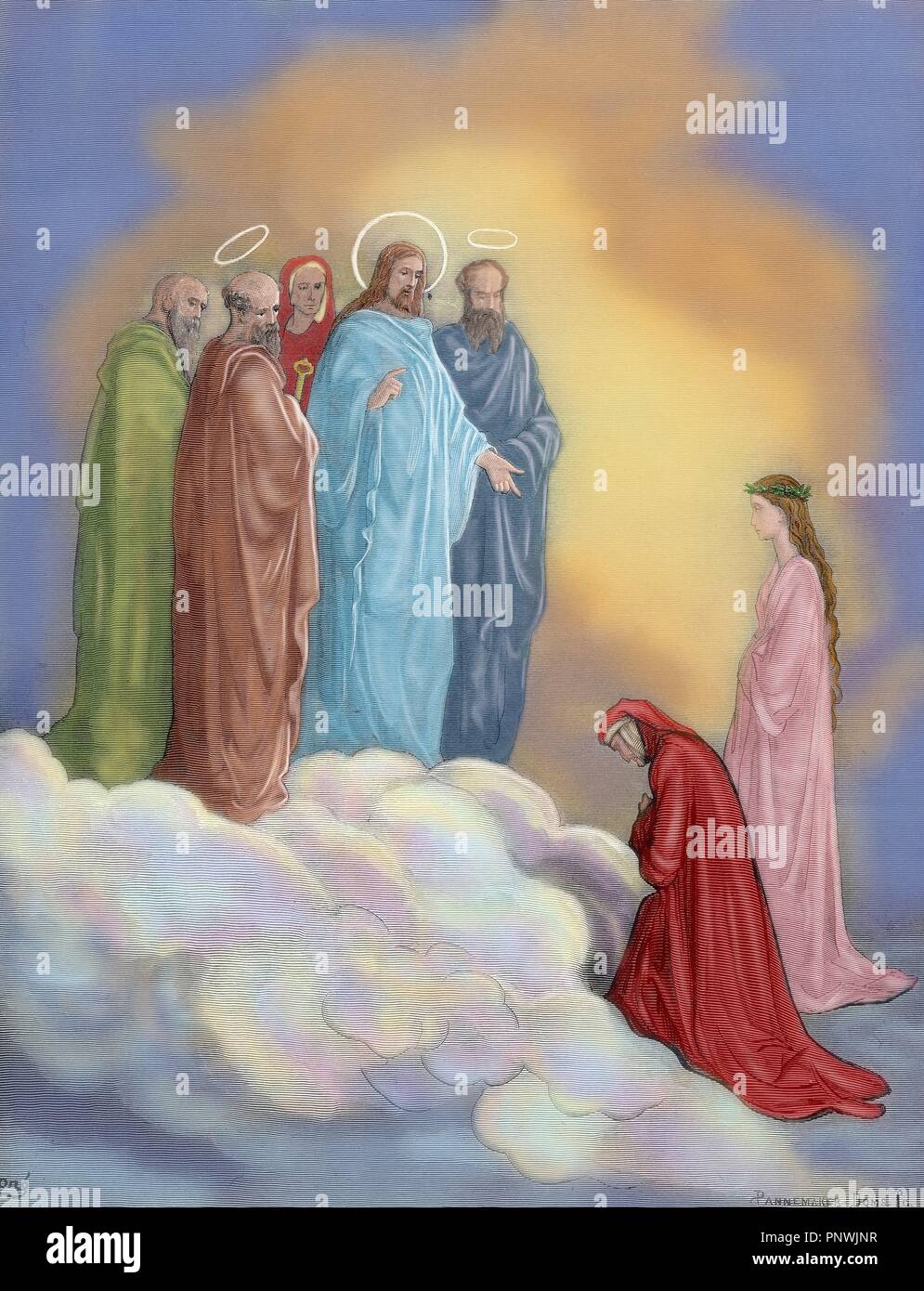 Divine Comedy. Epic poem written by Dante Alighieri between 1308 and his death in 1321. Paradise. XXVI Canto. St. John examines Dante concerning love. Engraving by Gustave Dore. Colored. Stock Photohttps://www.alamy.com/image-license-details/?v=1https://www.alamy.com/divine-comedy-epic-poem-written-by-dante-alighieri-between-1308-and-his-death-in-1321-paradise-xxvi-canto-st-john-examines-dante-concerning-love-engraving-by-gustave-dore-colored-image219995715.html
Divine Comedy. Epic poem written by Dante Alighieri between 1308 and his death in 1321. Paradise. XXVI Canto. St. John examines Dante concerning love. Engraving by Gustave Dore. Colored. Stock Photohttps://www.alamy.com/image-license-details/?v=1https://www.alamy.com/divine-comedy-epic-poem-written-by-dante-alighieri-between-1308-and-his-death-in-1321-paradise-xxvi-canto-st-john-examines-dante-concerning-love-engraving-by-gustave-dore-colored-image219995715.htmlRMPNWJNR–Divine Comedy. Epic poem written by Dante Alighieri between 1308 and his death in 1321. Paradise. XXVI Canto. St. John examines Dante concerning love. Engraving by Gustave Dore. Colored.
 The Angels in the Planet Mercury, by Gustave Doré, 1832 - 1883, French. Engraving for Paradiso by Dante. 1870, Art reimagined Stock Photohttps://www.alamy.com/image-license-details/?v=1https://www.alamy.com/the-angels-in-the-planet-mercury-by-gustave-dor-1832-1883-french-engraving-for-paradiso-by-dante-1870-art-reimagined-image230058623.html
The Angels in the Planet Mercury, by Gustave Doré, 1832 - 1883, French. Engraving for Paradiso by Dante. 1870, Art reimagined Stock Photohttps://www.alamy.com/image-license-details/?v=1https://www.alamy.com/the-angels-in-the-planet-mercury-by-gustave-dor-1832-1883-french-engraving-for-paradiso-by-dante-1870-art-reimagined-image230058623.htmlRFRA823B–The Angels in the Planet Mercury, by Gustave Doré, 1832 - 1883, French. Engraving for Paradiso by Dante. 1870, Art reimagined
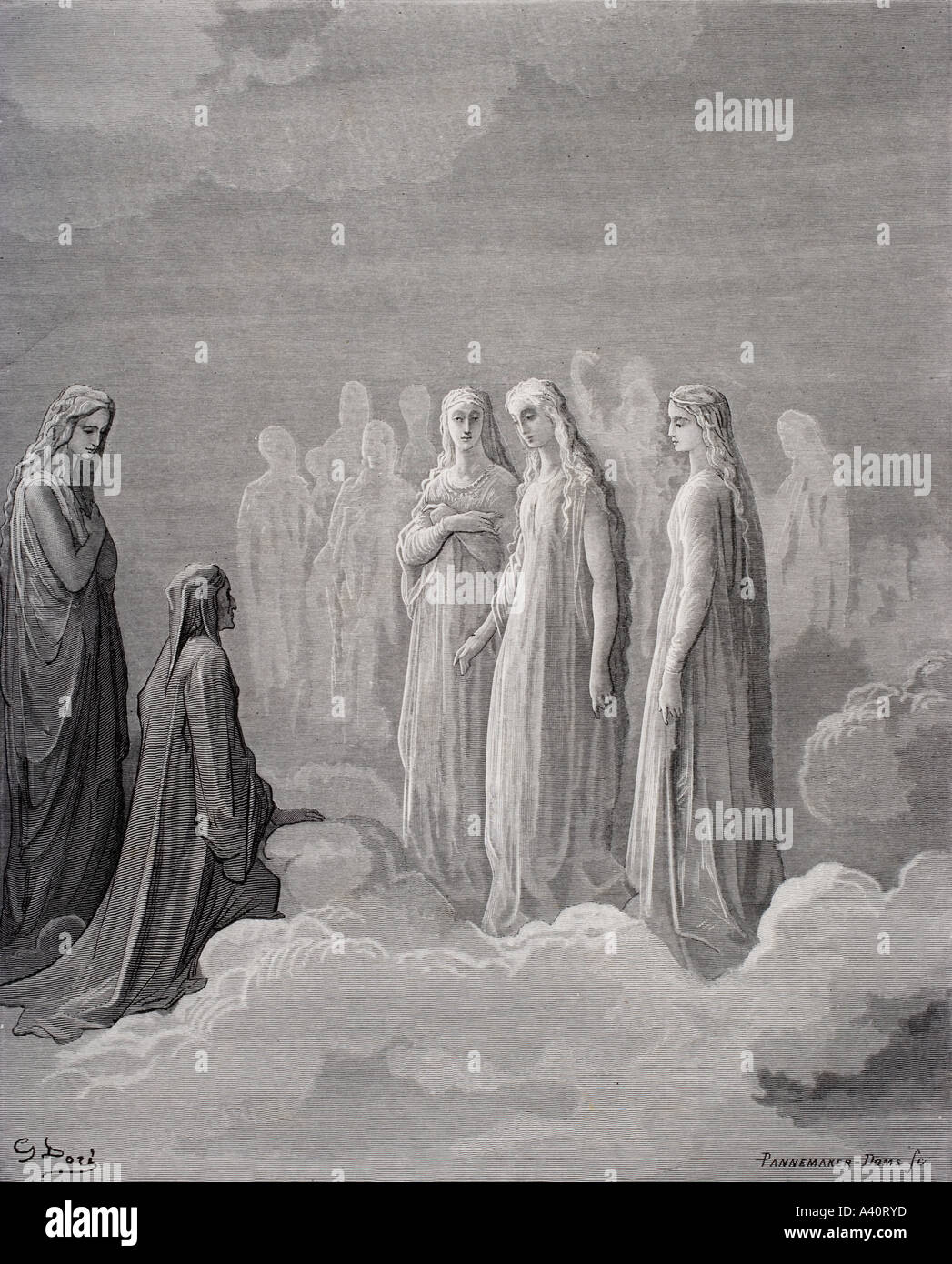 Illustration for Paradiso by Dante Alighieri. Canto III lines 14 and 15, by Gustave Dore, 1832 -1883. French artist and illustrator. Stock Photohttps://www.alamy.com/image-license-details/?v=1https://www.alamy.com/illustration-for-paradiso-by-dante-alighieri-canto-iii-lines-14-and-image6226428.html
Illustration for Paradiso by Dante Alighieri. Canto III lines 14 and 15, by Gustave Dore, 1832 -1883. French artist and illustrator. Stock Photohttps://www.alamy.com/image-license-details/?v=1https://www.alamy.com/illustration-for-paradiso-by-dante-alighieri-canto-iii-lines-14-and-image6226428.htmlRMA40RYD–Illustration for Paradiso by Dante Alighieri. Canto III lines 14 and 15, by Gustave Dore, 1832 -1883. French artist and illustrator.
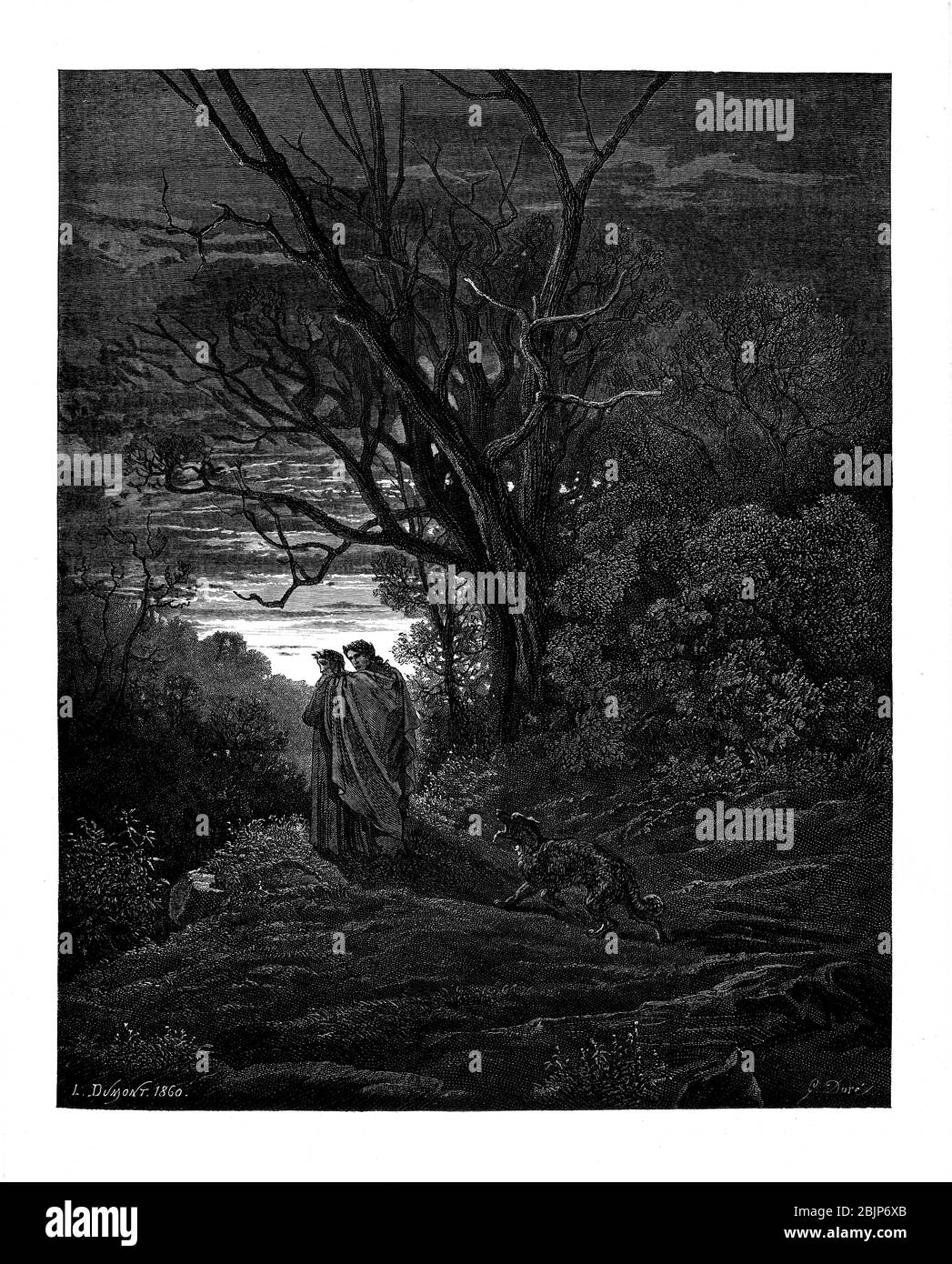 Dante meets Virgil From the Divine Comedy by 14th century Italian poet Dante Alighieri. 1860 artwork, by French artist Gustave Dore and engraved by Stephane Pannemaker, from 'The Vision of Hell' (1868), Cary's English translation of the Inferno. Dante wrote his epic poem 'Divina Commedia' (The Divine Comedy) between 1308 and his death in 1321. Consisting of 14,233 lines, and divided into three parts (Inferno, Purgatorio, and Paradiso), it is considered the greatest literary work in the Italian language and a world masterpiece. It is a comprehensive survey of medieval theology, literature and t Stock Photohttps://www.alamy.com/image-license-details/?v=1https://www.alamy.com/dante-meets-virgil-from-the-divine-comedy-by-14th-century-italian-poet-dante-alighieri-1860-artwork-by-french-artist-gustave-dore-and-engraved-by-stephane-pannemaker-from-the-vision-of-hell-1868-carys-english-translation-of-the-inferno-dante-wrote-his-epic-poem-divina-commedia-the-divine-comedy-between-1308-and-his-death-in-1321-consisting-of-14233-lines-and-divided-into-three-parts-inferno-purgatorio-and-paradiso-it-is-considered-the-greatest-literary-work-in-the-italian-language-and-a-world-masterpiece-it-is-a-comprehensive-survey-of-medieval-theology-literature-and-t-image355759555.html
Dante meets Virgil From the Divine Comedy by 14th century Italian poet Dante Alighieri. 1860 artwork, by French artist Gustave Dore and engraved by Stephane Pannemaker, from 'The Vision of Hell' (1868), Cary's English translation of the Inferno. Dante wrote his epic poem 'Divina Commedia' (The Divine Comedy) between 1308 and his death in 1321. Consisting of 14,233 lines, and divided into three parts (Inferno, Purgatorio, and Paradiso), it is considered the greatest literary work in the Italian language and a world masterpiece. It is a comprehensive survey of medieval theology, literature and t Stock Photohttps://www.alamy.com/image-license-details/?v=1https://www.alamy.com/dante-meets-virgil-from-the-divine-comedy-by-14th-century-italian-poet-dante-alighieri-1860-artwork-by-french-artist-gustave-dore-and-engraved-by-stephane-pannemaker-from-the-vision-of-hell-1868-carys-english-translation-of-the-inferno-dante-wrote-his-epic-poem-divina-commedia-the-divine-comedy-between-1308-and-his-death-in-1321-consisting-of-14233-lines-and-divided-into-three-parts-inferno-purgatorio-and-paradiso-it-is-considered-the-greatest-literary-work-in-the-italian-language-and-a-world-masterpiece-it-is-a-comprehensive-survey-of-medieval-theology-literature-and-t-image355759555.htmlRM2BJP6XB–Dante meets Virgil From the Divine Comedy by 14th century Italian poet Dante Alighieri. 1860 artwork, by French artist Gustave Dore and engraved by Stephane Pannemaker, from 'The Vision of Hell' (1868), Cary's English translation of the Inferno. Dante wrote his epic poem 'Divina Commedia' (The Divine Comedy) between 1308 and his death in 1321. Consisting of 14,233 lines, and divided into three parts (Inferno, Purgatorio, and Paradiso), it is considered the greatest literary work in the Italian language and a world masterpiece. It is a comprehensive survey of medieval theology, literature and t
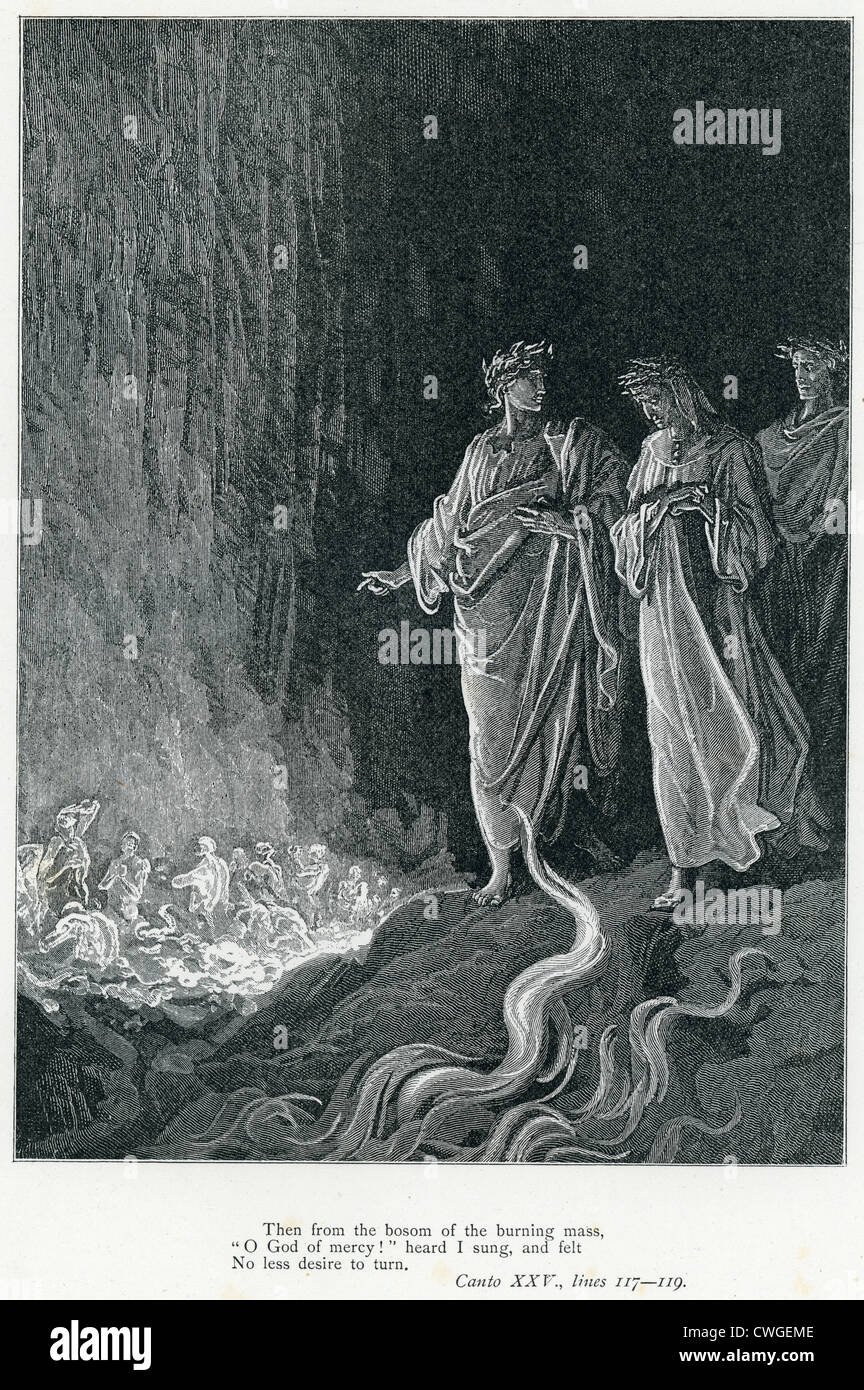 Illustration by Gustave Dore from The Vision of Purgatory and Paradise by Dante Alighieri Stock Photohttps://www.alamy.com/image-license-details/?v=1https://www.alamy.com/stock-photo-illustration-by-gustave-dore-from-the-vision-of-purgatory-and-paradise-50149918.html
Illustration by Gustave Dore from The Vision of Purgatory and Paradise by Dante Alighieri Stock Photohttps://www.alamy.com/image-license-details/?v=1https://www.alamy.com/stock-photo-illustration-by-gustave-dore-from-the-vision-of-purgatory-and-paradise-50149918.htmlRMCWGEME–Illustration by Gustave Dore from The Vision of Purgatory and Paradise by Dante Alighieri
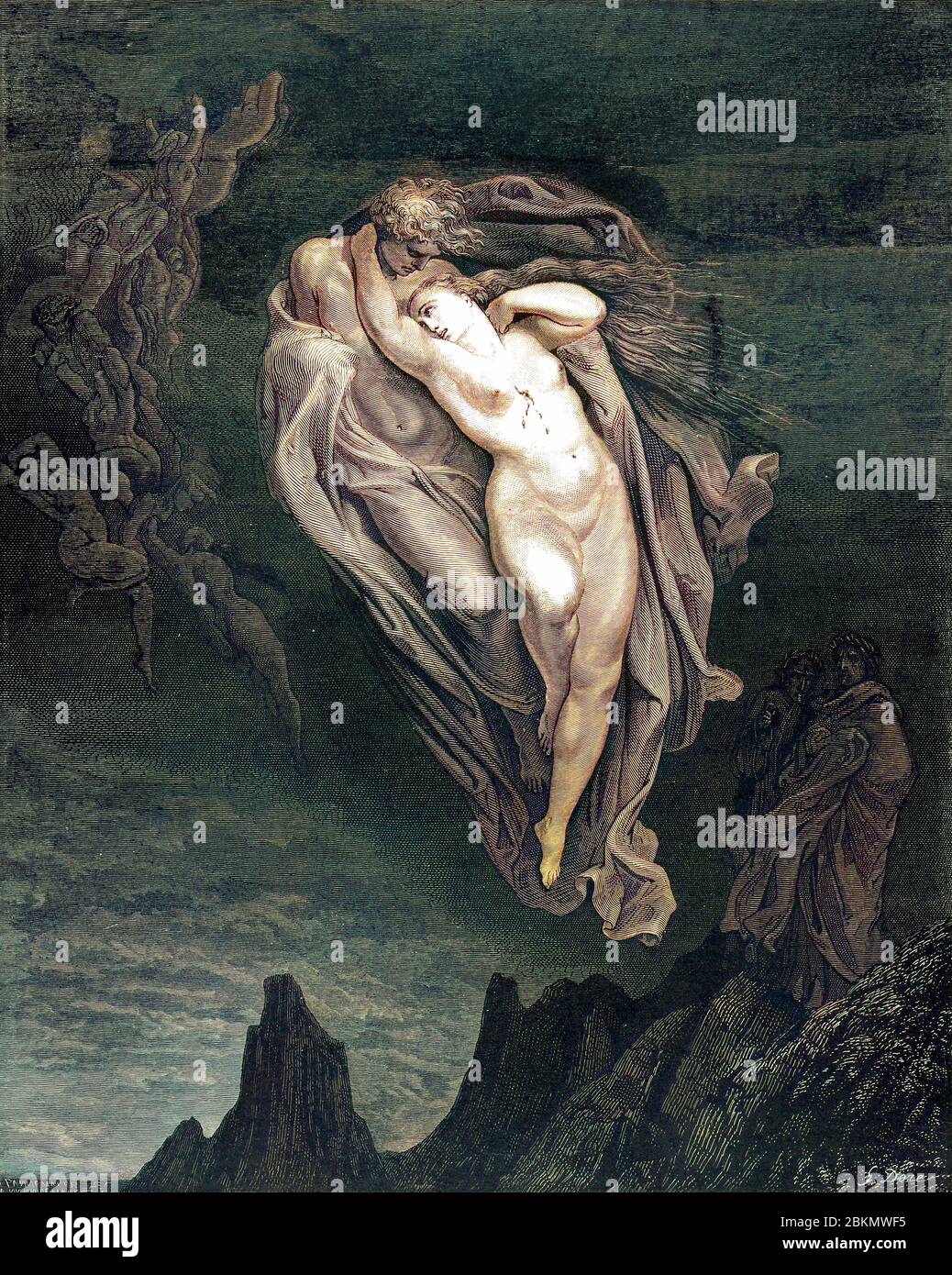 Machine colorized with Artificial Intelligence (AI) From the Divine Comedy by 14th century Italian poet Dante Alighieri. 1860 artwork, by French artist Gustave Dore and engraved by Stephane Pannemaker, from 'The Vision of Hell' (1868), Cary's English translation of the Inferno. Dante wrote his epic poem 'Divina Commedia' (The Divine Comedy) between 1308 and his death in 1321. Consisting of 14,233 lines, and divided into three parts (Inferno, Purgatorio, and Paradiso), it is considered the greatest literary work in the Italian language and a world masterpiece. It is a comprehensive survey of me Stock Photohttps://www.alamy.com/image-license-details/?v=1https://www.alamy.com/machine-colorized-with-artificial-intelligence-ai-from-the-divine-comedy-by-14th-century-italian-poet-dante-alighieri-1860-artwork-by-french-artist-gustave-dore-and-engraved-by-stephane-pannemaker-from-the-vision-of-hell-1868-carys-english-translation-of-the-inferno-dante-wrote-his-epic-poem-divina-commedia-the-divine-comedy-between-1308-and-his-death-in-1321-consisting-of-14233-lines-and-divided-into-three-parts-inferno-purgatorio-and-paradiso-it-is-considered-the-greatest-literary-work-in-the-italian-language-and-a-world-masterpiece-it-is-a-comprehensive-survey-of-me-image356344889.html
Machine colorized with Artificial Intelligence (AI) From the Divine Comedy by 14th century Italian poet Dante Alighieri. 1860 artwork, by French artist Gustave Dore and engraved by Stephane Pannemaker, from 'The Vision of Hell' (1868), Cary's English translation of the Inferno. Dante wrote his epic poem 'Divina Commedia' (The Divine Comedy) between 1308 and his death in 1321. Consisting of 14,233 lines, and divided into three parts (Inferno, Purgatorio, and Paradiso), it is considered the greatest literary work in the Italian language and a world masterpiece. It is a comprehensive survey of me Stock Photohttps://www.alamy.com/image-license-details/?v=1https://www.alamy.com/machine-colorized-with-artificial-intelligence-ai-from-the-divine-comedy-by-14th-century-italian-poet-dante-alighieri-1860-artwork-by-french-artist-gustave-dore-and-engraved-by-stephane-pannemaker-from-the-vision-of-hell-1868-carys-english-translation-of-the-inferno-dante-wrote-his-epic-poem-divina-commedia-the-divine-comedy-between-1308-and-his-death-in-1321-consisting-of-14233-lines-and-divided-into-three-parts-inferno-purgatorio-and-paradiso-it-is-considered-the-greatest-literary-work-in-the-italian-language-and-a-world-masterpiece-it-is-a-comprehensive-survey-of-me-image356344889.htmlRM2BKMWF5–Machine colorized with Artificial Intelligence (AI) From the Divine Comedy by 14th century Italian poet Dante Alighieri. 1860 artwork, by French artist Gustave Dore and engraved by Stephane Pannemaker, from 'The Vision of Hell' (1868), Cary's English translation of the Inferno. Dante wrote his epic poem 'Divina Commedia' (The Divine Comedy) between 1308 and his death in 1321. Consisting of 14,233 lines, and divided into three parts (Inferno, Purgatorio, and Paradiso), it is considered the greatest literary work in the Italian language and a world masterpiece. It is a comprehensive survey of me
 THE ANGELS IN THE PLANET MERCURY, BY GUSTAVE DORÉ. Dore, 1832 - 1883, French. Engraving for Paradiso by Dante. 1870, Art Stock Photohttps://www.alamy.com/image-license-details/?v=1https://www.alamy.com/stock-photo-the-angels-in-the-planet-mercury-by-gustave-dor-dore-1832-1883-french-59996364.html
THE ANGELS IN THE PLANET MERCURY, BY GUSTAVE DORÉ. Dore, 1832 - 1883, French. Engraving for Paradiso by Dante. 1870, Art Stock Photohttps://www.alamy.com/image-license-details/?v=1https://www.alamy.com/stock-photo-the-angels-in-the-planet-mercury-by-gustave-dor-dore-1832-1883-french-59996364.htmlRMDDH1Y8–THE ANGELS IN THE PLANET MERCURY, BY GUSTAVE DORÉ. Dore, 1832 - 1883, French. Engraving for Paradiso by Dante. 1870, Art
 The Vision of the Sixth Heaven, by Gustave Doré, 1832 - 1883, French. Engraving for Paradiso by Dante, 1870, Romanticism, Colour, Color Engraving Stock Photohttps://www.alamy.com/image-license-details/?v=1https://www.alamy.com/the-vision-of-the-sixth-heaven-by-gustave-dor-1832-1883-french-engraving-for-paradiso-by-dante-1870-romanticism-colour-color-engraving-image240631811.html
The Vision of the Sixth Heaven, by Gustave Doré, 1832 - 1883, French. Engraving for Paradiso by Dante, 1870, Romanticism, Colour, Color Engraving Stock Photohttps://www.alamy.com/image-license-details/?v=1https://www.alamy.com/the-vision-of-the-sixth-heaven-by-gustave-dor-1832-1883-french-engraving-for-paradiso-by-dante-1870-romanticism-colour-color-engraving-image240631811.htmlRMRYDM97–The Vision of the Sixth Heaven, by Gustave Doré, 1832 - 1883, French. Engraving for Paradiso by Dante, 1870, Romanticism, Colour, Color Engraving
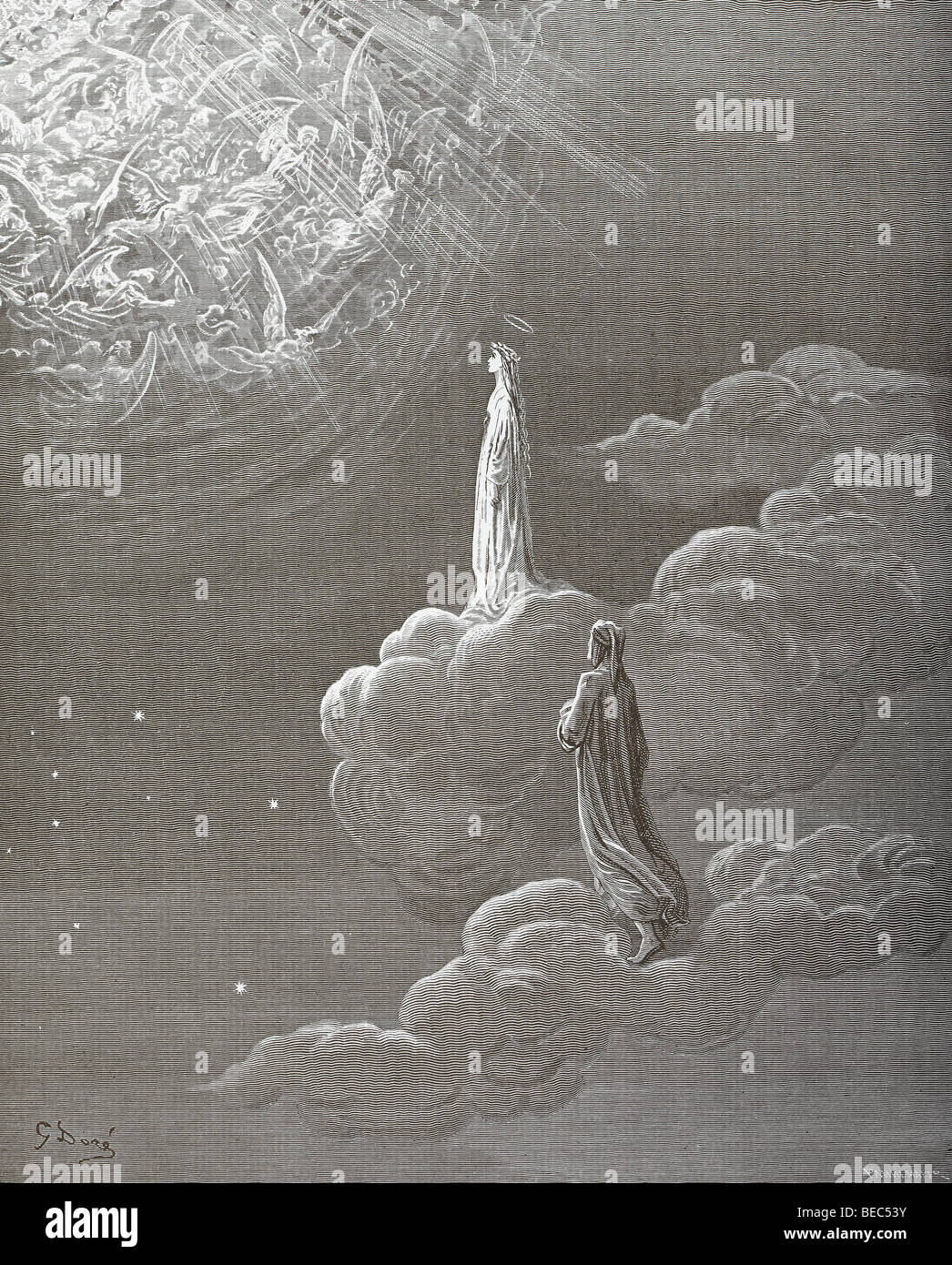 Gustave Dore's Illustration 'Mars' from Dante's Divine Comedy Stock Photohttps://www.alamy.com/image-license-details/?v=1https://www.alamy.com/stock-photo-gustave-dores-illustration-mars-from-dantes-divine-comedy-26083007.html
Gustave Dore's Illustration 'Mars' from Dante's Divine Comedy Stock Photohttps://www.alamy.com/image-license-details/?v=1https://www.alamy.com/stock-photo-gustave-dores-illustration-mars-from-dantes-divine-comedy-26083007.htmlRMBEC53Y–Gustave Dore's Illustration 'Mars' from Dante's Divine Comedy
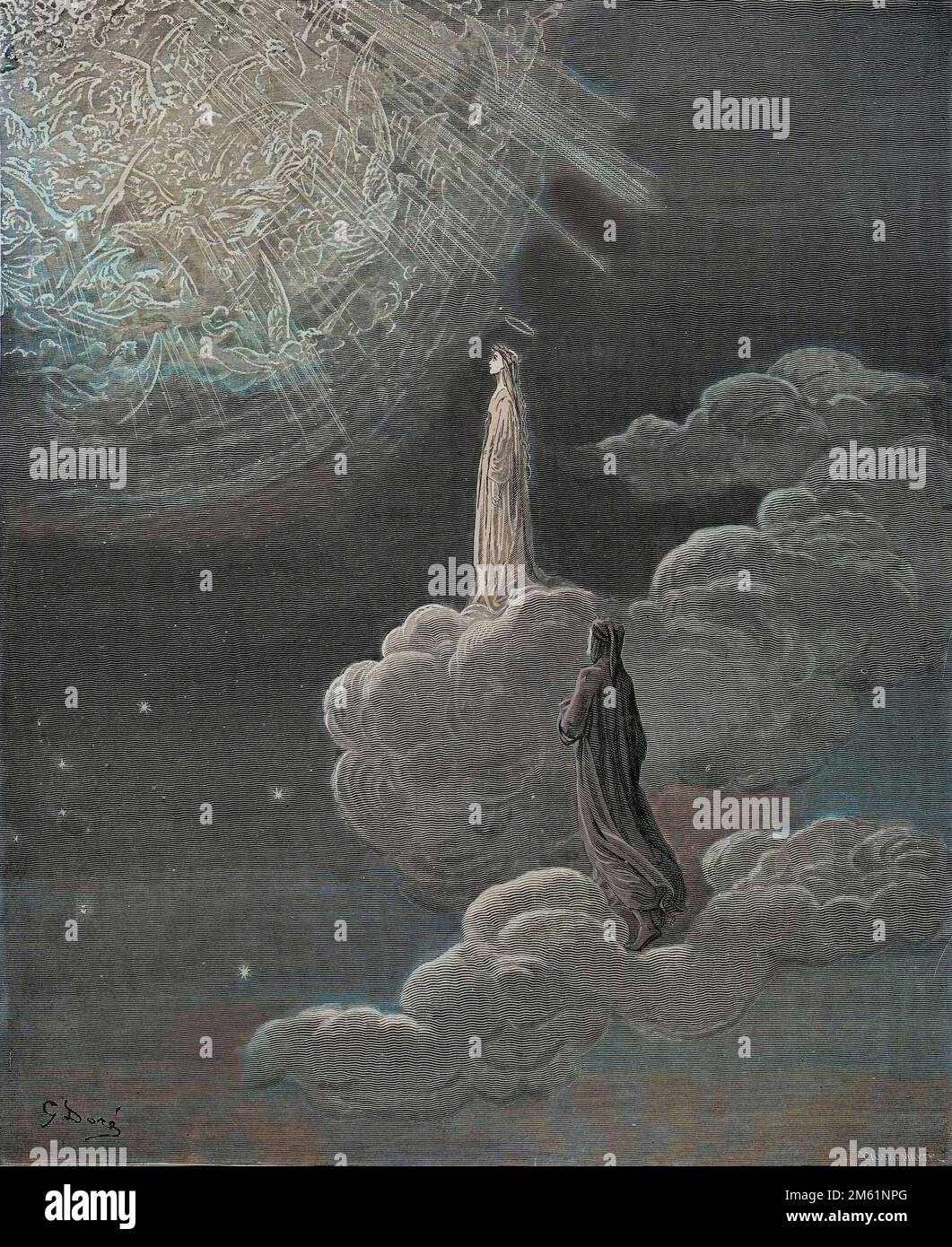 The Divine Comedy by Dante Alighieri , Paradiso, Canto 14 : Dante and Beatrice translated to the sphere of Mars - by Dante Alighieri (1265-1321) - Illustration de Gustave Dore (1832-1883), 1885 - Colorisation digitale d'apres l'originale Stock Photohttps://www.alamy.com/image-license-details/?v=1https://www.alamy.com/the-divine-comedy-by-dante-alighieri-paradiso-canto-14-dante-and-beatrice-translated-to-the-sphere-of-mars-by-dante-alighieri-1265-1321-illustration-de-gustave-dore-1832-1883-1885-colorisation-digitale-dapres-loriginale-image502827656.html
The Divine Comedy by Dante Alighieri , Paradiso, Canto 14 : Dante and Beatrice translated to the sphere of Mars - by Dante Alighieri (1265-1321) - Illustration de Gustave Dore (1832-1883), 1885 - Colorisation digitale d'apres l'originale Stock Photohttps://www.alamy.com/image-license-details/?v=1https://www.alamy.com/the-divine-comedy-by-dante-alighieri-paradiso-canto-14-dante-and-beatrice-translated-to-the-sphere-of-mars-by-dante-alighieri-1265-1321-illustration-de-gustave-dore-1832-1883-1885-colorisation-digitale-dapres-loriginale-image502827656.htmlRM2M61NPG–The Divine Comedy by Dante Alighieri , Paradiso, Canto 14 : Dante and Beatrice translated to the sphere of Mars - by Dante Alighieri (1265-1321) - Illustration de Gustave Dore (1832-1883), 1885 - Colorisation digitale d'apres l'originale
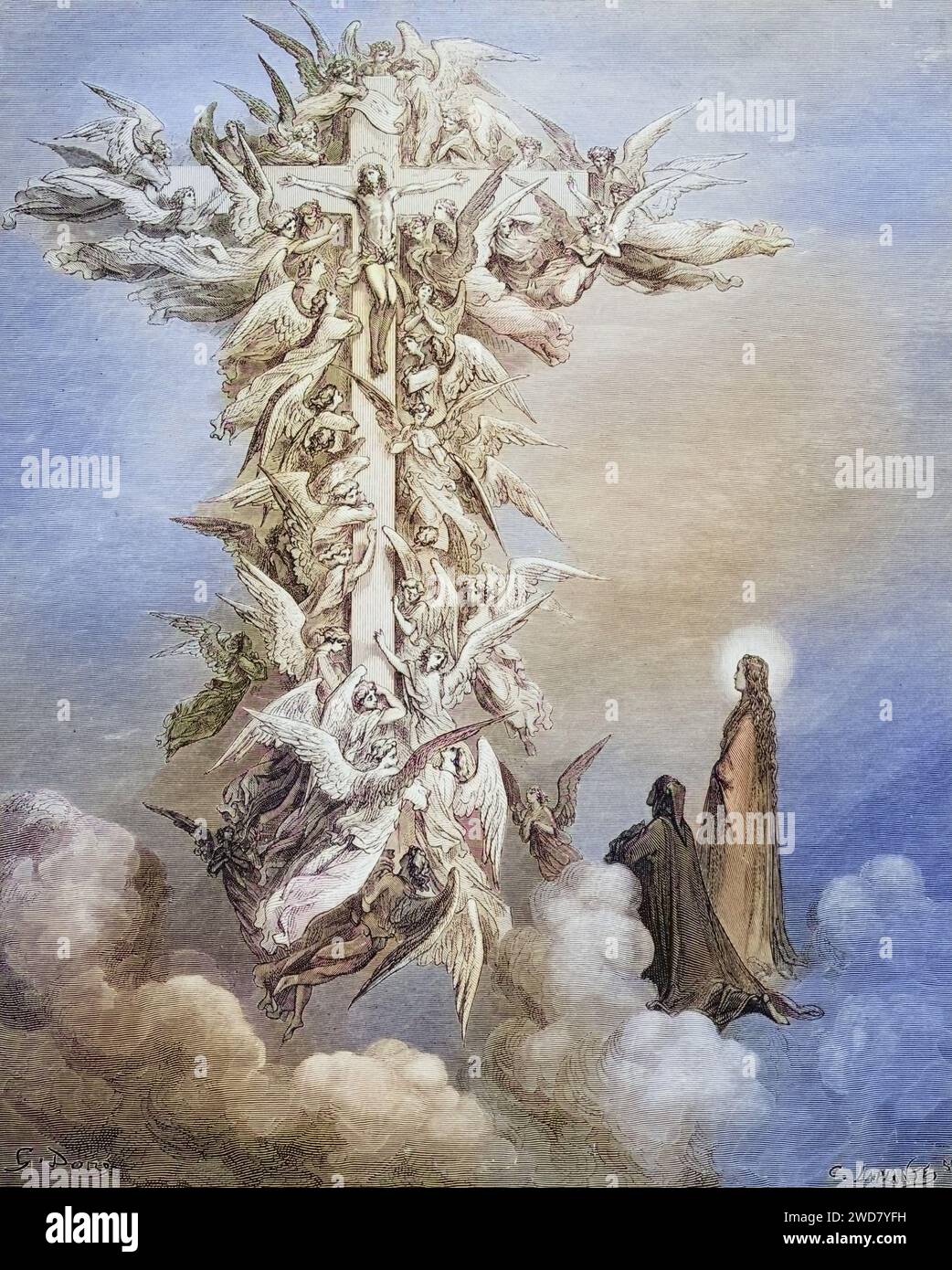 Illustration für Paradiso, die Göttliche Komödie von Dante Alighieri Canto von Gustave Dore 1832-1883, französischer Künstler, Inferno, Hölle, Paradies, Engel, Verdammnis, Historisch, digital restaurierte Reproduktion von einer Vorlage aus dem 19. Jahrhundert, Record date not stated Stock Photohttps://www.alamy.com/image-license-details/?v=1https://www.alamy.com/illustration-fr-paradiso-die-gttliche-komdie-von-dante-alighieri-canto-von-gustave-dore-1832-1883-franzsischer-knstler-inferno-hlle-paradies-engel-verdammnis-historisch-digital-restaurierte-reproduktion-von-einer-vorlage-aus-dem-19-jahrhundert-record-date-not-stated-image593318309.html
Illustration für Paradiso, die Göttliche Komödie von Dante Alighieri Canto von Gustave Dore 1832-1883, französischer Künstler, Inferno, Hölle, Paradies, Engel, Verdammnis, Historisch, digital restaurierte Reproduktion von einer Vorlage aus dem 19. Jahrhundert, Record date not stated Stock Photohttps://www.alamy.com/image-license-details/?v=1https://www.alamy.com/illustration-fr-paradiso-die-gttliche-komdie-von-dante-alighieri-canto-von-gustave-dore-1832-1883-franzsischer-knstler-inferno-hlle-paradies-engel-verdammnis-historisch-digital-restaurierte-reproduktion-von-einer-vorlage-aus-dem-19-jahrhundert-record-date-not-stated-image593318309.htmlRF2WD7YFH–Illustration für Paradiso, die Göttliche Komödie von Dante Alighieri Canto von Gustave Dore 1832-1883, französischer Künstler, Inferno, Hölle, Paradies, Engel, Verdammnis, Historisch, digital restaurierte Reproduktion von einer Vorlage aus dem 19. Jahrhundert, Record date not stated
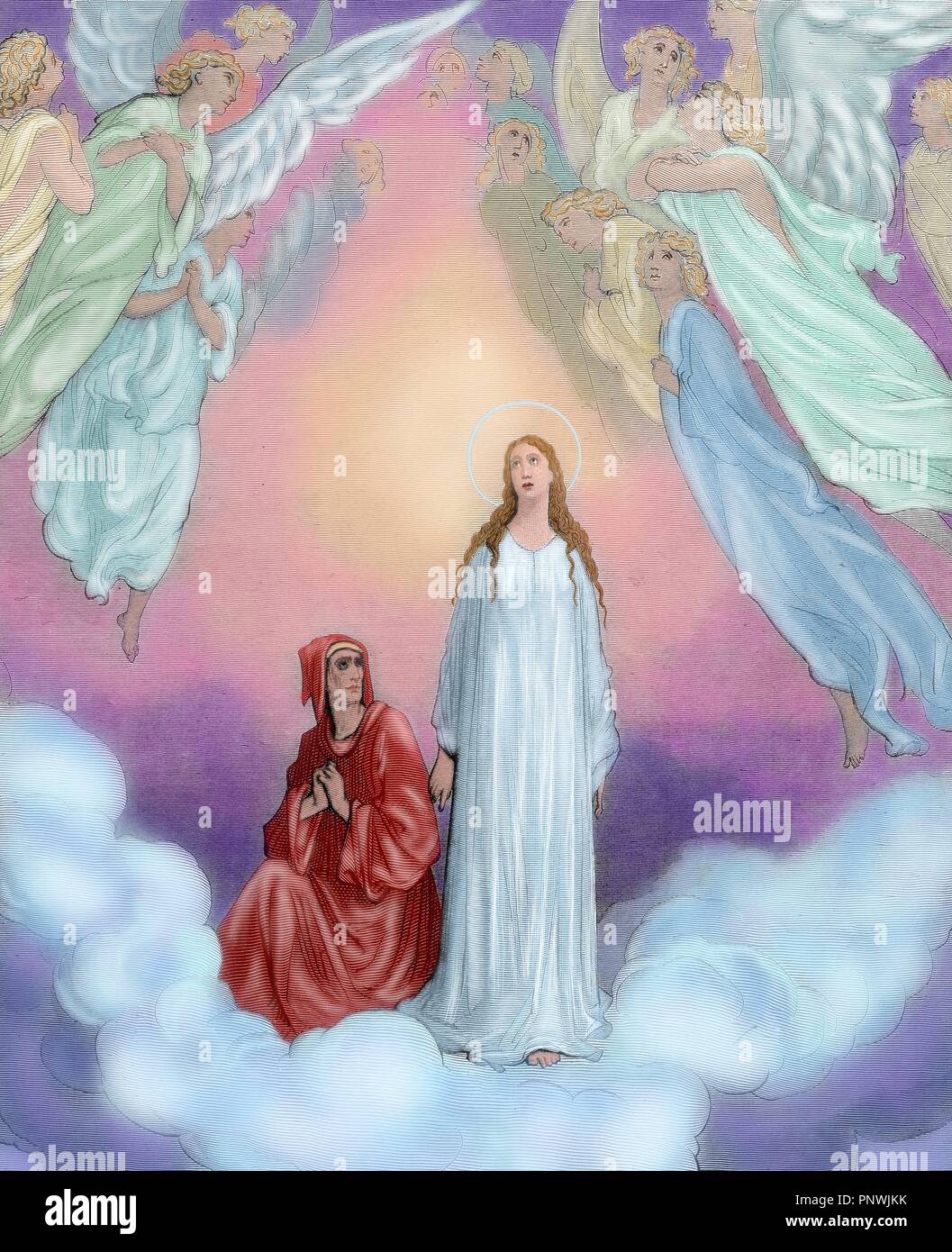 Divine Comedy. Epic poem written by Dante Alighieri between 1308 and his death in 1321. Paradise. XXI Canto. Dante ascends with Beatrice to the seventh heaven, which is the planet Saturn.Engraving by Gustave Dore. Colored. Stock Photohttps://www.alamy.com/image-license-details/?v=1https://www.alamy.com/divine-comedy-epic-poem-written-by-dante-alighieri-between-1308-and-his-death-in-1321-paradise-xxi-canto-dante-ascends-with-beatrice-to-the-seventh-heaven-which-is-the-planet-saturnengraving-by-gustave-dore-colored-image219995655.html
Divine Comedy. Epic poem written by Dante Alighieri between 1308 and his death in 1321. Paradise. XXI Canto. Dante ascends with Beatrice to the seventh heaven, which is the planet Saturn.Engraving by Gustave Dore. Colored. Stock Photohttps://www.alamy.com/image-license-details/?v=1https://www.alamy.com/divine-comedy-epic-poem-written-by-dante-alighieri-between-1308-and-his-death-in-1321-paradise-xxi-canto-dante-ascends-with-beatrice-to-the-seventh-heaven-which-is-the-planet-saturnengraving-by-gustave-dore-colored-image219995655.htmlRMPNWJKK–Divine Comedy. Epic poem written by Dante Alighieri between 1308 and his death in 1321. Paradise. XXI Canto. Dante ascends with Beatrice to the seventh heaven, which is the planet Saturn.Engraving by Gustave Dore. Colored.
 The Vision of the Sixth Heaven, by Gustave Doré, 1832 - 1883, French. Engraving for Paradiso by Dante, 1870 reimagined Stock Photohttps://www.alamy.com/image-license-details/?v=1https://www.alamy.com/the-vision-of-the-sixth-heaven-by-gustave-dor-1832-1883-french-engraving-for-paradiso-by-dante-1870-reimagined-image230058649.html
The Vision of the Sixth Heaven, by Gustave Doré, 1832 - 1883, French. Engraving for Paradiso by Dante, 1870 reimagined Stock Photohttps://www.alamy.com/image-license-details/?v=1https://www.alamy.com/the-vision-of-the-sixth-heaven-by-gustave-dor-1832-1883-french-engraving-for-paradiso-by-dante-1870-reimagined-image230058649.htmlRFRA8249–The Vision of the Sixth Heaven, by Gustave Doré, 1832 - 1883, French. Engraving for Paradiso by Dante, 1870 reimagined
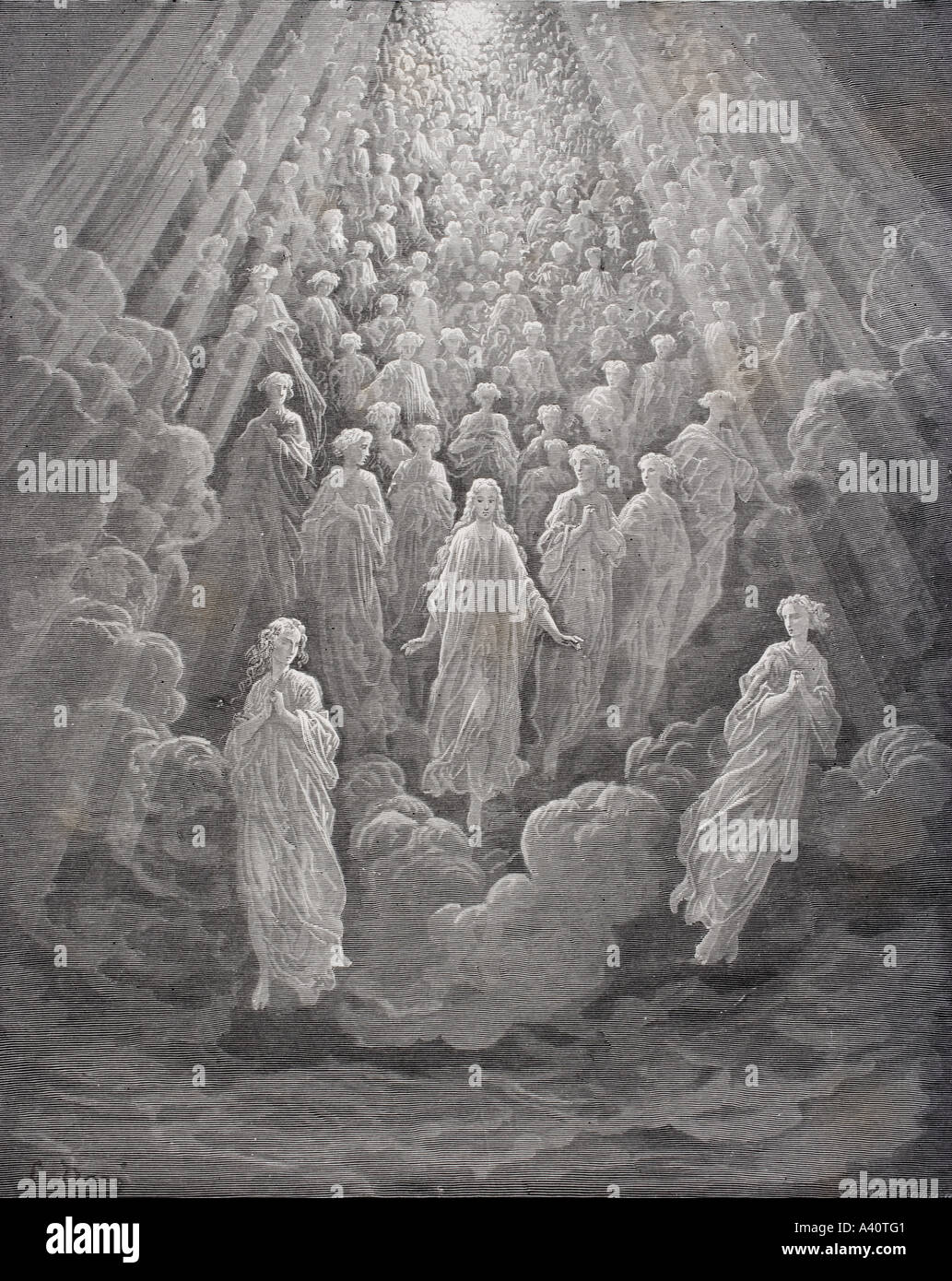 Illustration for Paradiso by Dante Alighieri. Canto V, lines 99 and 100, by Gustave Dore, 1832 - 1883. French artist and illustrator. Stock Photohttps://www.alamy.com/image-license-details/?v=1https://www.alamy.com/illustration-for-paradiso-by-dante-alighieri-canto-v-lines-99-and-image6226432.html
Illustration for Paradiso by Dante Alighieri. Canto V, lines 99 and 100, by Gustave Dore, 1832 - 1883. French artist and illustrator. Stock Photohttps://www.alamy.com/image-license-details/?v=1https://www.alamy.com/illustration-for-paradiso-by-dante-alighieri-canto-v-lines-99-and-image6226432.htmlRMA40TG1–Illustration for Paradiso by Dante Alighieri. Canto V, lines 99 and 100, by Gustave Dore, 1832 - 1883. French artist and illustrator.
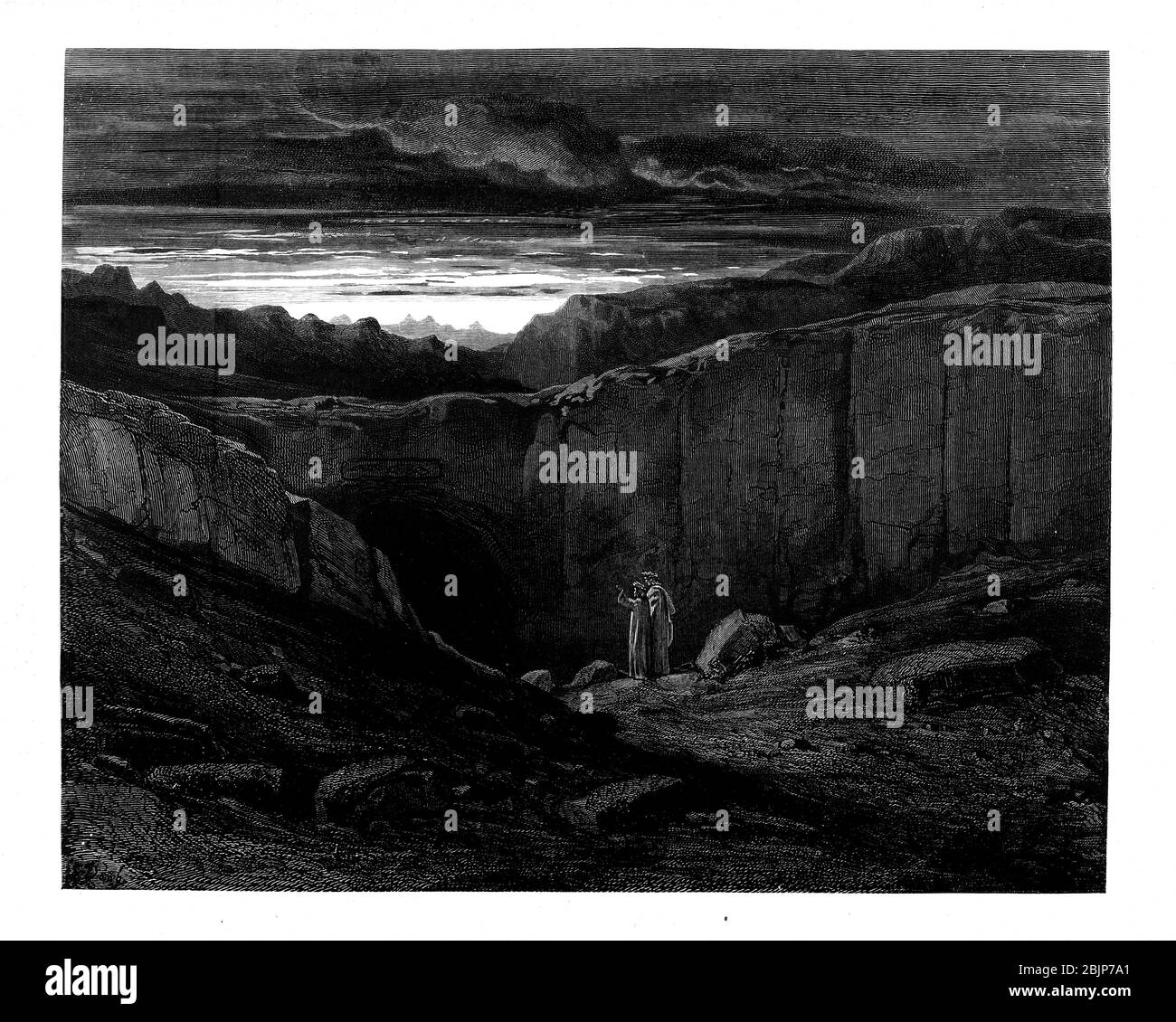 Virgil and Dante From the Divine Comedy by 14th century Italian poet Dante Alighieri. 1860 artwork, by French artist Gustave Dore and engraved by Stephane Pannemaker, from 'The Vision of Hell' (1868), Cary's English translation of the Inferno. Dante wrote his epic poem 'Divina Commedia' (The Divine Comedy) between 1308 and his death in 1321. Consisting of 14,233 lines, and divided into three parts (Inferno, Purgatorio, and Paradiso), it is considered the greatest literary work in the Italian language and a world masterpiece. It is a comprehensive survey of medieval theology, literature and tho Stock Photohttps://www.alamy.com/image-license-details/?v=1https://www.alamy.com/virgil-and-dante-from-the-divine-comedy-by-14th-century-italian-poet-dante-alighieri-1860-artwork-by-french-artist-gustave-dore-and-engraved-by-stephane-pannemaker-from-the-vision-of-hell-1868-carys-english-translation-of-the-inferno-dante-wrote-his-epic-poem-divina-commedia-the-divine-comedy-between-1308-and-his-death-in-1321-consisting-of-14233-lines-and-divided-into-three-parts-inferno-purgatorio-and-paradiso-it-is-considered-the-greatest-literary-work-in-the-italian-language-and-a-world-masterpiece-it-is-a-comprehensive-survey-of-medieval-theology-literature-and-tho-image355759881.html
Virgil and Dante From the Divine Comedy by 14th century Italian poet Dante Alighieri. 1860 artwork, by French artist Gustave Dore and engraved by Stephane Pannemaker, from 'The Vision of Hell' (1868), Cary's English translation of the Inferno. Dante wrote his epic poem 'Divina Commedia' (The Divine Comedy) between 1308 and his death in 1321. Consisting of 14,233 lines, and divided into three parts (Inferno, Purgatorio, and Paradiso), it is considered the greatest literary work in the Italian language and a world masterpiece. It is a comprehensive survey of medieval theology, literature and tho Stock Photohttps://www.alamy.com/image-license-details/?v=1https://www.alamy.com/virgil-and-dante-from-the-divine-comedy-by-14th-century-italian-poet-dante-alighieri-1860-artwork-by-french-artist-gustave-dore-and-engraved-by-stephane-pannemaker-from-the-vision-of-hell-1868-carys-english-translation-of-the-inferno-dante-wrote-his-epic-poem-divina-commedia-the-divine-comedy-between-1308-and-his-death-in-1321-consisting-of-14233-lines-and-divided-into-three-parts-inferno-purgatorio-and-paradiso-it-is-considered-the-greatest-literary-work-in-the-italian-language-and-a-world-masterpiece-it-is-a-comprehensive-survey-of-medieval-theology-literature-and-tho-image355759881.htmlRM2BJP7A1–Virgil and Dante From the Divine Comedy by 14th century Italian poet Dante Alighieri. 1860 artwork, by French artist Gustave Dore and engraved by Stephane Pannemaker, from 'The Vision of Hell' (1868), Cary's English translation of the Inferno. Dante wrote his epic poem 'Divina Commedia' (The Divine Comedy) between 1308 and his death in 1321. Consisting of 14,233 lines, and divided into three parts (Inferno, Purgatorio, and Paradiso), it is considered the greatest literary work in the Italian language and a world masterpiece. It is a comprehensive survey of medieval theology, literature and tho
 Illustration by Gustave Dore from The Vision of Purgatory and Paradise by Dante Alighieri Stock Photohttps://www.alamy.com/image-license-details/?v=1https://www.alamy.com/stock-photo-illustration-by-gustave-dore-from-the-vision-of-purgatory-and-paradise-50149828.html
Illustration by Gustave Dore from The Vision of Purgatory and Paradise by Dante Alighieri Stock Photohttps://www.alamy.com/image-license-details/?v=1https://www.alamy.com/stock-photo-illustration-by-gustave-dore-from-the-vision-of-purgatory-and-paradise-50149828.htmlRMCWGEH8–Illustration by Gustave Dore from The Vision of Purgatory and Paradise by Dante Alighieri
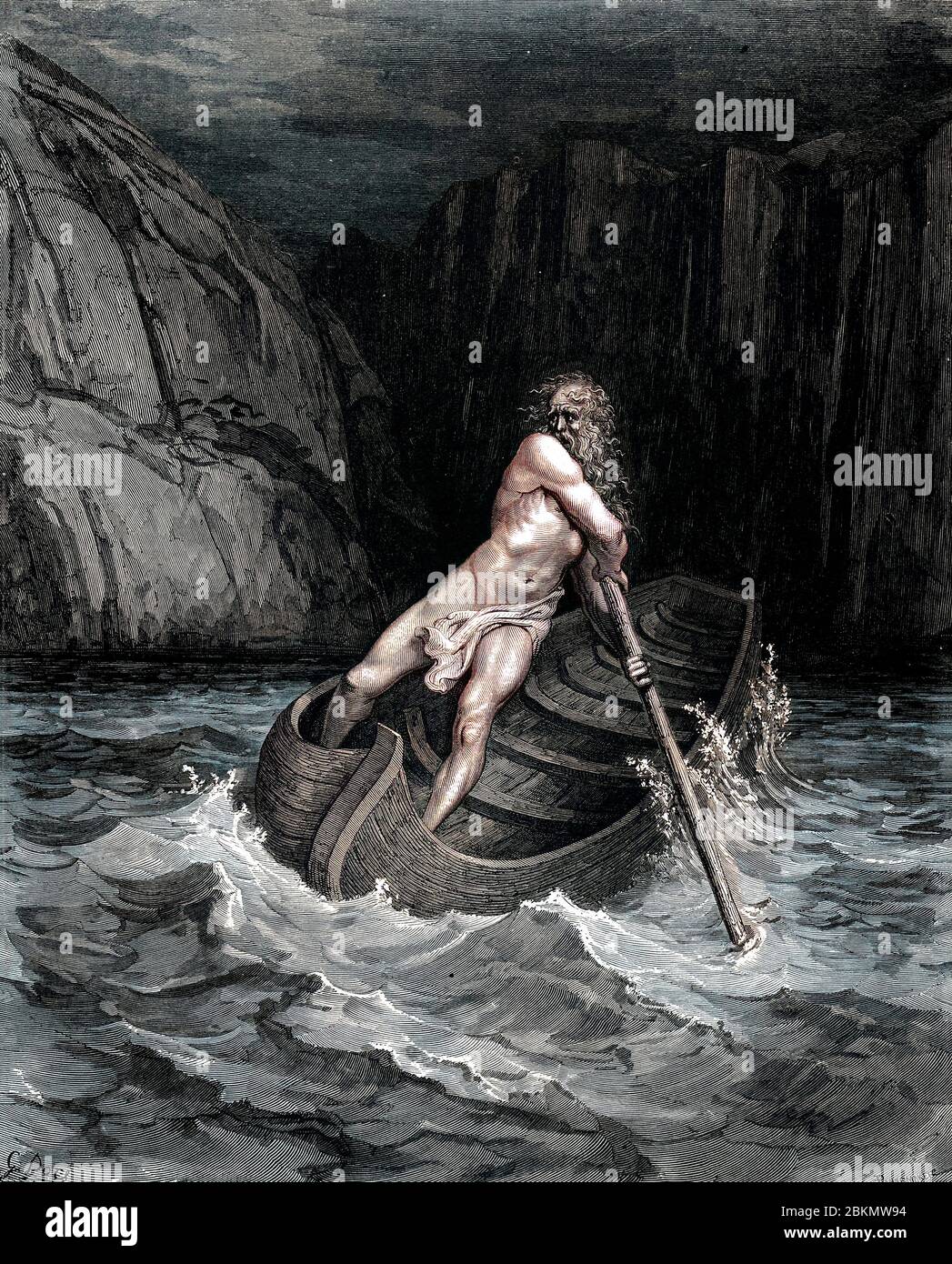 Machine colorized with Artificial Intelligence (AI) Charon the Ferryman crossing the River Achero From the Divine Comedy by 14th century Italian poet Dante Alighieri. 1860 artwork, by French artist Gustave Dore and engraved by Stephane Pannemaker, from 'The Vision of Hell' (1868), Cary's English translation of the Inferno. Dante wrote his epic poem 'Divina Commedia' (The Divine Comedy) between 1308 and his death in 1321. Consisting of 14,233 lines, and divided into three parts (Inferno, Purgatorio, and Paradiso), it is considered the greatest literary work in the Italian language and a world m Stock Photohttps://www.alamy.com/image-license-details/?v=1https://www.alamy.com/machine-colorized-with-artificial-intelligence-ai-charon-the-ferryman-crossing-the-river-achero-from-the-divine-comedy-by-14th-century-italian-poet-dante-alighieri-1860-artwork-by-french-artist-gustave-dore-and-engraved-by-stephane-pannemaker-from-the-vision-of-hell-1868-carys-english-translation-of-the-inferno-dante-wrote-his-epic-poem-divina-commedia-the-divine-comedy-between-1308-and-his-death-in-1321-consisting-of-14233-lines-and-divided-into-three-parts-inferno-purgatorio-and-paradiso-it-is-considered-the-greatest-literary-work-in-the-italian-language-and-a-world-m-image356344720.html
Machine colorized with Artificial Intelligence (AI) Charon the Ferryman crossing the River Achero From the Divine Comedy by 14th century Italian poet Dante Alighieri. 1860 artwork, by French artist Gustave Dore and engraved by Stephane Pannemaker, from 'The Vision of Hell' (1868), Cary's English translation of the Inferno. Dante wrote his epic poem 'Divina Commedia' (The Divine Comedy) between 1308 and his death in 1321. Consisting of 14,233 lines, and divided into three parts (Inferno, Purgatorio, and Paradiso), it is considered the greatest literary work in the Italian language and a world m Stock Photohttps://www.alamy.com/image-license-details/?v=1https://www.alamy.com/machine-colorized-with-artificial-intelligence-ai-charon-the-ferryman-crossing-the-river-achero-from-the-divine-comedy-by-14th-century-italian-poet-dante-alighieri-1860-artwork-by-french-artist-gustave-dore-and-engraved-by-stephane-pannemaker-from-the-vision-of-hell-1868-carys-english-translation-of-the-inferno-dante-wrote-his-epic-poem-divina-commedia-the-divine-comedy-between-1308-and-his-death-in-1321-consisting-of-14233-lines-and-divided-into-three-parts-inferno-purgatorio-and-paradiso-it-is-considered-the-greatest-literary-work-in-the-italian-language-and-a-world-m-image356344720.htmlRM2BKMW94–Machine colorized with Artificial Intelligence (AI) Charon the Ferryman crossing the River Achero From the Divine Comedy by 14th century Italian poet Dante Alighieri. 1860 artwork, by French artist Gustave Dore and engraved by Stephane Pannemaker, from 'The Vision of Hell' (1868), Cary's English translation of the Inferno. Dante wrote his epic poem 'Divina Commedia' (The Divine Comedy) between 1308 and his death in 1321. Consisting of 14,233 lines, and divided into three parts (Inferno, Purgatorio, and Paradiso), it is considered the greatest literary work in the Italian language and a world m
 The Heavenly Choir, by Gustave Doré, 1832 - 1883, French. Engraving for Paradiso by Dante. 1870, Art, Artist, Romanticism, Colour, Color Engraving Stock Photohttps://www.alamy.com/image-license-details/?v=1https://www.alamy.com/the-heavenly-choir-by-gustave-dor-1832-1883-french-engraving-for-paradiso-by-dante-1870-art-artist-romanticism-colour-color-engraving-image240632080.html
The Heavenly Choir, by Gustave Doré, 1832 - 1883, French. Engraving for Paradiso by Dante. 1870, Art, Artist, Romanticism, Colour, Color Engraving Stock Photohttps://www.alamy.com/image-license-details/?v=1https://www.alamy.com/the-heavenly-choir-by-gustave-dor-1832-1883-french-engraving-for-paradiso-by-dante-1870-art-artist-romanticism-colour-color-engraving-image240632080.htmlRMRYDMJT–The Heavenly Choir, by Gustave Doré, 1832 - 1883, French. Engraving for Paradiso by Dante. 1870, Art, Artist, Romanticism, Colour, Color Engraving
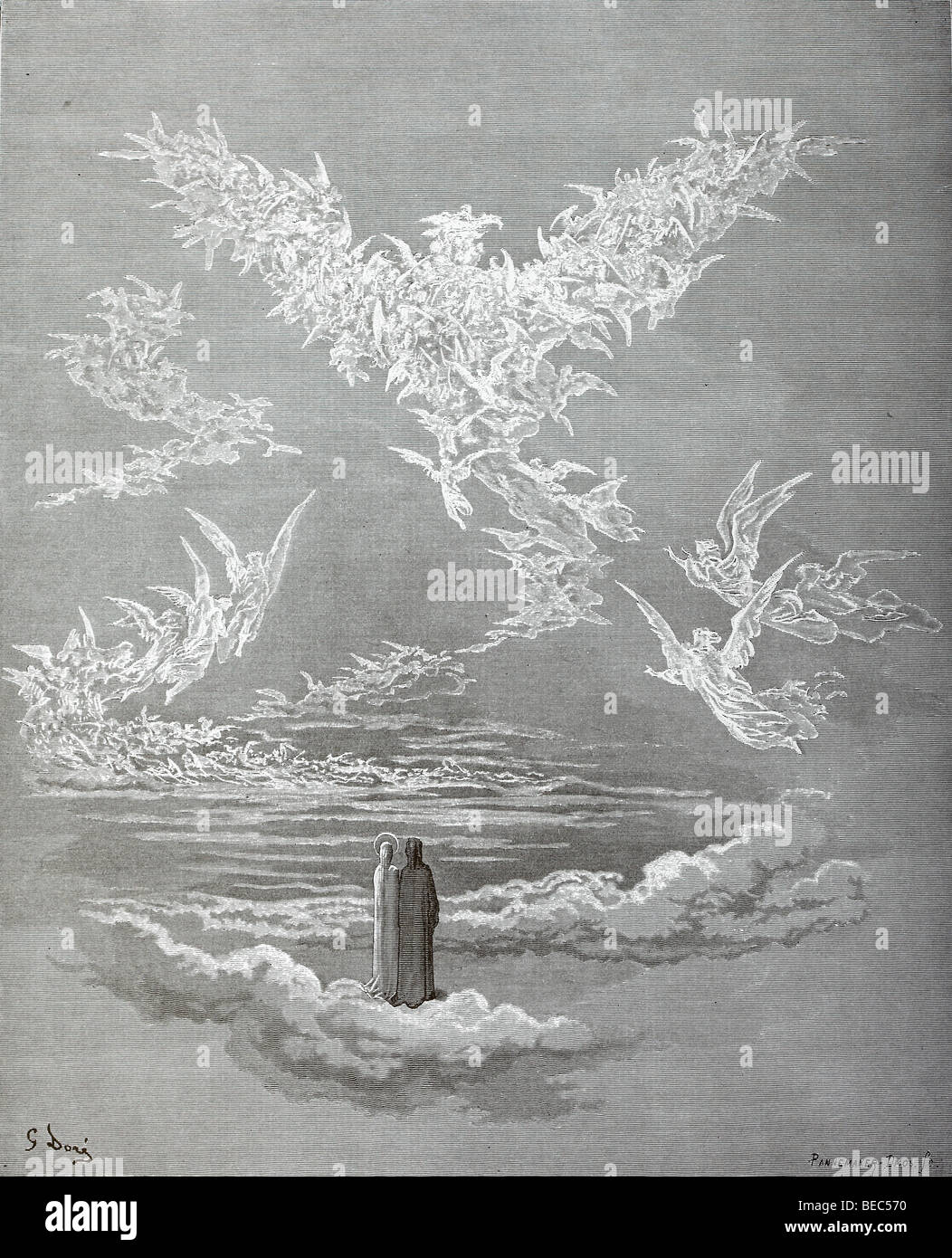 Gustave Dore's Illustration 'The Eagle' from Dante's Divine Comedy Stock Photohttps://www.alamy.com/image-license-details/?v=1https://www.alamy.com/stock-photo-gustave-dores-illustration-the-eagle-from-dantes-divine-comedy-26083092.html
Gustave Dore's Illustration 'The Eagle' from Dante's Divine Comedy Stock Photohttps://www.alamy.com/image-license-details/?v=1https://www.alamy.com/stock-photo-gustave-dores-illustration-the-eagle-from-dantes-divine-comedy-26083092.htmlRMBEC570–Gustave Dore's Illustration 'The Eagle' from Dante's Divine Comedy
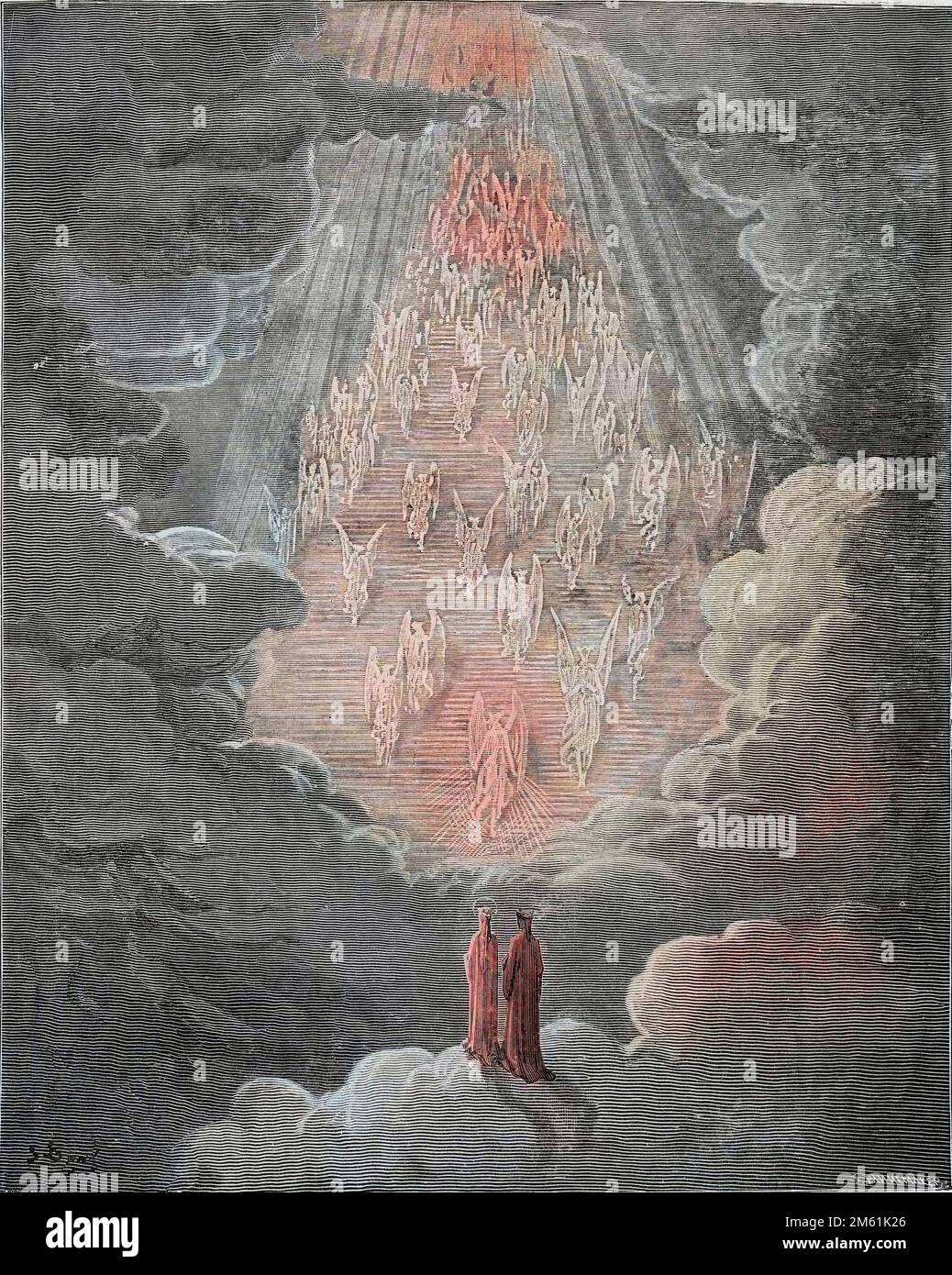 The Divine Comedy by Dante Alighieri , Paradiso, Canto 21 : Beatrice and Dante in the sphere of Saturn - by Dante Alighieri (1265-1321) - Illustration de Gustave Dore (1832-1883), 1885 - Colorisation digitale d'apres l'originale Stock Photohttps://www.alamy.com/image-license-details/?v=1https://www.alamy.com/the-divine-comedy-by-dante-alighieri-paradiso-canto-21-beatrice-and-dante-in-the-sphere-of-saturn-by-dante-alighieri-1265-1321-illustration-de-gustave-dore-1832-1883-1885-colorisation-digitale-dapres-loriginale-image502825518.html
The Divine Comedy by Dante Alighieri , Paradiso, Canto 21 : Beatrice and Dante in the sphere of Saturn - by Dante Alighieri (1265-1321) - Illustration de Gustave Dore (1832-1883), 1885 - Colorisation digitale d'apres l'originale Stock Photohttps://www.alamy.com/image-license-details/?v=1https://www.alamy.com/the-divine-comedy-by-dante-alighieri-paradiso-canto-21-beatrice-and-dante-in-the-sphere-of-saturn-by-dante-alighieri-1265-1321-illustration-de-gustave-dore-1832-1883-1885-colorisation-digitale-dapres-loriginale-image502825518.htmlRM2M61K26–The Divine Comedy by Dante Alighieri , Paradiso, Canto 21 : Beatrice and Dante in the sphere of Saturn - by Dante Alighieri (1265-1321) - Illustration de Gustave Dore (1832-1883), 1885 - Colorisation digitale d'apres l'originale
 Illustration für Paradiso, die Göttliche Komödie von Dante Alighieri Canto XX lines 10 to 12 von Gustave Dore 1832-1883, französischer Künstler, Inferno, Hölle, Paradies, Engel, Verdammnis, Historisch, digital restaurierte Reproduktion von einer Vorlage aus dem 19. Jahrhundert, Record date not stated Stock Photohttps://www.alamy.com/image-license-details/?v=1https://www.alamy.com/illustration-fr-paradiso-die-gttliche-komdie-von-dante-alighieri-canto-xx-lines-10-to-12-von-gustave-dore-1832-1883-franzsischer-knstler-inferno-hlle-paradies-engel-verdammnis-historisch-digital-restaurierte-reproduktion-von-einer-vorlage-aus-dem-19-jahrhundert-record-date-not-stated-image593318286.html
Illustration für Paradiso, die Göttliche Komödie von Dante Alighieri Canto XX lines 10 to 12 von Gustave Dore 1832-1883, französischer Künstler, Inferno, Hölle, Paradies, Engel, Verdammnis, Historisch, digital restaurierte Reproduktion von einer Vorlage aus dem 19. Jahrhundert, Record date not stated Stock Photohttps://www.alamy.com/image-license-details/?v=1https://www.alamy.com/illustration-fr-paradiso-die-gttliche-komdie-von-dante-alighieri-canto-xx-lines-10-to-12-von-gustave-dore-1832-1883-franzsischer-knstler-inferno-hlle-paradies-engel-verdammnis-historisch-digital-restaurierte-reproduktion-von-einer-vorlage-aus-dem-19-jahrhundert-record-date-not-stated-image593318286.htmlRF2WD7YEP–Illustration für Paradiso, die Göttliche Komödie von Dante Alighieri Canto XX lines 10 to 12 von Gustave Dore 1832-1883, französischer Künstler, Inferno, Hölle, Paradies, Engel, Verdammnis, Historisch, digital restaurierte Reproduktion von einer Vorlage aus dem 19. Jahrhundert, Record date not stated
 Divine Comedy. Epic poem written by Dante Alighieri between 1308 and his death in 1321. Paradise. XX Canto. The luminous souls sing. For that all those living lights, waxing in splendour, burst forth into songs, such as from memory glide and fall away. Engraving by Gustave Dore. Colored. Stock Photohttps://www.alamy.com/image-license-details/?v=1https://www.alamy.com/divine-comedy-epic-poem-written-by-dante-alighieri-between-1308-and-his-death-in-1321-paradise-xx-canto-the-luminous-souls-sing-for-that-all-those-living-lights-waxing-in-splendour-burst-forth-into-songs-such-as-from-memory-glide-and-fall-away-engraving-by-gustave-dore-colored-image220337802.html
Divine Comedy. Epic poem written by Dante Alighieri between 1308 and his death in 1321. Paradise. XX Canto. The luminous souls sing. For that all those living lights, waxing in splendour, burst forth into songs, such as from memory glide and fall away. Engraving by Gustave Dore. Colored. Stock Photohttps://www.alamy.com/image-license-details/?v=1https://www.alamy.com/divine-comedy-epic-poem-written-by-dante-alighieri-between-1308-and-his-death-in-1321-paradise-xx-canto-the-luminous-souls-sing-for-that-all-those-living-lights-waxing-in-splendour-burst-forth-into-songs-such-as-from-memory-glide-and-fall-away-engraving-by-gustave-dore-colored-image220337802.htmlRMPPD736–Divine Comedy. Epic poem written by Dante Alighieri between 1308 and his death in 1321. Paradise. XX Canto. The luminous souls sing. For that all those living lights, waxing in splendour, burst forth into songs, such as from memory glide and fall away. Engraving by Gustave Dore. Colored.
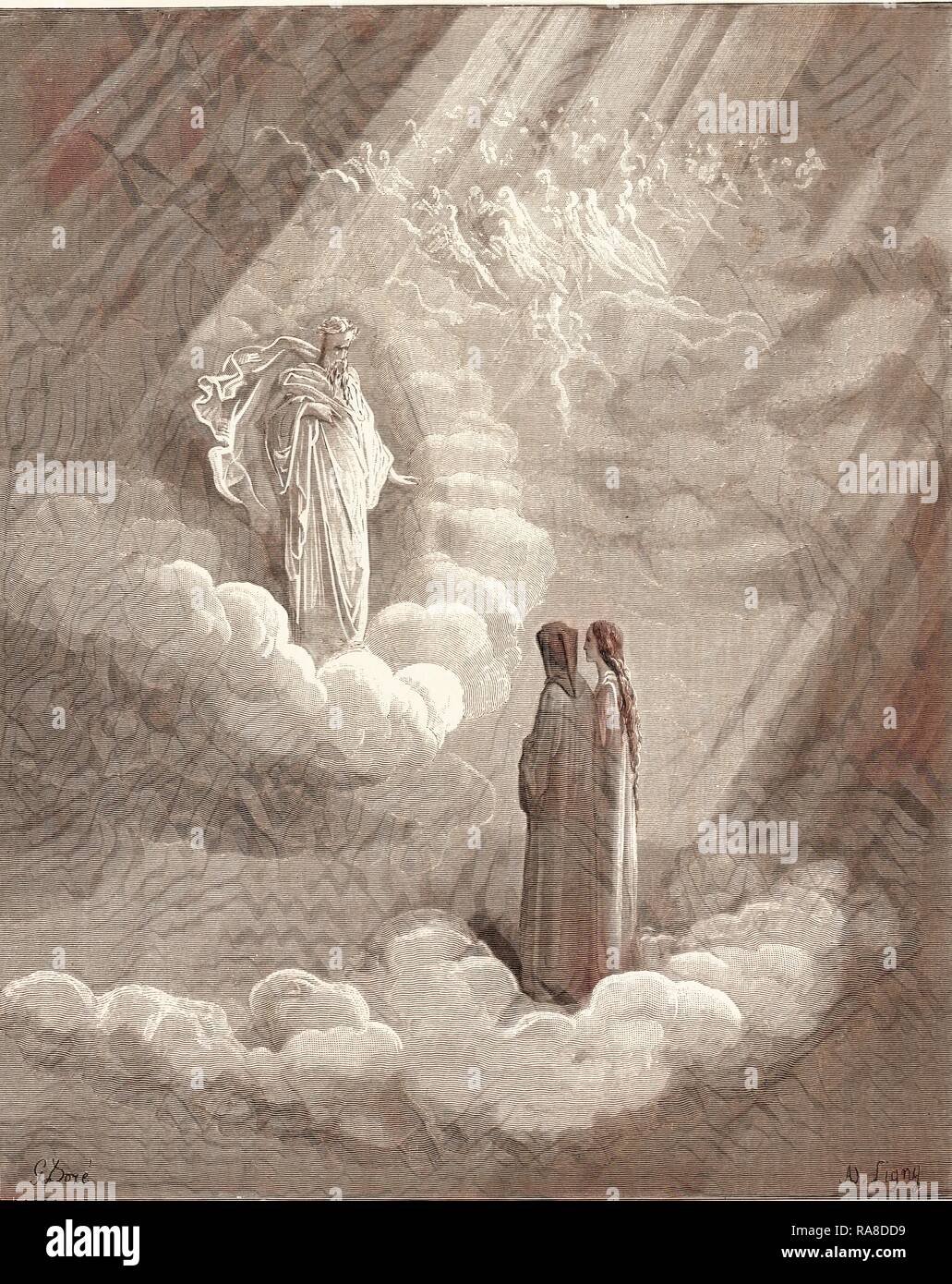 Dante's Ancestor. Reimagined by Gibon. Classic art with a modern twist reimagined Stock Photohttps://www.alamy.com/image-license-details/?v=1https://www.alamy.com/dantes-ancestor-reimagined-by-gibon-classic-art-with-a-modern-twist-reimagined-image230067525.html
Dante's Ancestor. Reimagined by Gibon. Classic art with a modern twist reimagined Stock Photohttps://www.alamy.com/image-license-details/?v=1https://www.alamy.com/dantes-ancestor-reimagined-by-gibon-classic-art-with-a-modern-twist-reimagined-image230067525.htmlRFRA8DD9–Dante's Ancestor. Reimagined by Gibon. Classic art with a modern twist reimagined
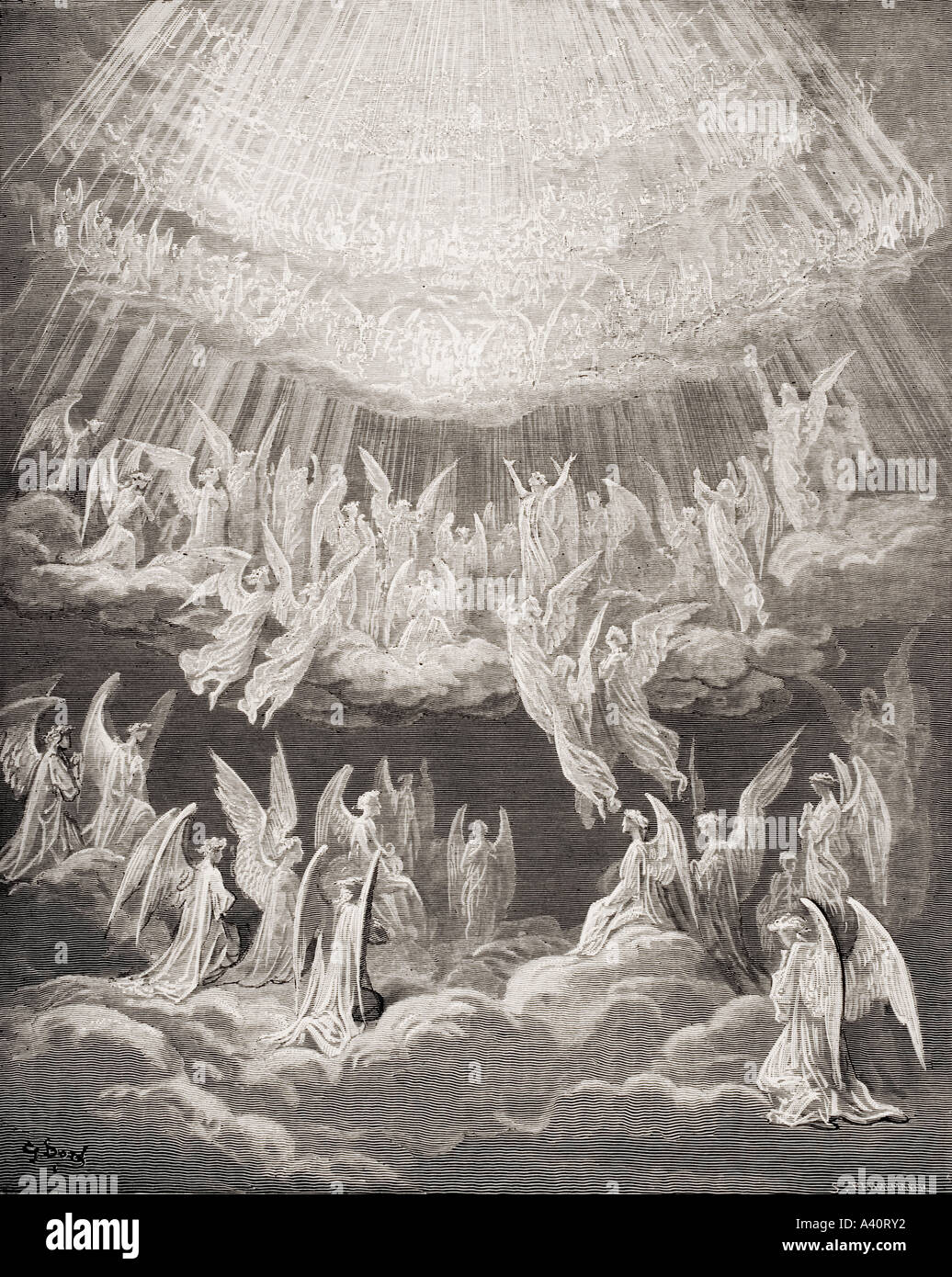 Illustration for Paradiso by Dante Alighieri. Canto XXVII, lines 1 to 4. Glory to the Father, to the Son and to the Holy Spirit, by Gustave Dore. Stock Photohttps://www.alamy.com/image-license-details/?v=1https://www.alamy.com/illustration-for-paradiso-by-dante-alighieri-canto-xxvii-lines-1-to-image6226417.html
Illustration for Paradiso by Dante Alighieri. Canto XXVII, lines 1 to 4. Glory to the Father, to the Son and to the Holy Spirit, by Gustave Dore. Stock Photohttps://www.alamy.com/image-license-details/?v=1https://www.alamy.com/illustration-for-paradiso-by-dante-alighieri-canto-xxvii-lines-1-to-image6226417.htmlRMA40RY2–Illustration for Paradiso by Dante Alighieri. Canto XXVII, lines 1 to 4. Glory to the Father, to the Son and to the Holy Spirit, by Gustave Dore.
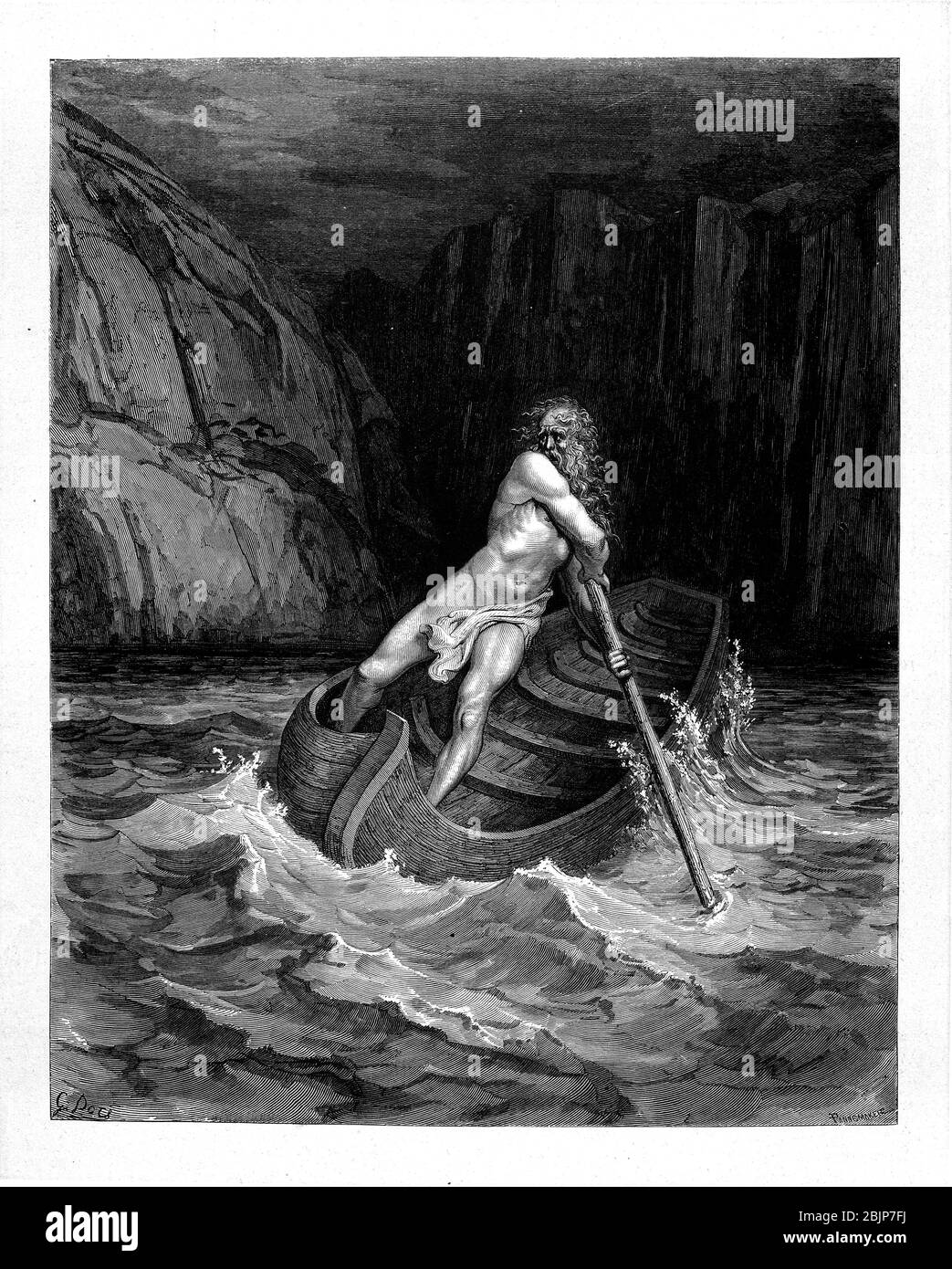 Charon the Ferryman crossing the River Achero From the Divine Comedy by 14th century Italian poet Dante Alighieri. 1860 artwork, by French artist Gustave Dore and engraved by Stephane Pannemaker, from 'The Vision of Hell' (1868), Cary's English translation of the Inferno. Dante wrote his epic poem 'Divina Commedia' (The Divine Comedy) between 1308 and his death in 1321. Consisting of 14,233 lines, and divided into three parts (Inferno, Purgatorio, and Paradiso), it is considered the greatest literary work in the Italian language and a world masterpiece. It is a comprehensive survey of medieval Stock Photohttps://www.alamy.com/image-license-details/?v=1https://www.alamy.com/charon-the-ferryman-crossing-the-river-achero-from-the-divine-comedy-by-14th-century-italian-poet-dante-alighieri-1860-artwork-by-french-artist-gustave-dore-and-engraved-by-stephane-pannemaker-from-the-vision-of-hell-1868-carys-english-translation-of-the-inferno-dante-wrote-his-epic-poem-divina-commedia-the-divine-comedy-between-1308-and-his-death-in-1321-consisting-of-14233-lines-and-divided-into-three-parts-inferno-purgatorio-and-paradiso-it-is-considered-the-greatest-literary-work-in-the-italian-language-and-a-world-masterpiece-it-is-a-comprehensive-survey-of-medieval-image355760038.html
Charon the Ferryman crossing the River Achero From the Divine Comedy by 14th century Italian poet Dante Alighieri. 1860 artwork, by French artist Gustave Dore and engraved by Stephane Pannemaker, from 'The Vision of Hell' (1868), Cary's English translation of the Inferno. Dante wrote his epic poem 'Divina Commedia' (The Divine Comedy) between 1308 and his death in 1321. Consisting of 14,233 lines, and divided into three parts (Inferno, Purgatorio, and Paradiso), it is considered the greatest literary work in the Italian language and a world masterpiece. It is a comprehensive survey of medieval Stock Photohttps://www.alamy.com/image-license-details/?v=1https://www.alamy.com/charon-the-ferryman-crossing-the-river-achero-from-the-divine-comedy-by-14th-century-italian-poet-dante-alighieri-1860-artwork-by-french-artist-gustave-dore-and-engraved-by-stephane-pannemaker-from-the-vision-of-hell-1868-carys-english-translation-of-the-inferno-dante-wrote-his-epic-poem-divina-commedia-the-divine-comedy-between-1308-and-his-death-in-1321-consisting-of-14233-lines-and-divided-into-three-parts-inferno-purgatorio-and-paradiso-it-is-considered-the-greatest-literary-work-in-the-italian-language-and-a-world-masterpiece-it-is-a-comprehensive-survey-of-medieval-image355760038.htmlRM2BJP7FJ–Charon the Ferryman crossing the River Achero From the Divine Comedy by 14th century Italian poet Dante Alighieri. 1860 artwork, by French artist Gustave Dore and engraved by Stephane Pannemaker, from 'The Vision of Hell' (1868), Cary's English translation of the Inferno. Dante wrote his epic poem 'Divina Commedia' (The Divine Comedy) between 1308 and his death in 1321. Consisting of 14,233 lines, and divided into three parts (Inferno, Purgatorio, and Paradiso), it is considered the greatest literary work in the Italian language and a world masterpiece. It is a comprehensive survey of medieval
 Illustration by Gustave Dore from The Vision of Purgatory and Paradise by Dante Alighieri Stock Photohttps://www.alamy.com/image-license-details/?v=1https://www.alamy.com/stock-photo-illustration-by-gustave-dore-from-the-vision-of-purgatory-and-paradise-50148832.html
Illustration by Gustave Dore from The Vision of Purgatory and Paradise by Dante Alighieri Stock Photohttps://www.alamy.com/image-license-details/?v=1https://www.alamy.com/stock-photo-illustration-by-gustave-dore-from-the-vision-of-purgatory-and-paradise-50148832.htmlRMCWGD9M–Illustration by Gustave Dore from The Vision of Purgatory and Paradise by Dante Alighieri
![Machine colorized iamge The Dark forest [abandon all hope ye who enter here] From the Divine Comedy by 14th century Italian poet Dante Alighieri. 1860 artwork, by French artist Gustave Dore and engraved by Stephane Pannemaker, from 'The Vision of Hell' (1868), Cary's English translation of the Inferno. Dante wrote his epic poem 'Divina Commedia' (The Divine Comedy) between 1308 and his death in 1321. Consisting of 14,233 lines, and divided into three parts (Inferno, Purgatorio, and Paradiso), it is considered the greatest literary work in the Italian language and a world masterpiece. It is a c Stock Photo Machine colorized iamge The Dark forest [abandon all hope ye who enter here] From the Divine Comedy by 14th century Italian poet Dante Alighieri. 1860 artwork, by French artist Gustave Dore and engraved by Stephane Pannemaker, from 'The Vision of Hell' (1868), Cary's English translation of the Inferno. Dante wrote his epic poem 'Divina Commedia' (The Divine Comedy) between 1308 and his death in 1321. Consisting of 14,233 lines, and divided into three parts (Inferno, Purgatorio, and Paradiso), it is considered the greatest literary work in the Italian language and a world masterpiece. It is a c Stock Photo](https://c8.alamy.com/comp/2GNB824/machine-colorized-iamge-the-dark-forest-abandon-all-hope-ye-who-enter-here-from-the-divine-comedy-by-14th-century-italian-poet-dante-alighieri-1860-artwork-by-french-artist-gustave-dore-and-engraved-by-stephane-pannemaker-from-the-vision-of-hell-1868-carys-english-translation-of-the-inferno-dante-wrote-his-epic-poem-divina-commedia-the-divine-comedy-between-1308-and-his-death-in-1321-consisting-of-14233-lines-and-divided-into-three-parts-inferno-purgatorio-and-paradiso-it-is-considered-the-greatest-literary-work-in-the-italian-language-and-a-world-masterpiece-it-is-a-c-2GNB824.jpg) Machine colorized iamge The Dark forest [abandon all hope ye who enter here] From the Divine Comedy by 14th century Italian poet Dante Alighieri. 1860 artwork, by French artist Gustave Dore and engraved by Stephane Pannemaker, from 'The Vision of Hell' (1868), Cary's English translation of the Inferno. Dante wrote his epic poem 'Divina Commedia' (The Divine Comedy) between 1308 and his death in 1321. Consisting of 14,233 lines, and divided into three parts (Inferno, Purgatorio, and Paradiso), it is considered the greatest literary work in the Italian language and a world masterpiece. It is a c Stock Photohttps://www.alamy.com/image-license-details/?v=1https://www.alamy.com/machine-colorized-iamge-the-dark-forest-abandon-all-hope-ye-who-enter-here-from-the-divine-comedy-by-14th-century-italian-poet-dante-alighieri-1860-artwork-by-french-artist-gustave-dore-and-engraved-by-stephane-pannemaker-from-the-vision-of-hell-1868-carys-english-translation-of-the-inferno-dante-wrote-his-epic-poem-divina-commedia-the-divine-comedy-between-1308-and-his-death-in-1321-consisting-of-14233-lines-and-divided-into-three-parts-inferno-purgatorio-and-paradiso-it-is-considered-the-greatest-literary-work-in-the-italian-language-and-a-world-masterpiece-it-is-a-c-image443414780.html
Machine colorized iamge The Dark forest [abandon all hope ye who enter here] From the Divine Comedy by 14th century Italian poet Dante Alighieri. 1860 artwork, by French artist Gustave Dore and engraved by Stephane Pannemaker, from 'The Vision of Hell' (1868), Cary's English translation of the Inferno. Dante wrote his epic poem 'Divina Commedia' (The Divine Comedy) between 1308 and his death in 1321. Consisting of 14,233 lines, and divided into three parts (Inferno, Purgatorio, and Paradiso), it is considered the greatest literary work in the Italian language and a world masterpiece. It is a c Stock Photohttps://www.alamy.com/image-license-details/?v=1https://www.alamy.com/machine-colorized-iamge-the-dark-forest-abandon-all-hope-ye-who-enter-here-from-the-divine-comedy-by-14th-century-italian-poet-dante-alighieri-1860-artwork-by-french-artist-gustave-dore-and-engraved-by-stephane-pannemaker-from-the-vision-of-hell-1868-carys-english-translation-of-the-inferno-dante-wrote-his-epic-poem-divina-commedia-the-divine-comedy-between-1308-and-his-death-in-1321-consisting-of-14233-lines-and-divided-into-three-parts-inferno-purgatorio-and-paradiso-it-is-considered-the-greatest-literary-work-in-the-italian-language-and-a-world-masterpiece-it-is-a-c-image443414780.htmlRM2GNB824–Machine colorized iamge The Dark forest [abandon all hope ye who enter here] From the Divine Comedy by 14th century Italian poet Dante Alighieri. 1860 artwork, by French artist Gustave Dore and engraved by Stephane Pannemaker, from 'The Vision of Hell' (1868), Cary's English translation of the Inferno. Dante wrote his epic poem 'Divina Commedia' (The Divine Comedy) between 1308 and his death in 1321. Consisting of 14,233 lines, and divided into three parts (Inferno, Purgatorio, and Paradiso), it is considered the greatest literary work in the Italian language and a world masterpiece. It is a c
 The Heavenly Choir, by Gustave Doré, 1832 - 1883, French. Engraving for Paradiso by Dante. 1870, Art, Artist, Romanticism Stock Photohttps://www.alamy.com/image-license-details/?v=1https://www.alamy.com/stock-photo-the-heavenly-choir-by-gustave-dor-1832-1883-french-engraving-for-paradiso-123369676.html
The Heavenly Choir, by Gustave Doré, 1832 - 1883, French. Engraving for Paradiso by Dante. 1870, Art, Artist, Romanticism Stock Photohttps://www.alamy.com/image-license-details/?v=1https://www.alamy.com/stock-photo-the-heavenly-choir-by-gustave-dor-1832-1883-french-engraving-for-paradiso-123369676.htmlRMH4KY7T–The Heavenly Choir, by Gustave Doré, 1832 - 1883, French. Engraving for Paradiso by Dante. 1870, Art, Artist, Romanticism
 Gustave Dore's Illustration 'Jupiter' from Dante's Divine Comedy Stock Photohttps://www.alamy.com/image-license-details/?v=1https://www.alamy.com/stock-photo-gustave-dores-illustration-jupiter-from-dantes-divine-comedy-26083054.html
Gustave Dore's Illustration 'Jupiter' from Dante's Divine Comedy Stock Photohttps://www.alamy.com/image-license-details/?v=1https://www.alamy.com/stock-photo-gustave-dores-illustration-jupiter-from-dantes-divine-comedy-26083054.htmlRMBEC55J–Gustave Dore's Illustration 'Jupiter' from Dante's Divine Comedy
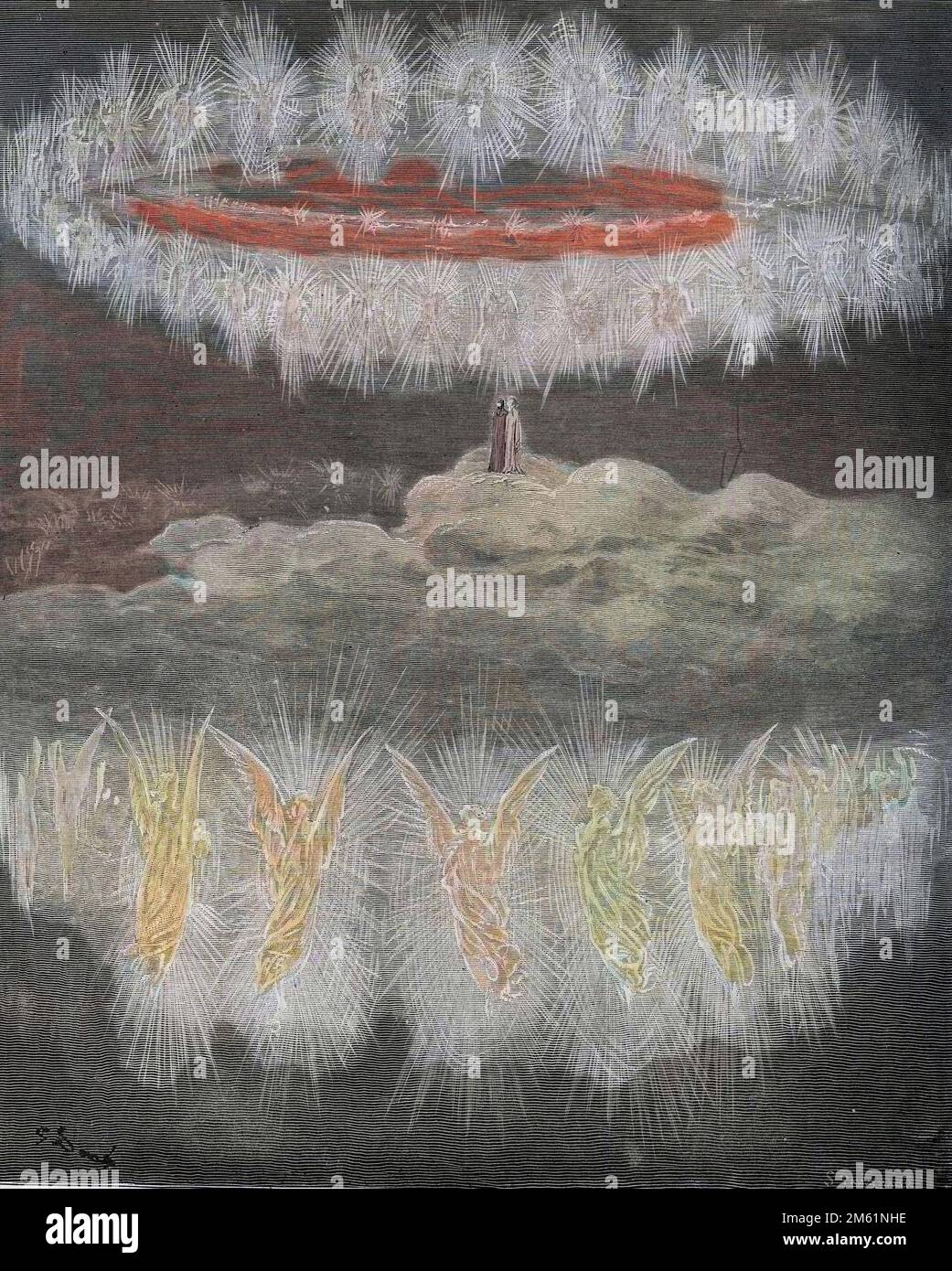 The Divine Comedy by Dante Alighieri , Paradiso, Canto 12 : The rings of glorified souls in the sun - by Dante Alighieri (1265-1321) - Illustration de Gustave Dore (1832-1883), 1885 - Colorisation digitale d'apres l'originale Stock Photohttps://www.alamy.com/image-license-details/?v=1https://www.alamy.com/the-divine-comedy-by-dante-alighieri-paradiso-canto-12-the-rings-of-glorified-souls-in-the-sun-by-dante-alighieri-1265-1321-illustration-de-gustave-dore-1832-1883-1885-colorisation-digitale-dapres-loriginale-image502827514.html
The Divine Comedy by Dante Alighieri , Paradiso, Canto 12 : The rings of glorified souls in the sun - by Dante Alighieri (1265-1321) - Illustration de Gustave Dore (1832-1883), 1885 - Colorisation digitale d'apres l'originale Stock Photohttps://www.alamy.com/image-license-details/?v=1https://www.alamy.com/the-divine-comedy-by-dante-alighieri-paradiso-canto-12-the-rings-of-glorified-souls-in-the-sun-by-dante-alighieri-1265-1321-illustration-de-gustave-dore-1832-1883-1885-colorisation-digitale-dapres-loriginale-image502827514.htmlRM2M61NHE–The Divine Comedy by Dante Alighieri , Paradiso, Canto 12 : The rings of glorified souls in the sun - by Dante Alighieri (1265-1321) - Illustration de Gustave Dore (1832-1883), 1885 - Colorisation digitale d'apres l'originale
 Illustration für Paradiso, die Göttliche Komödie von Dante Alighieri Canto, Ehre sei dem Vater, dem Sohn und dem Heiligen Geist, von Gustave Dore 1832-1883, französischer Künstler, Inferno, Hölle, Paradies, Engel, Verdammnis, Historisch, digital restaurierte Reproduktion von einer Vorlage aus dem 19. Jahrhundert, Record date not stated Stock Photohttps://www.alamy.com/image-license-details/?v=1https://www.alamy.com/illustration-fr-paradiso-die-gttliche-komdie-von-dante-alighieri-canto-ehre-sei-dem-vater-dem-sohn-und-dem-heiligen-geist-von-gustave-dore-1832-1883-franzsischer-knstler-inferno-hlle-paradies-engel-verdammnis-historisch-digital-restaurierte-reproduktion-von-einer-vorlage-aus-dem-19-jahrhundert-record-date-not-stated-image593318298.html
Illustration für Paradiso, die Göttliche Komödie von Dante Alighieri Canto, Ehre sei dem Vater, dem Sohn und dem Heiligen Geist, von Gustave Dore 1832-1883, französischer Künstler, Inferno, Hölle, Paradies, Engel, Verdammnis, Historisch, digital restaurierte Reproduktion von einer Vorlage aus dem 19. Jahrhundert, Record date not stated Stock Photohttps://www.alamy.com/image-license-details/?v=1https://www.alamy.com/illustration-fr-paradiso-die-gttliche-komdie-von-dante-alighieri-canto-ehre-sei-dem-vater-dem-sohn-und-dem-heiligen-geist-von-gustave-dore-1832-1883-franzsischer-knstler-inferno-hlle-paradies-engel-verdammnis-historisch-digital-restaurierte-reproduktion-von-einer-vorlage-aus-dem-19-jahrhundert-record-date-not-stated-image593318298.htmlRF2WD7YF6–Illustration für Paradiso, die Göttliche Komödie von Dante Alighieri Canto, Ehre sei dem Vater, dem Sohn und dem Heiligen Geist, von Gustave Dore 1832-1883, französischer Künstler, Inferno, Hölle, Paradies, Engel, Verdammnis, Historisch, digital restaurierte Reproduktion von einer Vorlage aus dem 19. Jahrhundert, Record date not stated
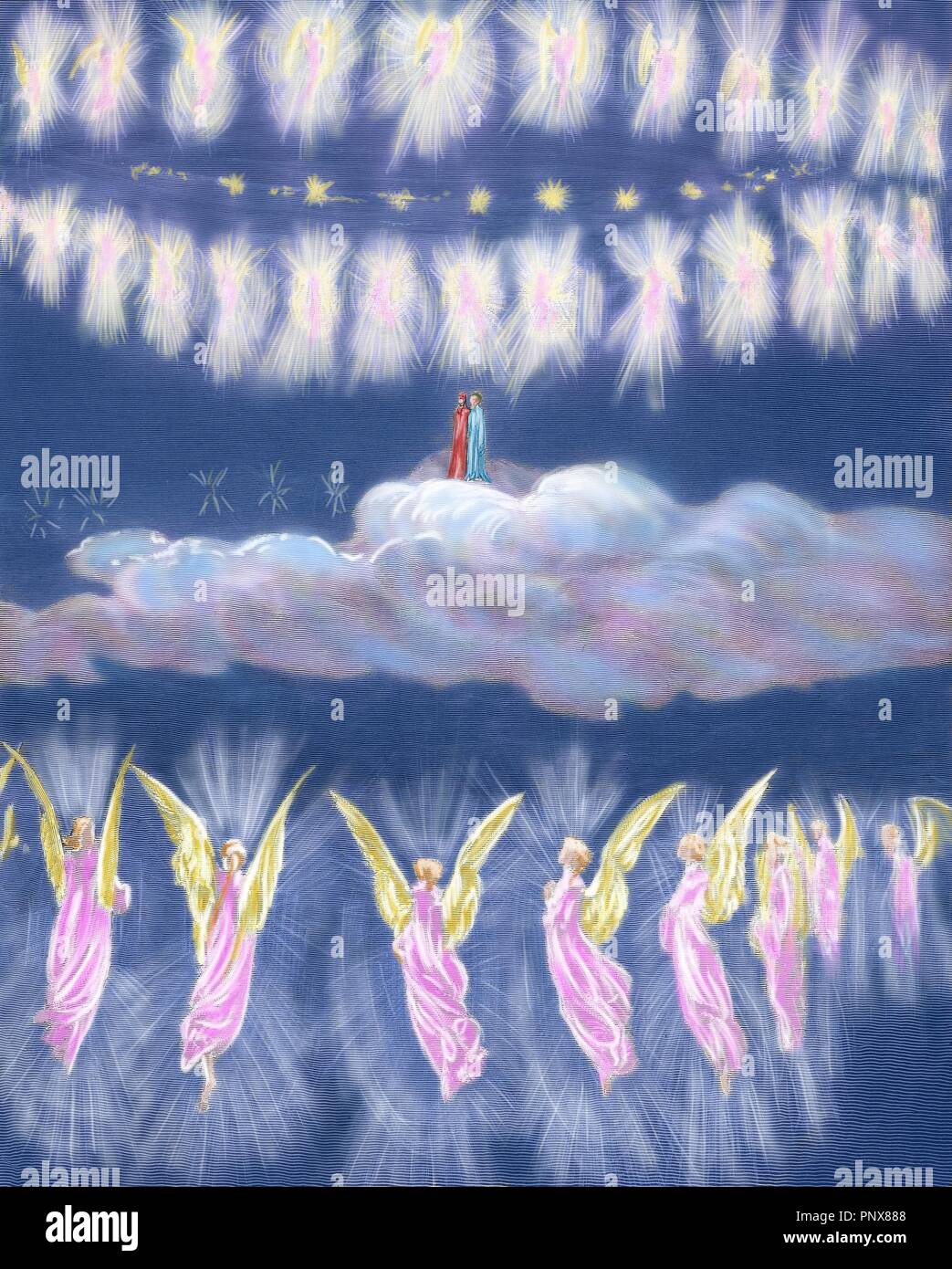 Divine Comedy. Epic poem written by Dante Alighieri between 1308 and his death in 1321. Paradise. XII Canto. Fourth heaven: the Sun, where the blessed are the souls of the wise and the Doctors of the Church, and are arranged in concentric circles of great splendor dancing around and singing. Engraving by Gustave Dore. Colored. Stock Photohttps://www.alamy.com/image-license-details/?v=1https://www.alamy.com/divine-comedy-epic-poem-written-by-dante-alighieri-between-1308-and-his-death-in-1321-paradise-xii-canto-fourth-heaven-the-sun-where-the-blessed-are-the-souls-of-the-wise-and-the-doctors-of-the-church-and-are-arranged-in-concentric-circles-of-great-splendor-dancing-around-and-singing-engraving-by-gustave-dore-colored-image220009448.html
Divine Comedy. Epic poem written by Dante Alighieri between 1308 and his death in 1321. Paradise. XII Canto. Fourth heaven: the Sun, where the blessed are the souls of the wise and the Doctors of the Church, and are arranged in concentric circles of great splendor dancing around and singing. Engraving by Gustave Dore. Colored. Stock Photohttps://www.alamy.com/image-license-details/?v=1https://www.alamy.com/divine-comedy-epic-poem-written-by-dante-alighieri-between-1308-and-his-death-in-1321-paradise-xii-canto-fourth-heaven-the-sun-where-the-blessed-are-the-souls-of-the-wise-and-the-doctors-of-the-church-and-are-arranged-in-concentric-circles-of-great-splendor-dancing-around-and-singing-engraving-by-gustave-dore-colored-image220009448.htmlRMPNX888–Divine Comedy. Epic poem written by Dante Alighieri between 1308 and his death in 1321. Paradise. XII Canto. Fourth heaven: the Sun, where the blessed are the souls of the wise and the Doctors of the Church, and are arranged in concentric circles of great splendor dancing around and singing. Engraving by Gustave Dore. Colored.
 The Ninth Heaven. Reimagined by Gibon. Classic art with a modern twist reimagined Stock Photohttps://www.alamy.com/image-license-details/?v=1https://www.alamy.com/the-ninth-heaven-reimagined-by-gibon-classic-art-with-a-modern-twist-reimagined-image230058896.html
The Ninth Heaven. Reimagined by Gibon. Classic art with a modern twist reimagined Stock Photohttps://www.alamy.com/image-license-details/?v=1https://www.alamy.com/the-ninth-heaven-reimagined-by-gibon-classic-art-with-a-modern-twist-reimagined-image230058896.htmlRFRA82D4–The Ninth Heaven. Reimagined by Gibon. Classic art with a modern twist reimagined
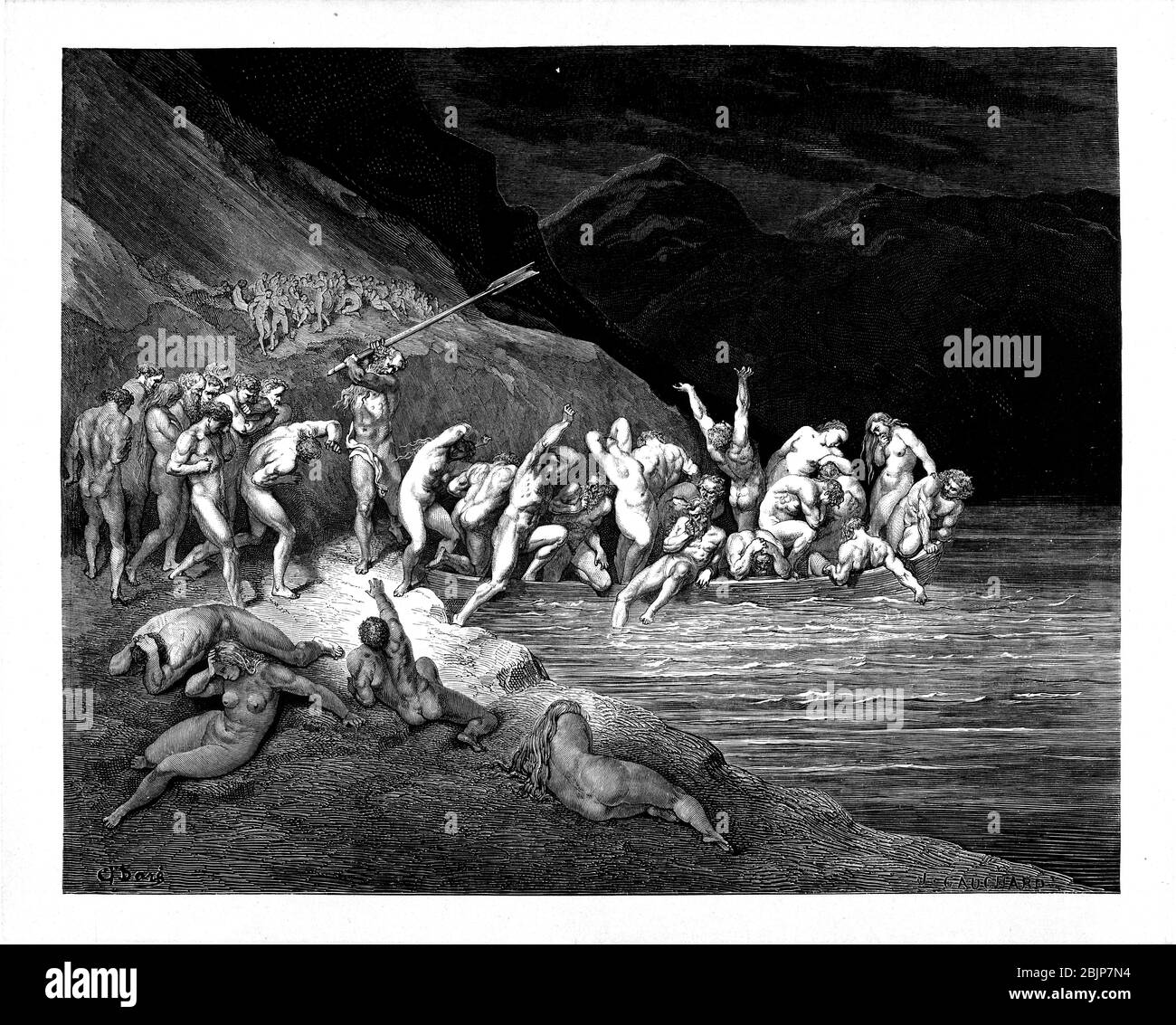 Charon herds the sinners onto his boat From the Divine Comedy by 14th century Italian poet Dante Alighieri. 1860 artwork, by French artist Gustave Dore and engraved by Stephane Pannemaker, from 'The Vision of Hell' (1868), Cary's English translation of the Inferno. Dante wrote his epic poem 'Divina Commedia' (The Divine Comedy) between 1308 and his death in 1321. Consisting of 14,233 lines, and divided into three parts (Inferno, Purgatorio, and Paradiso), it is considered the greatest literary work in the Italian language and a world masterpiece. It is a comprehensive survey of medieval theolo Stock Photohttps://www.alamy.com/image-license-details/?v=1https://www.alamy.com/charon-herds-the-sinners-onto-his-boat-from-the-divine-comedy-by-14th-century-italian-poet-dante-alighieri-1860-artwork-by-french-artist-gustave-dore-and-engraved-by-stephane-pannemaker-from-the-vision-of-hell-1868-carys-english-translation-of-the-inferno-dante-wrote-his-epic-poem-divina-commedia-the-divine-comedy-between-1308-and-his-death-in-1321-consisting-of-14233-lines-and-divided-into-three-parts-inferno-purgatorio-and-paradiso-it-is-considered-the-greatest-literary-work-in-the-italian-language-and-a-world-masterpiece-it-is-a-comprehensive-survey-of-medieval-theolo-image355760192.html
Charon herds the sinners onto his boat From the Divine Comedy by 14th century Italian poet Dante Alighieri. 1860 artwork, by French artist Gustave Dore and engraved by Stephane Pannemaker, from 'The Vision of Hell' (1868), Cary's English translation of the Inferno. Dante wrote his epic poem 'Divina Commedia' (The Divine Comedy) between 1308 and his death in 1321. Consisting of 14,233 lines, and divided into three parts (Inferno, Purgatorio, and Paradiso), it is considered the greatest literary work in the Italian language and a world masterpiece. It is a comprehensive survey of medieval theolo Stock Photohttps://www.alamy.com/image-license-details/?v=1https://www.alamy.com/charon-herds-the-sinners-onto-his-boat-from-the-divine-comedy-by-14th-century-italian-poet-dante-alighieri-1860-artwork-by-french-artist-gustave-dore-and-engraved-by-stephane-pannemaker-from-the-vision-of-hell-1868-carys-english-translation-of-the-inferno-dante-wrote-his-epic-poem-divina-commedia-the-divine-comedy-between-1308-and-his-death-in-1321-consisting-of-14233-lines-and-divided-into-three-parts-inferno-purgatorio-and-paradiso-it-is-considered-the-greatest-literary-work-in-the-italian-language-and-a-world-masterpiece-it-is-a-comprehensive-survey-of-medieval-theolo-image355760192.htmlRM2BJP7N4–Charon herds the sinners onto his boat From the Divine Comedy by 14th century Italian poet Dante Alighieri. 1860 artwork, by French artist Gustave Dore and engraved by Stephane Pannemaker, from 'The Vision of Hell' (1868), Cary's English translation of the Inferno. Dante wrote his epic poem 'Divina Commedia' (The Divine Comedy) between 1308 and his death in 1321. Consisting of 14,233 lines, and divided into three parts (Inferno, Purgatorio, and Paradiso), it is considered the greatest literary work in the Italian language and a world masterpiece. It is a comprehensive survey of medieval theolo
 Illustration by Gustave Dore from The Vision of Purgatory and Paradise by Dante Alighieri Stock Photohttps://www.alamy.com/image-license-details/?v=1https://www.alamy.com/stock-photo-illustration-by-gustave-dore-from-the-vision-of-purgatory-and-paradise-50149719.html
Illustration by Gustave Dore from The Vision of Purgatory and Paradise by Dante Alighieri Stock Photohttps://www.alamy.com/image-license-details/?v=1https://www.alamy.com/stock-photo-illustration-by-gustave-dore-from-the-vision-of-purgatory-and-paradise-50149719.htmlRMCWGEDB–Illustration by Gustave Dore from The Vision of Purgatory and Paradise by Dante Alighieri
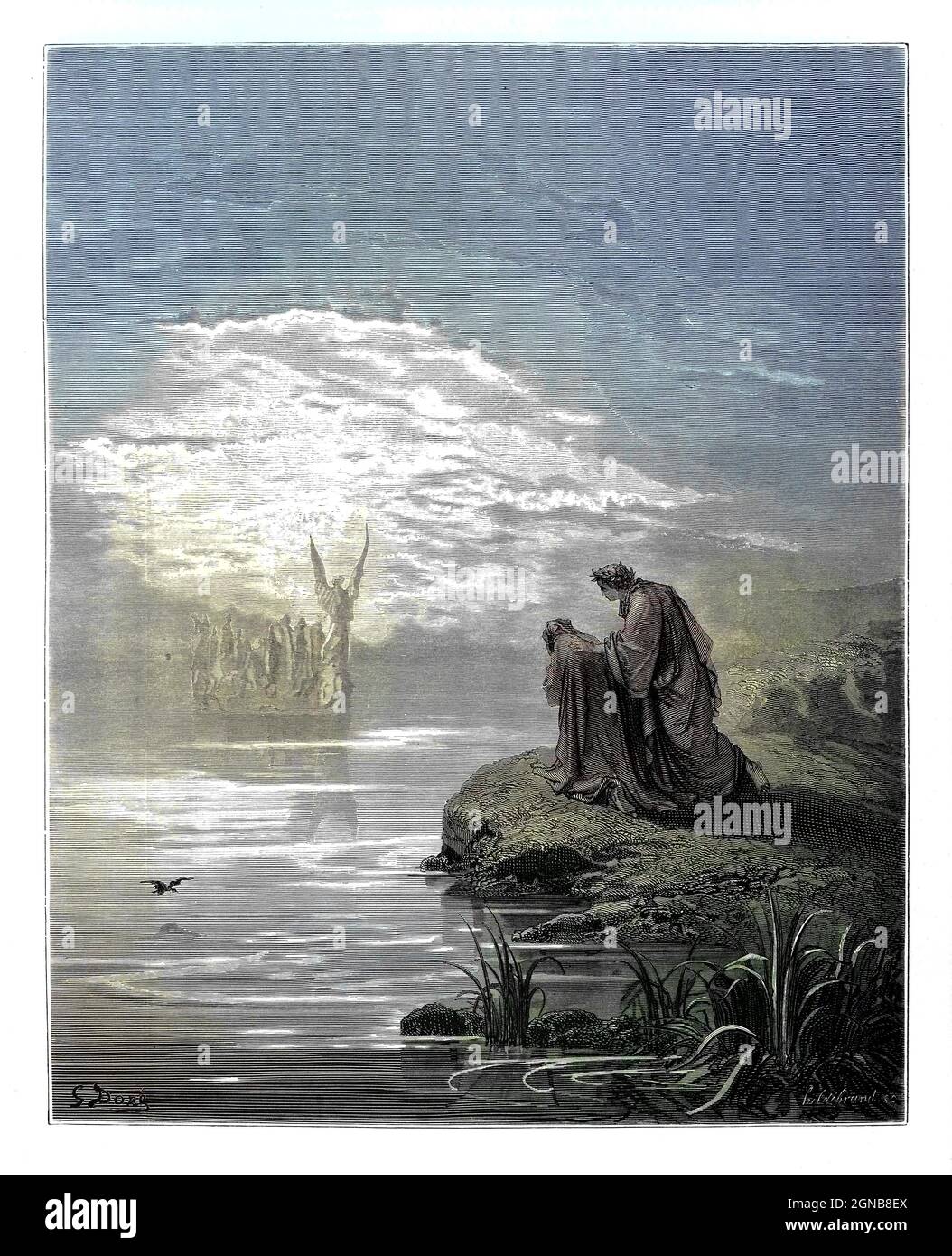 Machine colorised Purgatorio ('Purgatory') is the second part of Dante's Divine Comedy, following the Inferno, and preceding the Paradiso. The poem was written in the early 14th century. It is an allegory telling of the climb of Dante up the Mount of Purgatory, guided by the Roman poet Virgil, except for the last four cantos at which point Beatrice takes over as Dante's guide. Purgatory in the poem is depicted as a mountain in the Southern Hemisphere, consisting of a bottom section (Ante-Purgatory), seven levels of suffering and spiritual growth (associated with the seven deadly sins), and fin Stock Photohttps://www.alamy.com/image-license-details/?v=1https://www.alamy.com/machine-colorised-purgatorio-purgatory-is-the-second-part-of-dantes-divine-comedy-following-the-inferno-and-preceding-the-paradiso-the-poem-was-written-in-the-early-14th-century-it-is-an-allegory-telling-of-the-climb-of-dante-up-the-mount-of-purgatory-guided-by-the-roman-poet-virgil-except-for-the-last-four-cantos-at-which-point-beatrice-takes-over-as-dantes-guide-purgatory-in-the-poem-is-depicted-as-a-mountain-in-the-southern-hemisphere-consisting-of-a-bottom-section-ante-purgatory-seven-levels-of-suffering-and-spiritual-growth-associated-with-the-seven-deadly-sins-and-fin-image443415138.html
Machine colorised Purgatorio ('Purgatory') is the second part of Dante's Divine Comedy, following the Inferno, and preceding the Paradiso. The poem was written in the early 14th century. It is an allegory telling of the climb of Dante up the Mount of Purgatory, guided by the Roman poet Virgil, except for the last four cantos at which point Beatrice takes over as Dante's guide. Purgatory in the poem is depicted as a mountain in the Southern Hemisphere, consisting of a bottom section (Ante-Purgatory), seven levels of suffering and spiritual growth (associated with the seven deadly sins), and fin Stock Photohttps://www.alamy.com/image-license-details/?v=1https://www.alamy.com/machine-colorised-purgatorio-purgatory-is-the-second-part-of-dantes-divine-comedy-following-the-inferno-and-preceding-the-paradiso-the-poem-was-written-in-the-early-14th-century-it-is-an-allegory-telling-of-the-climb-of-dante-up-the-mount-of-purgatory-guided-by-the-roman-poet-virgil-except-for-the-last-four-cantos-at-which-point-beatrice-takes-over-as-dantes-guide-purgatory-in-the-poem-is-depicted-as-a-mountain-in-the-southern-hemisphere-consisting-of-a-bottom-section-ante-purgatory-seven-levels-of-suffering-and-spiritual-growth-associated-with-the-seven-deadly-sins-and-fin-image443415138.htmlRM2GNB8EX–Machine colorised Purgatorio ('Purgatory') is the second part of Dante's Divine Comedy, following the Inferno, and preceding the Paradiso. The poem was written in the early 14th century. It is an allegory telling of the climb of Dante up the Mount of Purgatory, guided by the Roman poet Virgil, except for the last four cantos at which point Beatrice takes over as Dante's guide. Purgatory in the poem is depicted as a mountain in the Southern Hemisphere, consisting of a bottom section (Ante-Purgatory), seven levels of suffering and spiritual growth (associated with the seven deadly sins), and fin
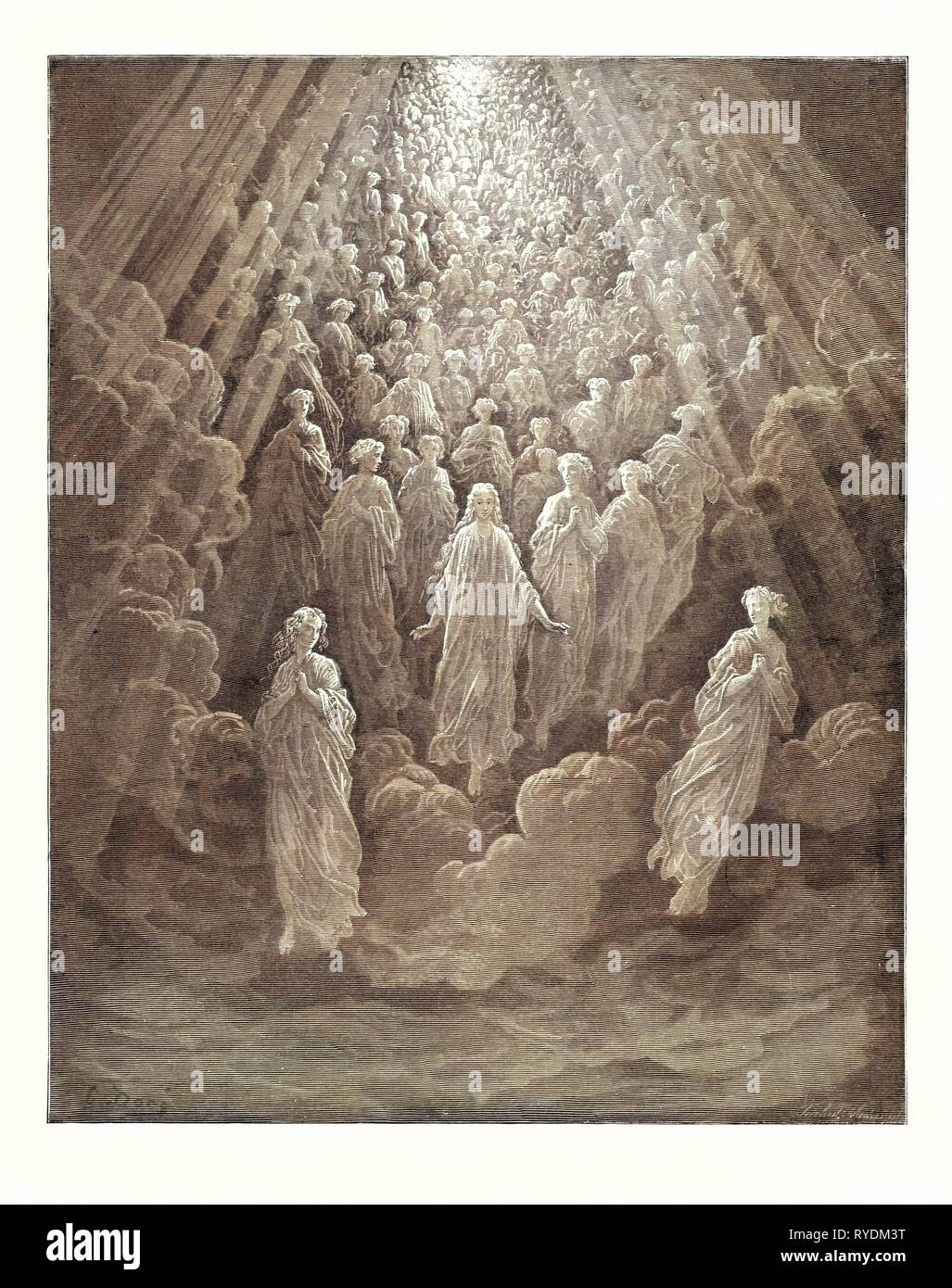 The Angels in the Planet Mercury, by Gustave Doré, 1832 - 1883, French. Engraving for Paradiso by Dante. 1870, Art, Artist, Romanticism, Colour, Color Engraving Stock Photohttps://www.alamy.com/image-license-details/?v=1https://www.alamy.com/the-angels-in-the-planet-mercury-by-gustave-dor-1832-1883-french-engraving-for-paradiso-by-dante-1870-art-artist-romanticism-colour-color-engraving-image240631660.html
The Angels in the Planet Mercury, by Gustave Doré, 1832 - 1883, French. Engraving for Paradiso by Dante. 1870, Art, Artist, Romanticism, Colour, Color Engraving Stock Photohttps://www.alamy.com/image-license-details/?v=1https://www.alamy.com/the-angels-in-the-planet-mercury-by-gustave-dor-1832-1883-french-engraving-for-paradiso-by-dante-1870-art-artist-romanticism-colour-color-engraving-image240631660.htmlRMRYDM3T–The Angels in the Planet Mercury, by Gustave Doré, 1832 - 1883, French. Engraving for Paradiso by Dante. 1870, Art, Artist, Romanticism, Colour, Color Engraving
 Gustave Dore's Illustration 'The Eagle' from Dante's Divine Comedy Stock Photohttps://www.alamy.com/image-license-details/?v=1https://www.alamy.com/stock-photo-gustave-dores-illustration-the-eagle-from-dantes-divine-comedy-26083112.html
Gustave Dore's Illustration 'The Eagle' from Dante's Divine Comedy Stock Photohttps://www.alamy.com/image-license-details/?v=1https://www.alamy.com/stock-photo-gustave-dores-illustration-the-eagle-from-dantes-divine-comedy-26083112.htmlRMBEC57M–Gustave Dore's Illustration 'The Eagle' from Dante's Divine Comedy
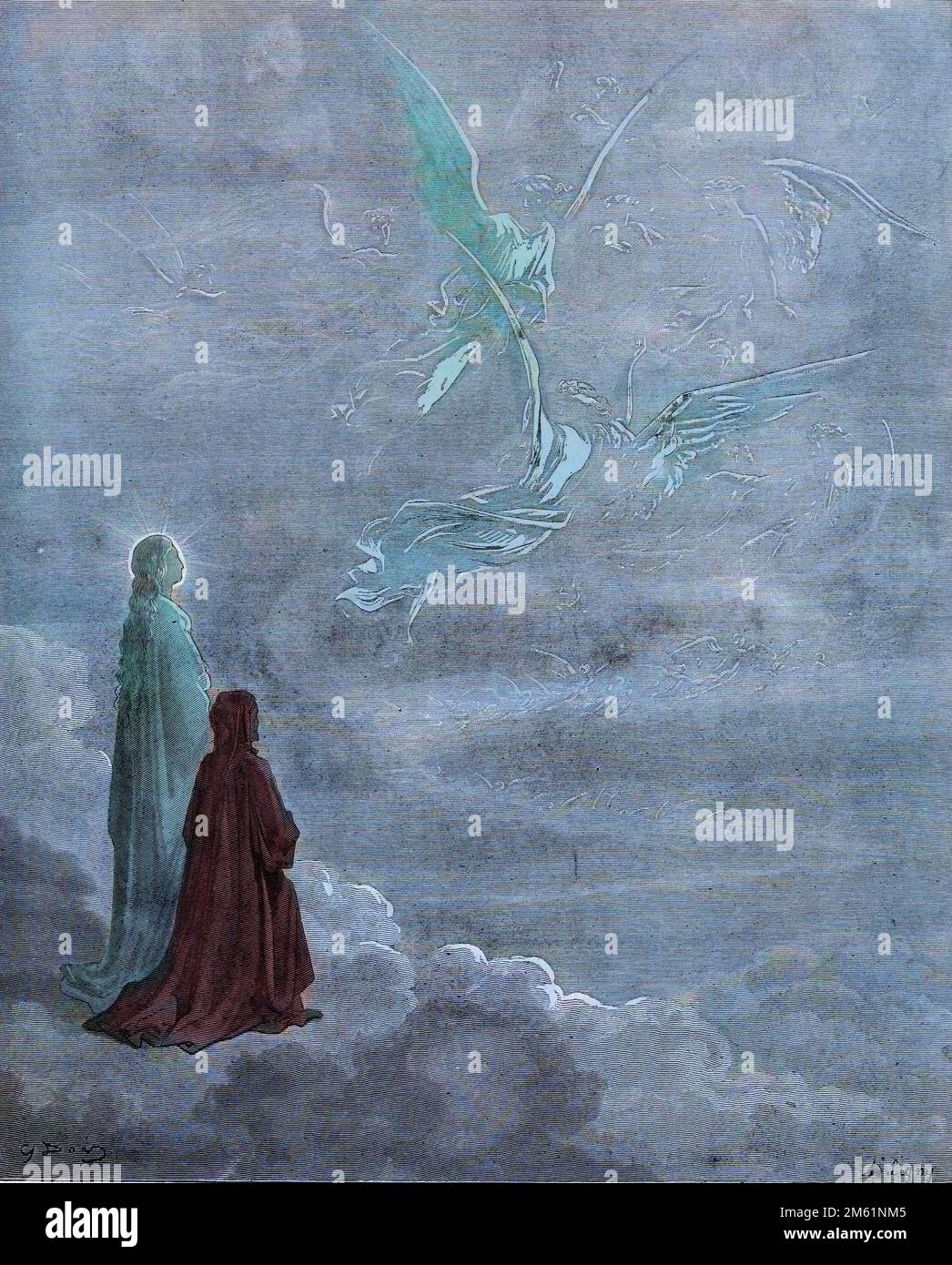 The Divine Comedy by Dante Alighieri , Paradiso, Canto 18 : Dante and Beatrice translated to the sphere of Jupiter - by Dante Alighieri (1265-1321) - Illustration de Gustave Dore (1832-1883), 1885 - Colorisation digitale d'apres l'originale Stock Photohttps://www.alamy.com/image-license-details/?v=1https://www.alamy.com/the-divine-comedy-by-dante-alighieri-paradiso-canto-18-dante-and-beatrice-translated-to-the-sphere-of-jupiter-by-dante-alighieri-1265-1321-illustration-de-gustave-dore-1832-1883-1885-colorisation-digitale-dapres-loriginale-image502827589.html
The Divine Comedy by Dante Alighieri , Paradiso, Canto 18 : Dante and Beatrice translated to the sphere of Jupiter - by Dante Alighieri (1265-1321) - Illustration de Gustave Dore (1832-1883), 1885 - Colorisation digitale d'apres l'originale Stock Photohttps://www.alamy.com/image-license-details/?v=1https://www.alamy.com/the-divine-comedy-by-dante-alighieri-paradiso-canto-18-dante-and-beatrice-translated-to-the-sphere-of-jupiter-by-dante-alighieri-1265-1321-illustration-de-gustave-dore-1832-1883-1885-colorisation-digitale-dapres-loriginale-image502827589.htmlRM2M61NM5–The Divine Comedy by Dante Alighieri , Paradiso, Canto 18 : Dante and Beatrice translated to the sphere of Jupiter - by Dante Alighieri (1265-1321) - Illustration de Gustave Dore (1832-1883), 1885 - Colorisation digitale d'apres l'originale
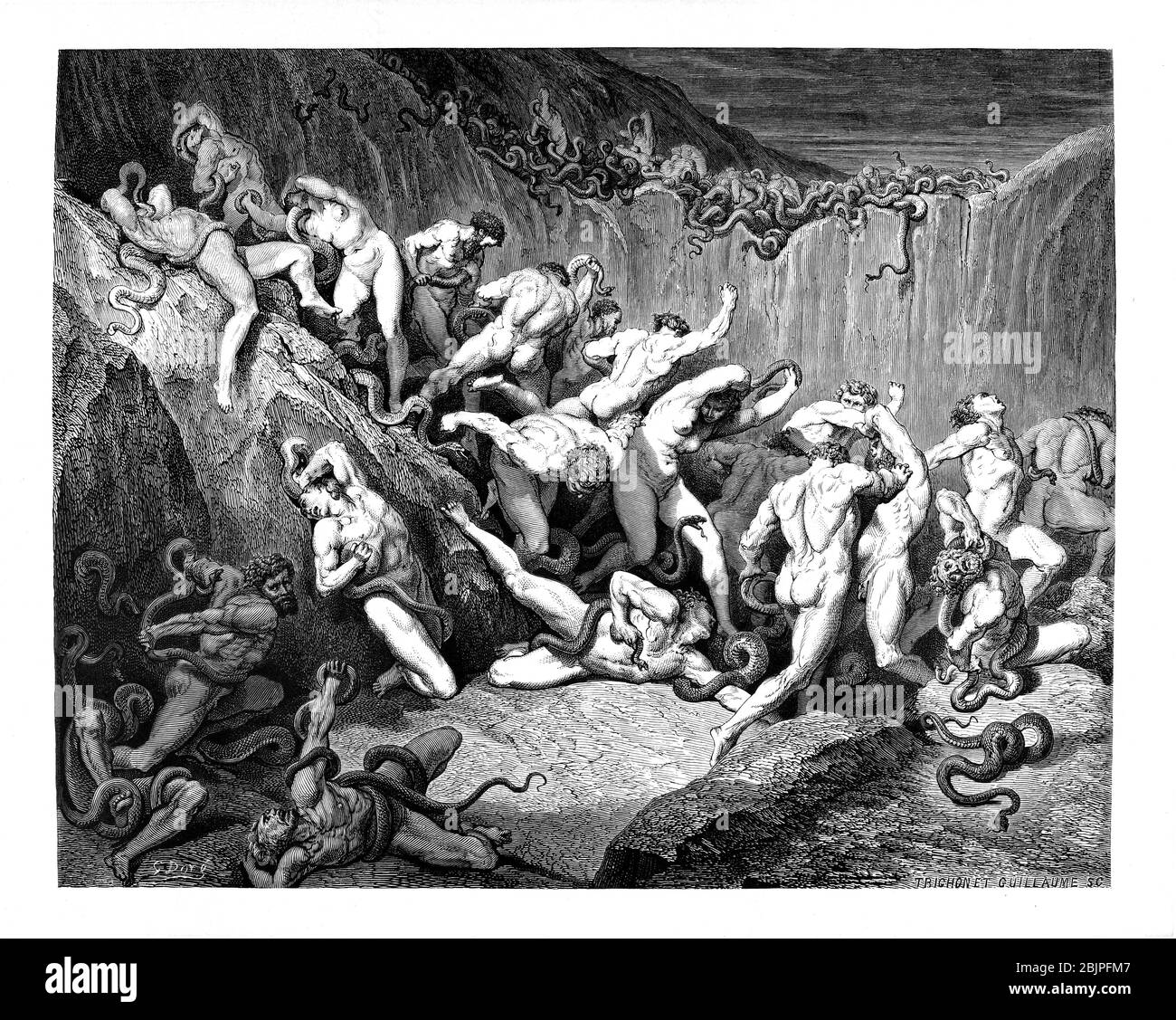 From the Divine Comedy by 14th century Italian poet Dante Alighieri. 1860 artwork, by French artist Gustave Dore and engraved by Stephane Pannemaker, from 'The Vision of Hell' (1868), Cary's English translation of the Inferno. Dante wrote his epic poem 'Divina Commedia' (The Divine Comedy) between 1308 and his death in 1321. Consisting of 14,233 lines, and divided into three parts (Inferno, Purgatorio, and Paradiso), it is considered the greatest literary work in the Italian language and a world masterpiece. It is a comprehensive survey of medieval theology, literature and thought. The new non Stock Photohttps://www.alamy.com/image-license-details/?v=1https://www.alamy.com/from-the-divine-comedy-by-14th-century-italian-poet-dante-alighieri-1860-artwork-by-french-artist-gustave-dore-and-engraved-by-stephane-pannemaker-from-the-vision-of-hell-1868-carys-english-translation-of-the-inferno-dante-wrote-his-epic-poem-divina-commedia-the-divine-comedy-between-1308-and-his-death-in-1321-consisting-of-14233-lines-and-divided-into-three-parts-inferno-purgatorio-and-paradiso-it-is-considered-the-greatest-literary-work-in-the-italian-language-and-a-world-masterpiece-it-is-a-comprehensive-survey-of-medieval-theology-literature-and-thought-the-new-non-image355766439.html
From the Divine Comedy by 14th century Italian poet Dante Alighieri. 1860 artwork, by French artist Gustave Dore and engraved by Stephane Pannemaker, from 'The Vision of Hell' (1868), Cary's English translation of the Inferno. Dante wrote his epic poem 'Divina Commedia' (The Divine Comedy) between 1308 and his death in 1321. Consisting of 14,233 lines, and divided into three parts (Inferno, Purgatorio, and Paradiso), it is considered the greatest literary work in the Italian language and a world masterpiece. It is a comprehensive survey of medieval theology, literature and thought. The new non Stock Photohttps://www.alamy.com/image-license-details/?v=1https://www.alamy.com/from-the-divine-comedy-by-14th-century-italian-poet-dante-alighieri-1860-artwork-by-french-artist-gustave-dore-and-engraved-by-stephane-pannemaker-from-the-vision-of-hell-1868-carys-english-translation-of-the-inferno-dante-wrote-his-epic-poem-divina-commedia-the-divine-comedy-between-1308-and-his-death-in-1321-consisting-of-14233-lines-and-divided-into-three-parts-inferno-purgatorio-and-paradiso-it-is-considered-the-greatest-literary-work-in-the-italian-language-and-a-world-masterpiece-it-is-a-comprehensive-survey-of-medieval-theology-literature-and-thought-the-new-non-image355766439.htmlRM2BJPFM7–From the Divine Comedy by 14th century Italian poet Dante Alighieri. 1860 artwork, by French artist Gustave Dore and engraved by Stephane Pannemaker, from 'The Vision of Hell' (1868), Cary's English translation of the Inferno. Dante wrote his epic poem 'Divina Commedia' (The Divine Comedy) between 1308 and his death in 1321. Consisting of 14,233 lines, and divided into three parts (Inferno, Purgatorio, and Paradiso), it is considered the greatest literary work in the Italian language and a world masterpiece. It is a comprehensive survey of medieval theology, literature and thought. The new non
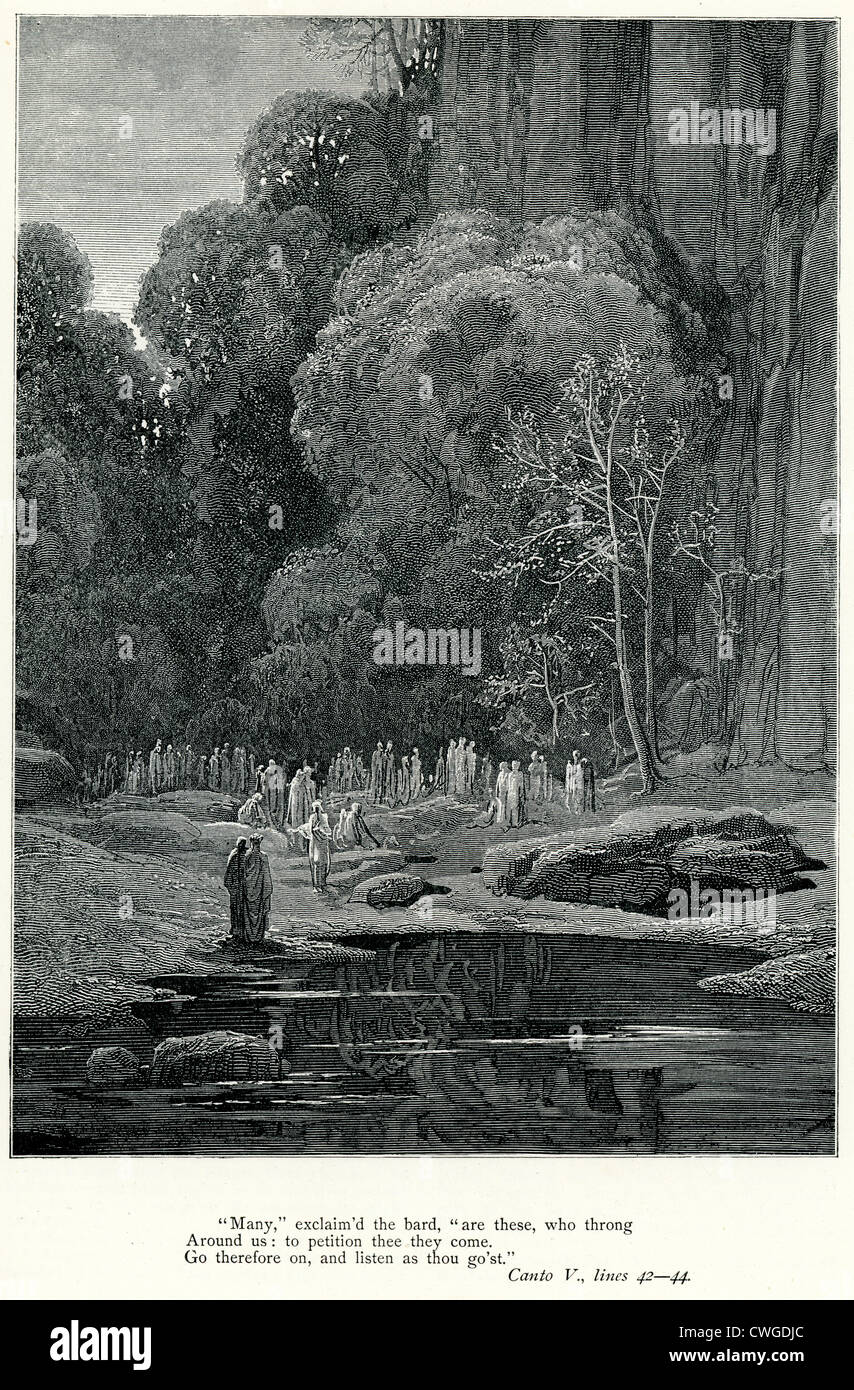 Illustration by Gustave Dore from The Vision of Purgatory and Paradise by Dante Alighieri Stock Photohttps://www.alamy.com/image-license-details/?v=1https://www.alamy.com/stock-photo-illustration-by-gustave-dore-from-the-vision-of-purgatory-and-paradise-50149076.html
Illustration by Gustave Dore from The Vision of Purgatory and Paradise by Dante Alighieri Stock Photohttps://www.alamy.com/image-license-details/?v=1https://www.alamy.com/stock-photo-illustration-by-gustave-dore-from-the-vision-of-purgatory-and-paradise-50149076.htmlRMCWGDJC–Illustration by Gustave Dore from The Vision of Purgatory and Paradise by Dante Alighieri
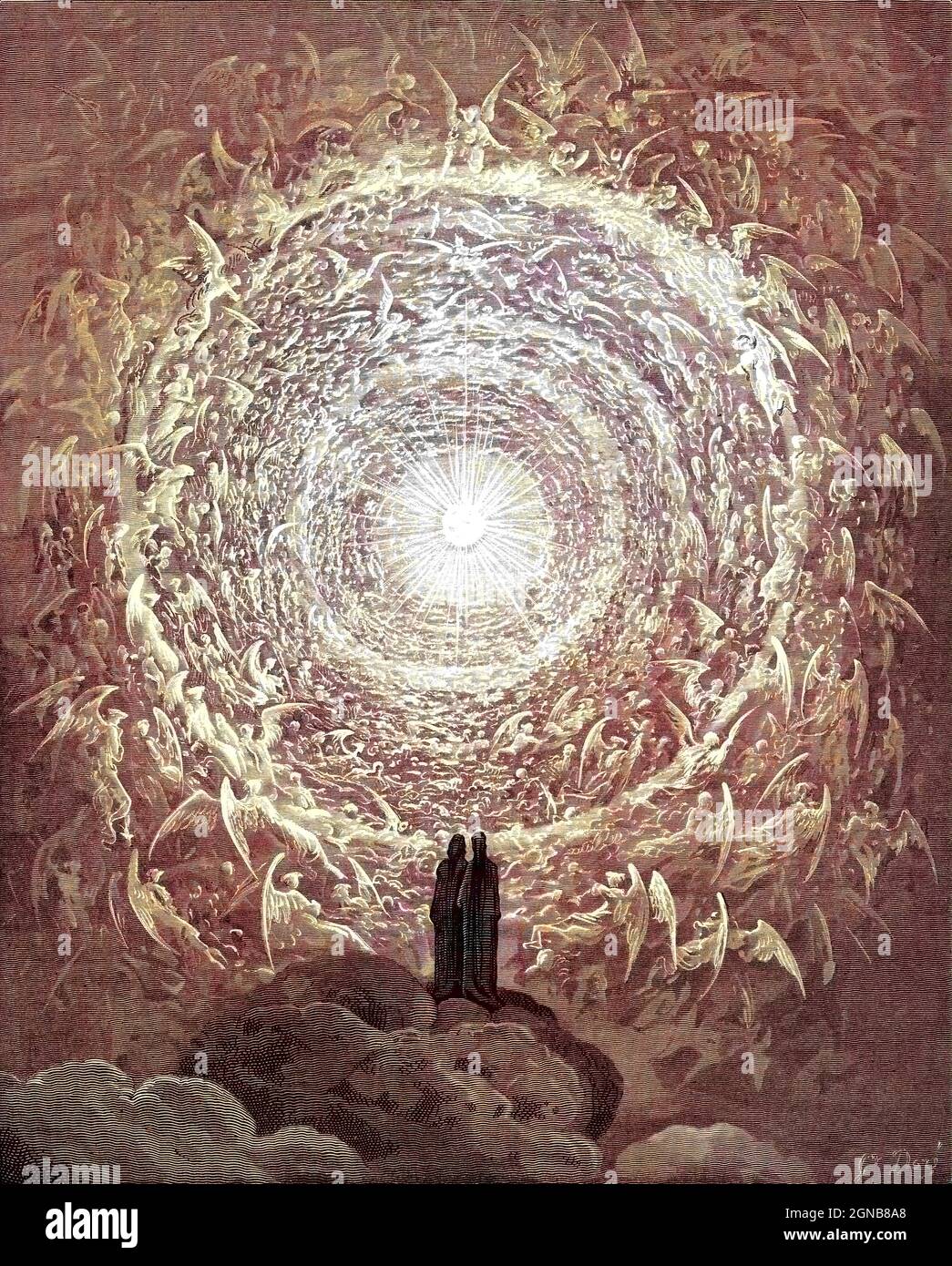 Machine Colourised Paradiso ('Paradise' or 'Heaven') is the third and final part of Dante's Divine Comedy, following the Inferno and the Purgatorio. It is an allegory telling of Dante's journey through Heaven, guided by Beatrice, who symbolises theology. In the poem, Paradise is depicted as a series of concentric spheres surrounding the Earth, consisting of the Moon, Mercury, Venus, the Sun, Mars, Jupiter, Saturn, the Fixed Stars, the Primum Mobile and finally, the Empyrean. It was written in the early 14th century. Allegorically, the poem represents the soul's ascent to God. From the Divine Stock Photohttps://www.alamy.com/image-license-details/?v=1https://www.alamy.com/machine-colourised-paradiso-paradise-or-heaven-is-the-third-and-final-part-of-dantes-divine-comedy-following-the-inferno-and-the-purgatorio-it-is-an-allegory-telling-of-dantes-journey-through-heaven-guided-by-beatrice-who-symbolises-theology-in-the-poem-paradise-is-depicted-as-a-series-of-concentric-spheres-surrounding-the-earth-consisting-of-the-moon-mercury-venus-the-sun-mars-jupiter-saturn-the-fixed-stars-the-primum-mobile-and-finally-the-empyrean-it-was-written-in-the-early-14th-century-allegorically-the-poem-represents-the-souls-ascent-to-god-from-the-divine-image443415008.html
Machine Colourised Paradiso ('Paradise' or 'Heaven') is the third and final part of Dante's Divine Comedy, following the Inferno and the Purgatorio. It is an allegory telling of Dante's journey through Heaven, guided by Beatrice, who symbolises theology. In the poem, Paradise is depicted as a series of concentric spheres surrounding the Earth, consisting of the Moon, Mercury, Venus, the Sun, Mars, Jupiter, Saturn, the Fixed Stars, the Primum Mobile and finally, the Empyrean. It was written in the early 14th century. Allegorically, the poem represents the soul's ascent to God. From the Divine Stock Photohttps://www.alamy.com/image-license-details/?v=1https://www.alamy.com/machine-colourised-paradiso-paradise-or-heaven-is-the-third-and-final-part-of-dantes-divine-comedy-following-the-inferno-and-the-purgatorio-it-is-an-allegory-telling-of-dantes-journey-through-heaven-guided-by-beatrice-who-symbolises-theology-in-the-poem-paradise-is-depicted-as-a-series-of-concentric-spheres-surrounding-the-earth-consisting-of-the-moon-mercury-venus-the-sun-mars-jupiter-saturn-the-fixed-stars-the-primum-mobile-and-finally-the-empyrean-it-was-written-in-the-early-14th-century-allegorically-the-poem-represents-the-souls-ascent-to-god-from-the-divine-image443415008.htmlRM2GNB8A8–Machine Colourised Paradiso ('Paradise' or 'Heaven') is the third and final part of Dante's Divine Comedy, following the Inferno and the Purgatorio. It is an allegory telling of Dante's journey through Heaven, guided by Beatrice, who symbolises theology. In the poem, Paradise is depicted as a series of concentric spheres surrounding the Earth, consisting of the Moon, Mercury, Venus, the Sun, Mars, Jupiter, Saturn, the Fixed Stars, the Primum Mobile and finally, the Empyrean. It was written in the early 14th century. Allegorically, the poem represents the soul's ascent to God. From the Divine
 The Angels in the Planet Mercury, by Gustave Doré, 1832 - 1883, French. Engraving for Paradiso by Dante. 1870, Art, Artist Stock Photohttps://www.alamy.com/image-license-details/?v=1https://www.alamy.com/stock-photo-the-angels-in-the-planet-mercury-by-gustave-dor-1832-1883-french-engraving-123361724.html
The Angels in the Planet Mercury, by Gustave Doré, 1832 - 1883, French. Engraving for Paradiso by Dante. 1870, Art, Artist Stock Photohttps://www.alamy.com/image-license-details/?v=1https://www.alamy.com/stock-photo-the-angels-in-the-planet-mercury-by-gustave-dor-1832-1883-french-engraving-123361724.htmlRMH4KH3T–The Angels in the Planet Mercury, by Gustave Doré, 1832 - 1883, French. Engraving for Paradiso by Dante. 1870, Art, Artist
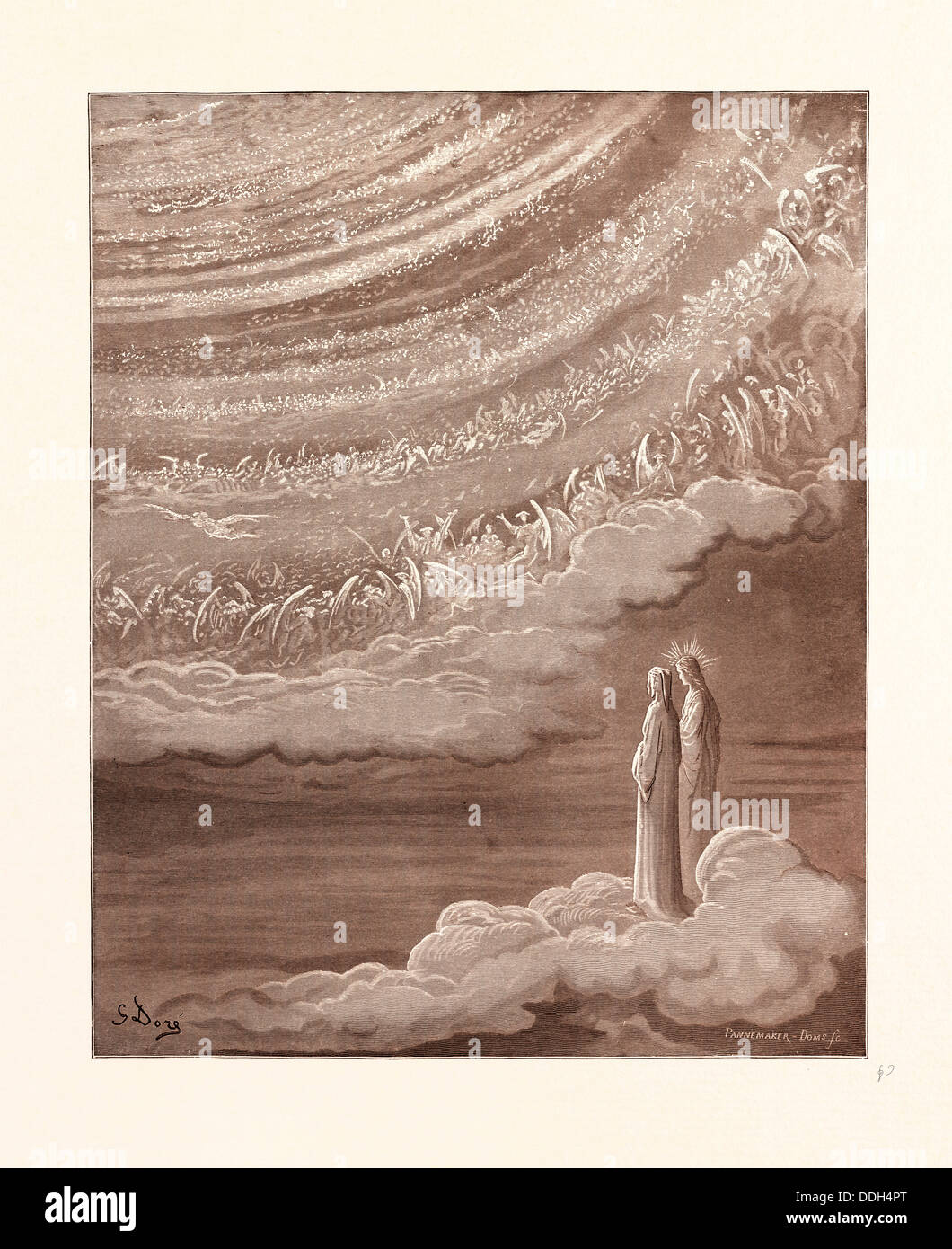 THE NINTH HEAVEN, BY GUSTAVE DORE Stock Photohttps://www.alamy.com/image-license-details/?v=1https://www.alamy.com/stock-photo-the-ninth-heaven-by-gustave-dore-59998592.html
THE NINTH HEAVEN, BY GUSTAVE DORE Stock Photohttps://www.alamy.com/image-license-details/?v=1https://www.alamy.com/stock-photo-the-ninth-heaven-by-gustave-dore-59998592.htmlRMDDH4PT–THE NINTH HEAVEN, BY GUSTAVE DORE
 Gustave Dore's Illustration 'Mercury' from Dante's Divine Comedy Stock Photohttps://www.alamy.com/image-license-details/?v=1https://www.alamy.com/stock-photo-gustave-dores-illustration-mercury-from-dantes-divine-comedy-26082932.html
Gustave Dore's Illustration 'Mercury' from Dante's Divine Comedy Stock Photohttps://www.alamy.com/image-license-details/?v=1https://www.alamy.com/stock-photo-gustave-dores-illustration-mercury-from-dantes-divine-comedy-26082932.htmlRMBEC518–Gustave Dore's Illustration 'Mercury' from Dante's Divine Comedy
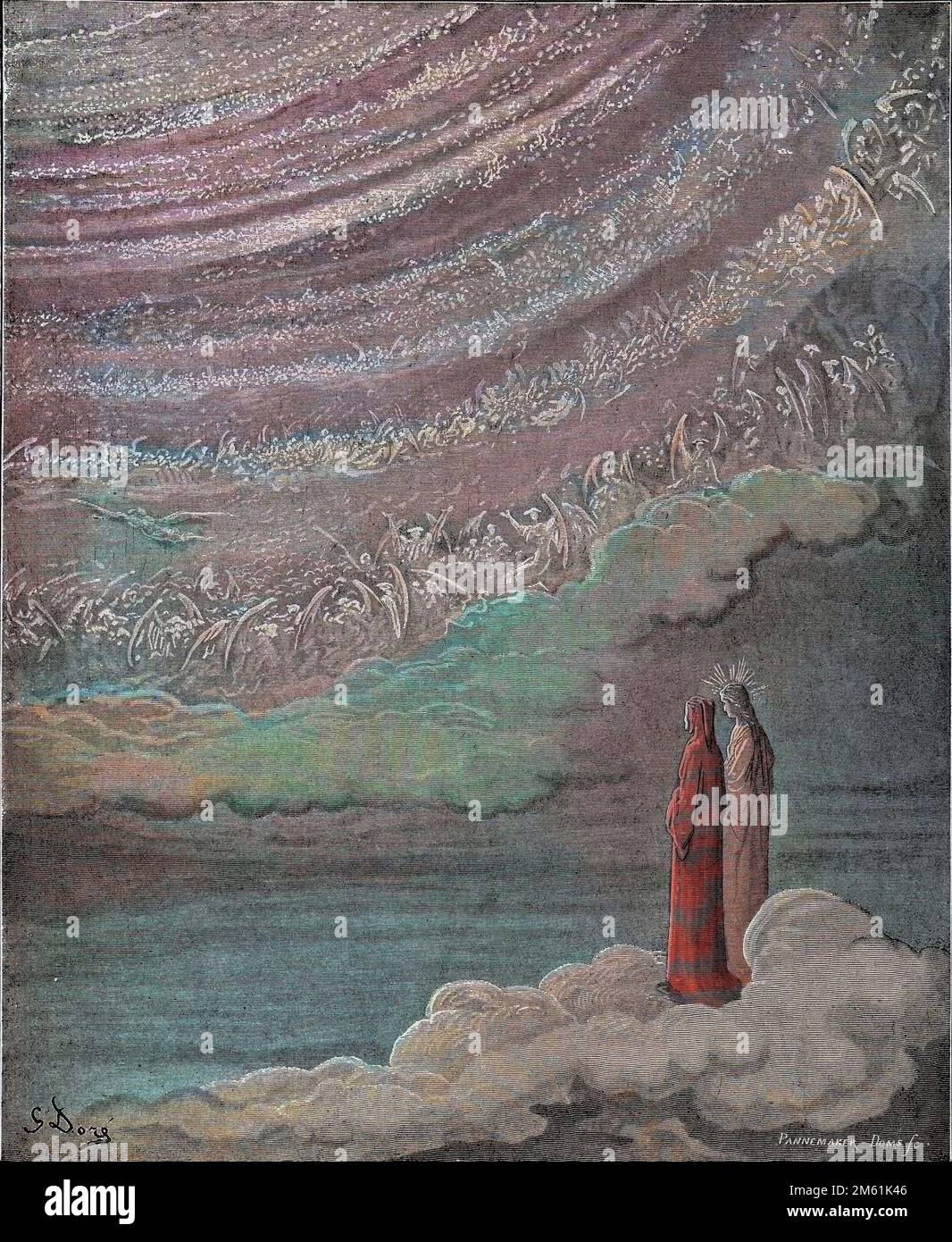 The Divine Comedy by Dante Alighieri , Paradiso, Canto 28 : The scintillating host of heaven - by Dante Alighieri (1265-1321) - Illustration de Gustave Dore (1832-1883), 1885 - Colorisation digitale d'apres l'originale - digitally coloured engraving Stock Photohttps://www.alamy.com/image-license-details/?v=1https://www.alamy.com/the-divine-comedy-by-dante-alighieri-paradiso-canto-28-the-scintillating-host-of-heaven-by-dante-alighieri-1265-1321-illustration-de-gustave-dore-1832-1883-1885-colorisation-digitale-dapres-loriginale-digitally-coloured-engraving-image502825574.html
The Divine Comedy by Dante Alighieri , Paradiso, Canto 28 : The scintillating host of heaven - by Dante Alighieri (1265-1321) - Illustration de Gustave Dore (1832-1883), 1885 - Colorisation digitale d'apres l'originale - digitally coloured engraving Stock Photohttps://www.alamy.com/image-license-details/?v=1https://www.alamy.com/the-divine-comedy-by-dante-alighieri-paradiso-canto-28-the-scintillating-host-of-heaven-by-dante-alighieri-1265-1321-illustration-de-gustave-dore-1832-1883-1885-colorisation-digitale-dapres-loriginale-digitally-coloured-engraving-image502825574.htmlRM2M61K46–The Divine Comedy by Dante Alighieri , Paradiso, Canto 28 : The scintillating host of heaven - by Dante Alighieri (1265-1321) - Illustration de Gustave Dore (1832-1883), 1885 - Colorisation digitale d'apres l'originale - digitally coloured engraving
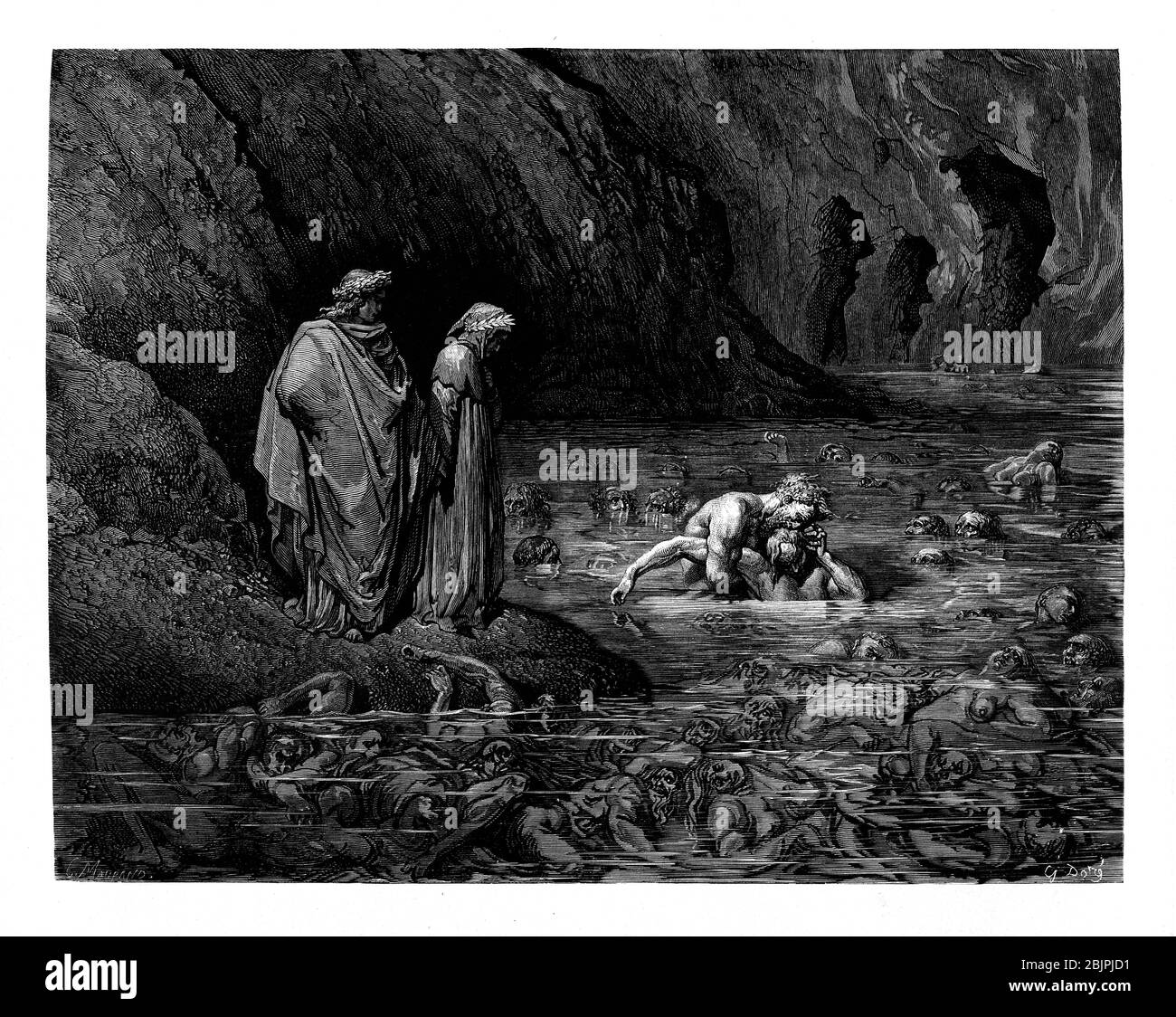 From the Divine Comedy by 14th century Italian poet Dante Alighieri. 1860 artwork, by French artist Gustave Dore and engraved by Stephane Pannemaker, from 'The Vision of Hell' (1868), Cary's English translation of the Inferno. Dante wrote his epic poem 'Divina Commedia' (The Divine Comedy) between 1308 and his death in 1321. Consisting of 14,233 lines, and divided into three parts (Inferno, Purgatorio, and Paradiso), it is considered the greatest literary work in the Italian language and a world masterpiece. It is a comprehensive survey of medieval theology, literature and thought. The new non Stock Photohttps://www.alamy.com/image-license-details/?v=1https://www.alamy.com/from-the-divine-comedy-by-14th-century-italian-poet-dante-alighieri-1860-artwork-by-french-artist-gustave-dore-and-engraved-by-stephane-pannemaker-from-the-vision-of-hell-1868-carys-english-translation-of-the-inferno-dante-wrote-his-epic-poem-divina-commedia-the-divine-comedy-between-1308-and-his-death-in-1321-consisting-of-14233-lines-and-divided-into-three-parts-inferno-purgatorio-and-paradiso-it-is-considered-the-greatest-literary-work-in-the-italian-language-and-a-world-masterpiece-it-is-a-comprehensive-survey-of-medieval-theology-literature-and-thought-the-new-non-image355768589.html
From the Divine Comedy by 14th century Italian poet Dante Alighieri. 1860 artwork, by French artist Gustave Dore and engraved by Stephane Pannemaker, from 'The Vision of Hell' (1868), Cary's English translation of the Inferno. Dante wrote his epic poem 'Divina Commedia' (The Divine Comedy) between 1308 and his death in 1321. Consisting of 14,233 lines, and divided into three parts (Inferno, Purgatorio, and Paradiso), it is considered the greatest literary work in the Italian language and a world masterpiece. It is a comprehensive survey of medieval theology, literature and thought. The new non Stock Photohttps://www.alamy.com/image-license-details/?v=1https://www.alamy.com/from-the-divine-comedy-by-14th-century-italian-poet-dante-alighieri-1860-artwork-by-french-artist-gustave-dore-and-engraved-by-stephane-pannemaker-from-the-vision-of-hell-1868-carys-english-translation-of-the-inferno-dante-wrote-his-epic-poem-divina-commedia-the-divine-comedy-between-1308-and-his-death-in-1321-consisting-of-14233-lines-and-divided-into-three-parts-inferno-purgatorio-and-paradiso-it-is-considered-the-greatest-literary-work-in-the-italian-language-and-a-world-masterpiece-it-is-a-comprehensive-survey-of-medieval-theology-literature-and-thought-the-new-non-image355768589.htmlRM2BJPJD1–From the Divine Comedy by 14th century Italian poet Dante Alighieri. 1860 artwork, by French artist Gustave Dore and engraved by Stephane Pannemaker, from 'The Vision of Hell' (1868), Cary's English translation of the Inferno. Dante wrote his epic poem 'Divina Commedia' (The Divine Comedy) between 1308 and his death in 1321. Consisting of 14,233 lines, and divided into three parts (Inferno, Purgatorio, and Paradiso), it is considered the greatest literary work in the Italian language and a world masterpiece. It is a comprehensive survey of medieval theology, literature and thought. The new non
 Illustration by Gustave Dore from The Vision of Purgatory and Paradise by Dante Alighieri Stock Photohttps://www.alamy.com/image-license-details/?v=1https://www.alamy.com/stock-photo-illustration-by-gustave-dore-from-the-vision-of-purgatory-and-paradise-50150094.html
Illustration by Gustave Dore from The Vision of Purgatory and Paradise by Dante Alighieri Stock Photohttps://www.alamy.com/image-license-details/?v=1https://www.alamy.com/stock-photo-illustration-by-gustave-dore-from-the-vision-of-purgatory-and-paradise-50150094.htmlRMCWGEXP–Illustration by Gustave Dore from The Vision of Purgatory and Paradise by Dante Alighieri
 DANTE'S ANCESTOR, BY GUSTAVE DORE Stock Photohttps://www.alamy.com/image-license-details/?v=1https://www.alamy.com/stock-photo-dantes-ancestor-by-gustave-dore-59998648.html
DANTE'S ANCESTOR, BY GUSTAVE DORE Stock Photohttps://www.alamy.com/image-license-details/?v=1https://www.alamy.com/stock-photo-dantes-ancestor-by-gustave-dore-59998648.htmlRMDDH4TT–DANTE'S ANCESTOR, BY GUSTAVE DORE
 Gustave Dore's Illustration 'The Cross' from Dante's Divine Comedy Stock Photohttps://www.alamy.com/image-license-details/?v=1https://www.alamy.com/stock-photo-gustave-dores-illustration-the-cross-from-dantes-divine-comedy-26083026.html
Gustave Dore's Illustration 'The Cross' from Dante's Divine Comedy Stock Photohttps://www.alamy.com/image-license-details/?v=1https://www.alamy.com/stock-photo-gustave-dores-illustration-the-cross-from-dantes-divine-comedy-26083026.htmlRMBEC54J–Gustave Dore's Illustration 'The Cross' from Dante's Divine Comedy
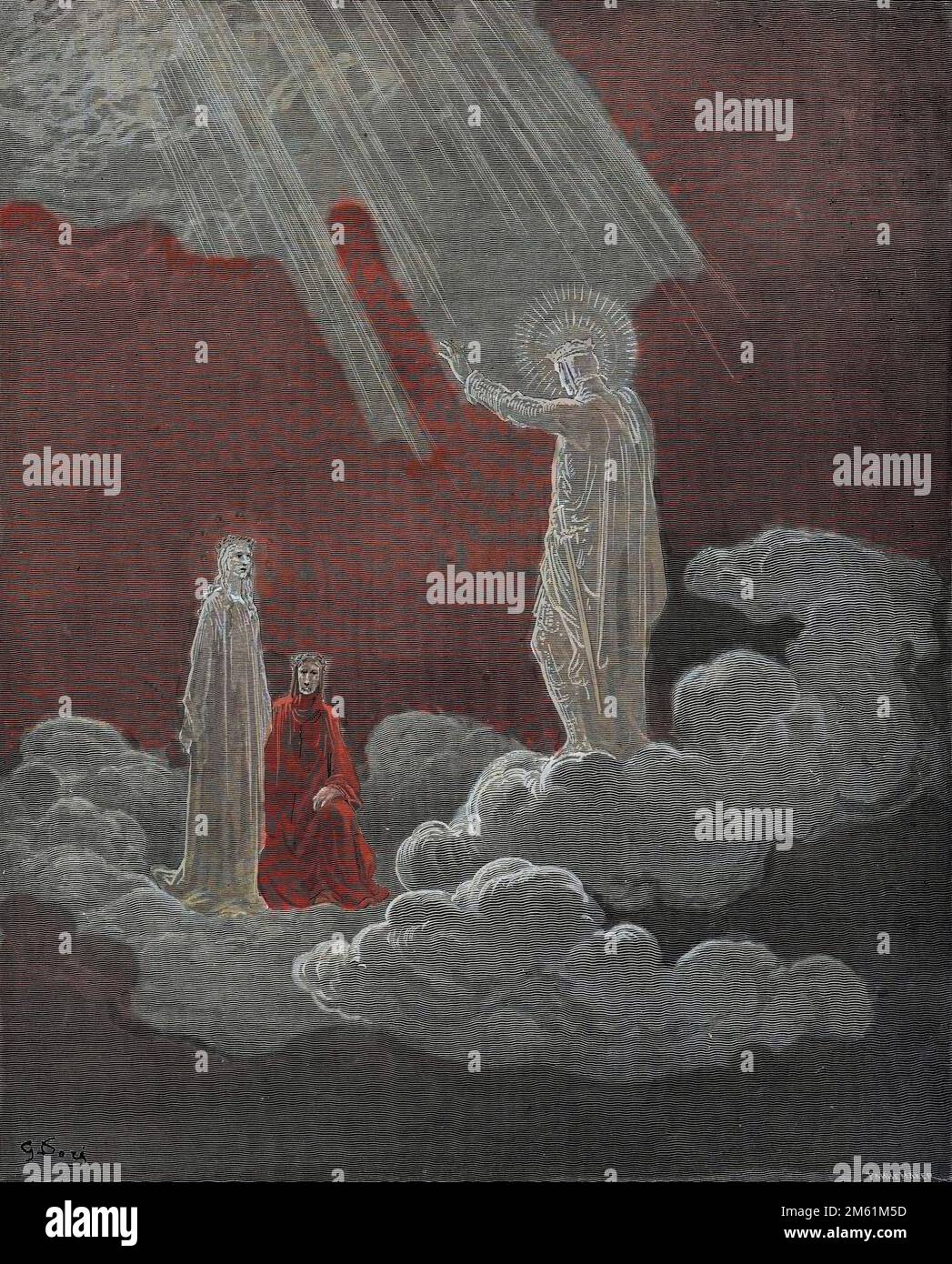 The Divine Comedy by Dante Alighieri , Paradiso, Canto 8 : Charles Martel addresses Dante and Beatrice - by Dante Alighieri (1265-1321) - Illustration de Gustave Dore (1832-1883), 1885 - Colorisation digitale d'apres l'originale Stock Photohttps://www.alamy.com/image-license-details/?v=1https://www.alamy.com/the-divine-comedy-by-dante-alighieri-paradiso-canto-8-charles-martel-addresses-dante-and-beatrice-by-dante-alighieri-1265-1321-illustration-de-gustave-dore-1832-1883-1885-colorisation-digitale-dapres-loriginale-image502826393.html
The Divine Comedy by Dante Alighieri , Paradiso, Canto 8 : Charles Martel addresses Dante and Beatrice - by Dante Alighieri (1265-1321) - Illustration de Gustave Dore (1832-1883), 1885 - Colorisation digitale d'apres l'originale Stock Photohttps://www.alamy.com/image-license-details/?v=1https://www.alamy.com/the-divine-comedy-by-dante-alighieri-paradiso-canto-8-charles-martel-addresses-dante-and-beatrice-by-dante-alighieri-1265-1321-illustration-de-gustave-dore-1832-1883-1885-colorisation-digitale-dapres-loriginale-image502826393.htmlRM2M61M5D–The Divine Comedy by Dante Alighieri , Paradiso, Canto 8 : Charles Martel addresses Dante and Beatrice - by Dante Alighieri (1265-1321) - Illustration de Gustave Dore (1832-1883), 1885 - Colorisation digitale d'apres l'originale
 Dante's Ancestor Stock Photohttps://www.alamy.com/image-license-details/?v=1https://www.alamy.com/dantes-ancestor-image240632852.html
Dante's Ancestor Stock Photohttps://www.alamy.com/image-license-details/?v=1https://www.alamy.com/dantes-ancestor-image240632852.htmlRMRYDNJC–Dante's Ancestor
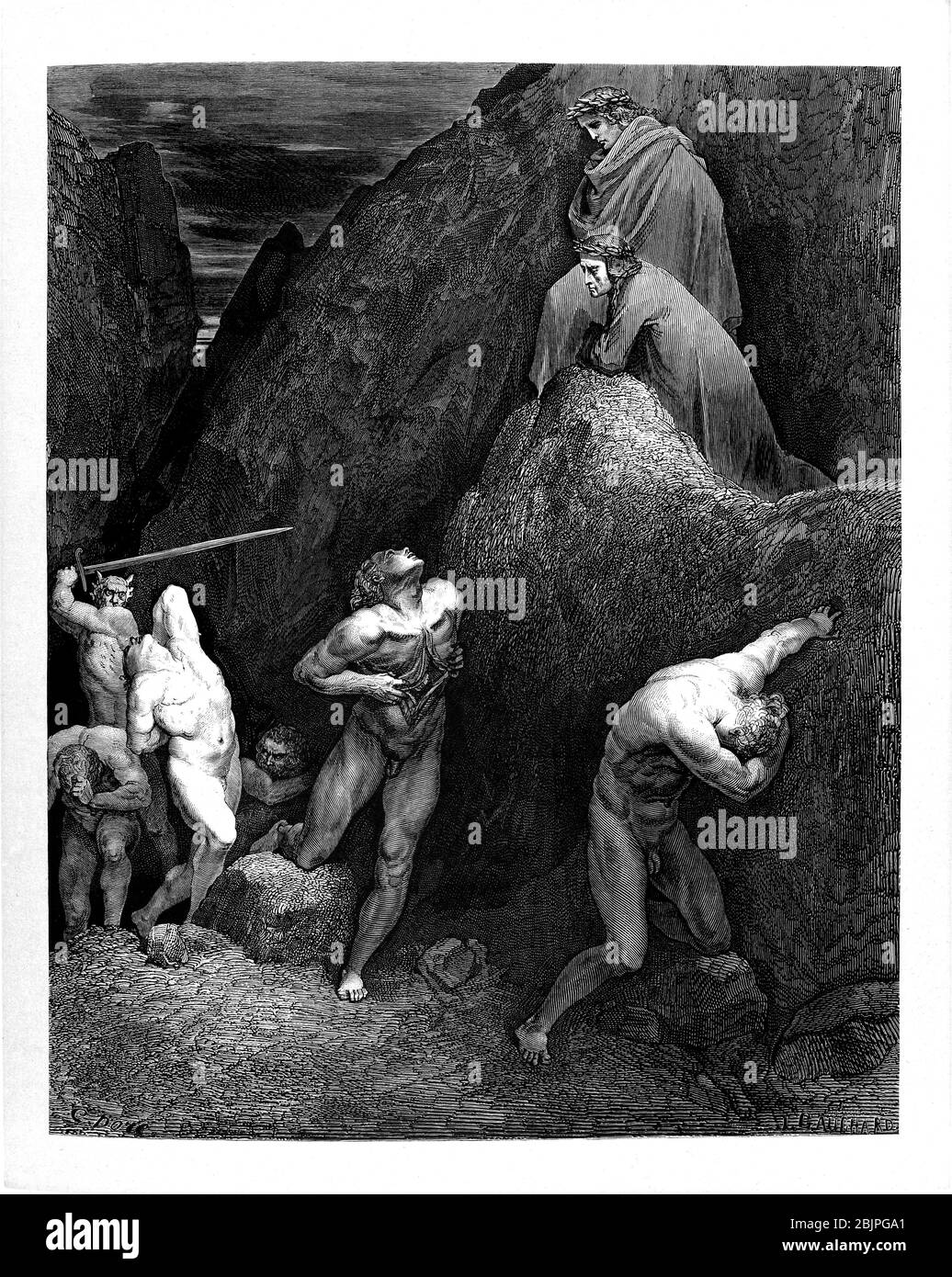 From the Divine Comedy by 14th century Italian poet Dante Alighieri. 1860 artwork, by French artist Gustave Dore and engraved by Stephane Pannemaker, from 'The Vision of Hell' (1868), Cary's English translation of the Inferno. Dante wrote his epic poem 'Divina Commedia' (The Divine Comedy) between 1308 and his death in 1321. Consisting of 14,233 lines, and divided into three parts (Inferno, Purgatorio, and Paradiso), it is considered the greatest literary work in the Italian language and a world masterpiece. It is a comprehensive survey of medieval theology, literature and thought. The new non Stock Photohttps://www.alamy.com/image-license-details/?v=1https://www.alamy.com/from-the-divine-comedy-by-14th-century-italian-poet-dante-alighieri-1860-artwork-by-french-artist-gustave-dore-and-engraved-by-stephane-pannemaker-from-the-vision-of-hell-1868-carys-english-translation-of-the-inferno-dante-wrote-his-epic-poem-divina-commedia-the-divine-comedy-between-1308-and-his-death-in-1321-consisting-of-14233-lines-and-divided-into-three-parts-inferno-purgatorio-and-paradiso-it-is-considered-the-greatest-literary-work-in-the-italian-language-and-a-world-masterpiece-it-is-a-comprehensive-survey-of-medieval-theology-literature-and-thought-the-new-non-image355766937.html
From the Divine Comedy by 14th century Italian poet Dante Alighieri. 1860 artwork, by French artist Gustave Dore and engraved by Stephane Pannemaker, from 'The Vision of Hell' (1868), Cary's English translation of the Inferno. Dante wrote his epic poem 'Divina Commedia' (The Divine Comedy) between 1308 and his death in 1321. Consisting of 14,233 lines, and divided into three parts (Inferno, Purgatorio, and Paradiso), it is considered the greatest literary work in the Italian language and a world masterpiece. It is a comprehensive survey of medieval theology, literature and thought. The new non Stock Photohttps://www.alamy.com/image-license-details/?v=1https://www.alamy.com/from-the-divine-comedy-by-14th-century-italian-poet-dante-alighieri-1860-artwork-by-french-artist-gustave-dore-and-engraved-by-stephane-pannemaker-from-the-vision-of-hell-1868-carys-english-translation-of-the-inferno-dante-wrote-his-epic-poem-divina-commedia-the-divine-comedy-between-1308-and-his-death-in-1321-consisting-of-14233-lines-and-divided-into-three-parts-inferno-purgatorio-and-paradiso-it-is-considered-the-greatest-literary-work-in-the-italian-language-and-a-world-masterpiece-it-is-a-comprehensive-survey-of-medieval-theology-literature-and-thought-the-new-non-image355766937.htmlRM2BJPGA1–From the Divine Comedy by 14th century Italian poet Dante Alighieri. 1860 artwork, by French artist Gustave Dore and engraved by Stephane Pannemaker, from 'The Vision of Hell' (1868), Cary's English translation of the Inferno. Dante wrote his epic poem 'Divina Commedia' (The Divine Comedy) between 1308 and his death in 1321. Consisting of 14,233 lines, and divided into three parts (Inferno, Purgatorio, and Paradiso), it is considered the greatest literary work in the Italian language and a world masterpiece. It is a comprehensive survey of medieval theology, literature and thought. The new non
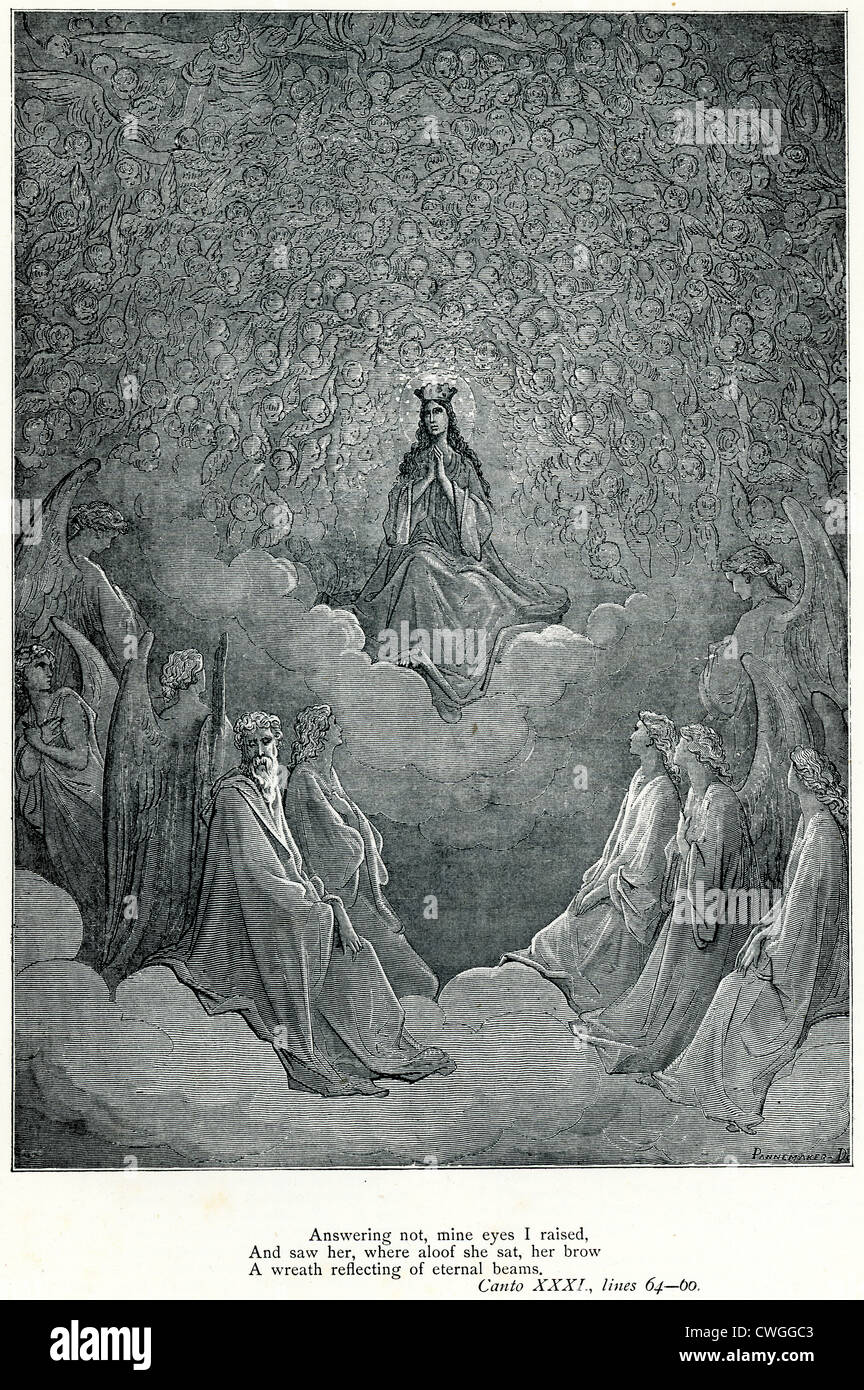 Illustration by Gustave Dore from The Vision of Purgatory and Paradise by Dante Alighieri Stock Photohttps://www.alamy.com/image-license-details/?v=1https://www.alamy.com/stock-photo-illustration-by-gustave-dore-from-the-vision-of-purgatory-and-paradise-50151251.html
Illustration by Gustave Dore from The Vision of Purgatory and Paradise by Dante Alighieri Stock Photohttps://www.alamy.com/image-license-details/?v=1https://www.alamy.com/stock-photo-illustration-by-gustave-dore-from-the-vision-of-purgatory-and-paradise-50151251.htmlRMCWGGC3–Illustration by Gustave Dore from The Vision of Purgatory and Paradise by Dante Alighieri
 Gustave Dore's Illustration 'Beatrice' from Dante's Divine Comedy Stock Photohttps://www.alamy.com/image-license-details/?v=1https://www.alamy.com/stock-photo-gustave-dores-illustration-beatrice-from-dantes-divine-comedy-26083131.html
Gustave Dore's Illustration 'Beatrice' from Dante's Divine Comedy Stock Photohttps://www.alamy.com/image-license-details/?v=1https://www.alamy.com/stock-photo-gustave-dores-illustration-beatrice-from-dantes-divine-comedy-26083131.htmlRMBEC58B–Gustave Dore's Illustration 'Beatrice' from Dante's Divine Comedy
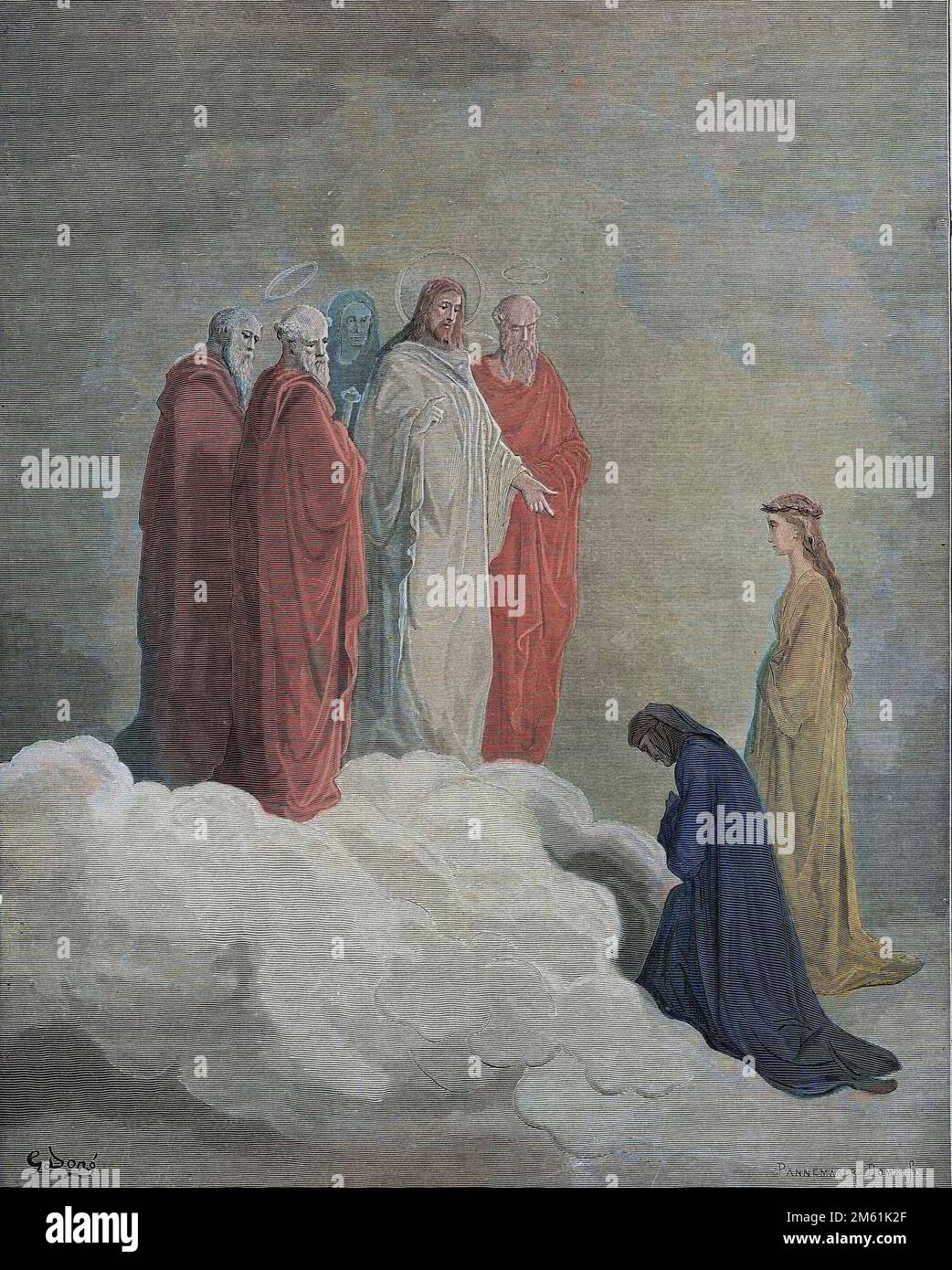 The Divine Comedy by Dante Alighieri , Paradiso, Canto 26 : St John examines Dante concerning love - by Dante Alighieri (1265-1321) - Illustration de Gustave Dore (1832-1883), 1885 - Colorisation digitale d'apres l'originale Stock Photohttps://www.alamy.com/image-license-details/?v=1https://www.alamy.com/the-divine-comedy-by-dante-alighieri-paradiso-canto-26-st-john-examines-dante-concerning-love-by-dante-alighieri-1265-1321-illustration-de-gustave-dore-1832-1883-1885-colorisation-digitale-dapres-loriginale-image502825527.html
The Divine Comedy by Dante Alighieri , Paradiso, Canto 26 : St John examines Dante concerning love - by Dante Alighieri (1265-1321) - Illustration de Gustave Dore (1832-1883), 1885 - Colorisation digitale d'apres l'originale Stock Photohttps://www.alamy.com/image-license-details/?v=1https://www.alamy.com/the-divine-comedy-by-dante-alighieri-paradiso-canto-26-st-john-examines-dante-concerning-love-by-dante-alighieri-1265-1321-illustration-de-gustave-dore-1832-1883-1885-colorisation-digitale-dapres-loriginale-image502825527.htmlRM2M61K2F–The Divine Comedy by Dante Alighieri , Paradiso, Canto 26 : St John examines Dante concerning love - by Dante Alighieri (1265-1321) - Illustration de Gustave Dore (1832-1883), 1885 - Colorisation digitale d'apres l'originale
 The Vision of the Sixth Heaven, by Gustave Doré, 1832 - 1883, French. Engraving for Paradiso by Dante, 1870, Romanticism Stock Photohttps://www.alamy.com/image-license-details/?v=1https://www.alamy.com/stock-photo-the-vision-of-the-sixth-heaven-by-gustave-dor-1832-1883-french-engraving-123361754.html
The Vision of the Sixth Heaven, by Gustave Doré, 1832 - 1883, French. Engraving for Paradiso by Dante, 1870, Romanticism Stock Photohttps://www.alamy.com/image-license-details/?v=1https://www.alamy.com/stock-photo-the-vision-of-the-sixth-heaven-by-gustave-dor-1832-1883-french-engraving-123361754.htmlRMH4KH4X–The Vision of the Sixth Heaven, by Gustave Doré, 1832 - 1883, French. Engraving for Paradiso by Dante, 1870, Romanticism
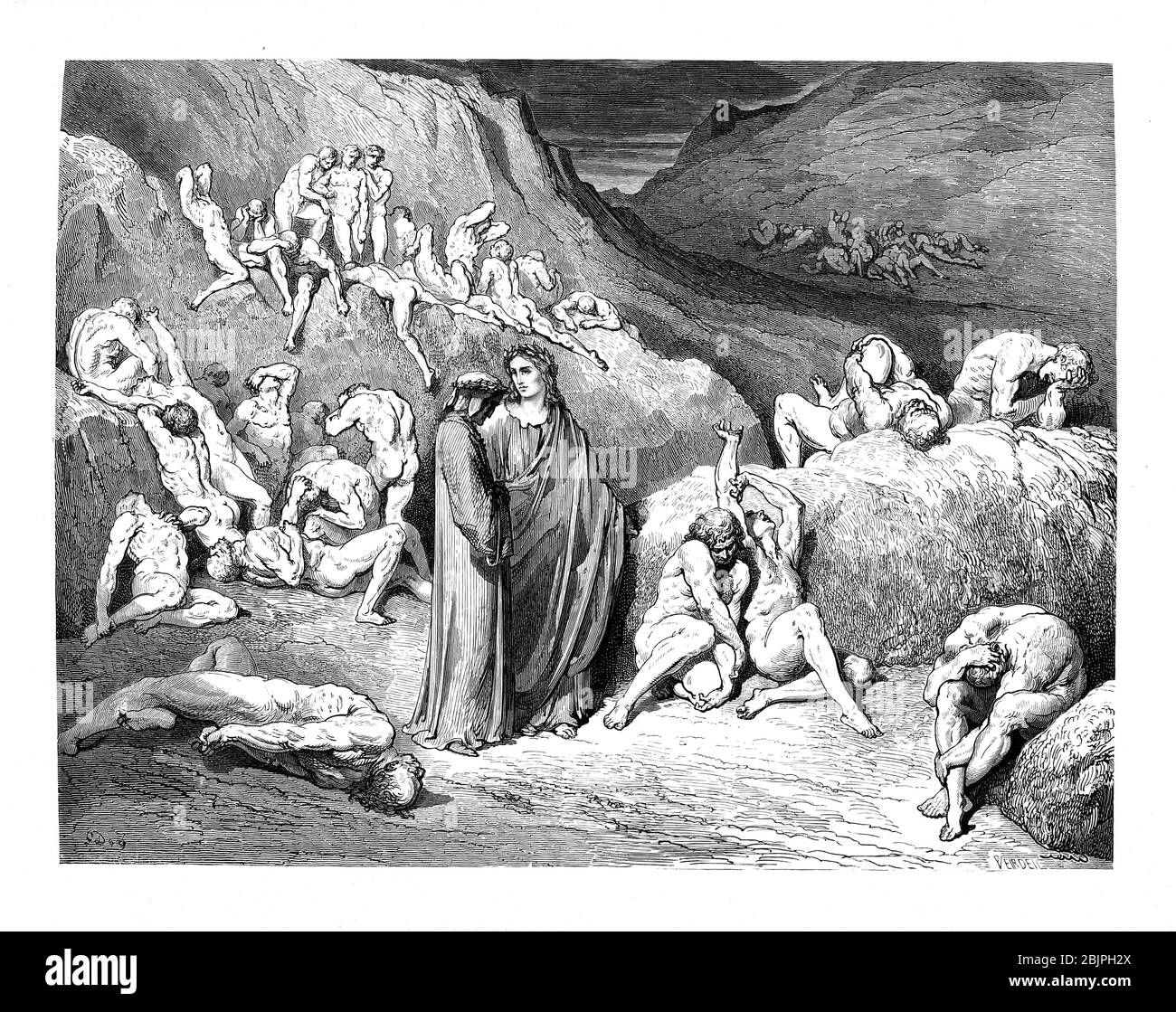 From the Divine Comedy by 14th century Italian poet Dante Alighieri. 1860 artwork, by French artist Gustave Dore and engraved by Stephane Pannemaker, from 'The Vision of Hell' (1868), Cary's English translation of the Inferno. Dante wrote his epic poem 'Divina Commedia' (The Divine Comedy) between 1308 and his death in 1321. Consisting of 14,233 lines, and divided into three parts (Inferno, Purgatorio, and Paradiso), it is considered the greatest literary work in the Italian language and a world masterpiece. It is a comprehensive survey of medieval theology, literature and thought. The new non Stock Photohttps://www.alamy.com/image-license-details/?v=1https://www.alamy.com/from-the-divine-comedy-by-14th-century-italian-poet-dante-alighieri-1860-artwork-by-french-artist-gustave-dore-and-engraved-by-stephane-pannemaker-from-the-vision-of-hell-1868-carys-english-translation-of-the-inferno-dante-wrote-his-epic-poem-divina-commedia-the-divine-comedy-between-1308-and-his-death-in-1321-consisting-of-14233-lines-and-divided-into-three-parts-inferno-purgatorio-and-paradiso-it-is-considered-the-greatest-literary-work-in-the-italian-language-and-a-world-masterpiece-it-is-a-comprehensive-survey-of-medieval-theology-literature-and-thought-the-new-non-image355767522.html
From the Divine Comedy by 14th century Italian poet Dante Alighieri. 1860 artwork, by French artist Gustave Dore and engraved by Stephane Pannemaker, from 'The Vision of Hell' (1868), Cary's English translation of the Inferno. Dante wrote his epic poem 'Divina Commedia' (The Divine Comedy) between 1308 and his death in 1321. Consisting of 14,233 lines, and divided into three parts (Inferno, Purgatorio, and Paradiso), it is considered the greatest literary work in the Italian language and a world masterpiece. It is a comprehensive survey of medieval theology, literature and thought. The new non Stock Photohttps://www.alamy.com/image-license-details/?v=1https://www.alamy.com/from-the-divine-comedy-by-14th-century-italian-poet-dante-alighieri-1860-artwork-by-french-artist-gustave-dore-and-engraved-by-stephane-pannemaker-from-the-vision-of-hell-1868-carys-english-translation-of-the-inferno-dante-wrote-his-epic-poem-divina-commedia-the-divine-comedy-between-1308-and-his-death-in-1321-consisting-of-14233-lines-and-divided-into-three-parts-inferno-purgatorio-and-paradiso-it-is-considered-the-greatest-literary-work-in-the-italian-language-and-a-world-masterpiece-it-is-a-comprehensive-survey-of-medieval-theology-literature-and-thought-the-new-non-image355767522.htmlRM2BJPH2X–From the Divine Comedy by 14th century Italian poet Dante Alighieri. 1860 artwork, by French artist Gustave Dore and engraved by Stephane Pannemaker, from 'The Vision of Hell' (1868), Cary's English translation of the Inferno. Dante wrote his epic poem 'Divina Commedia' (The Divine Comedy) between 1308 and his death in 1321. Consisting of 14,233 lines, and divided into three parts (Inferno, Purgatorio, and Paradiso), it is considered the greatest literary work in the Italian language and a world masterpiece. It is a comprehensive survey of medieval theology, literature and thought. The new non
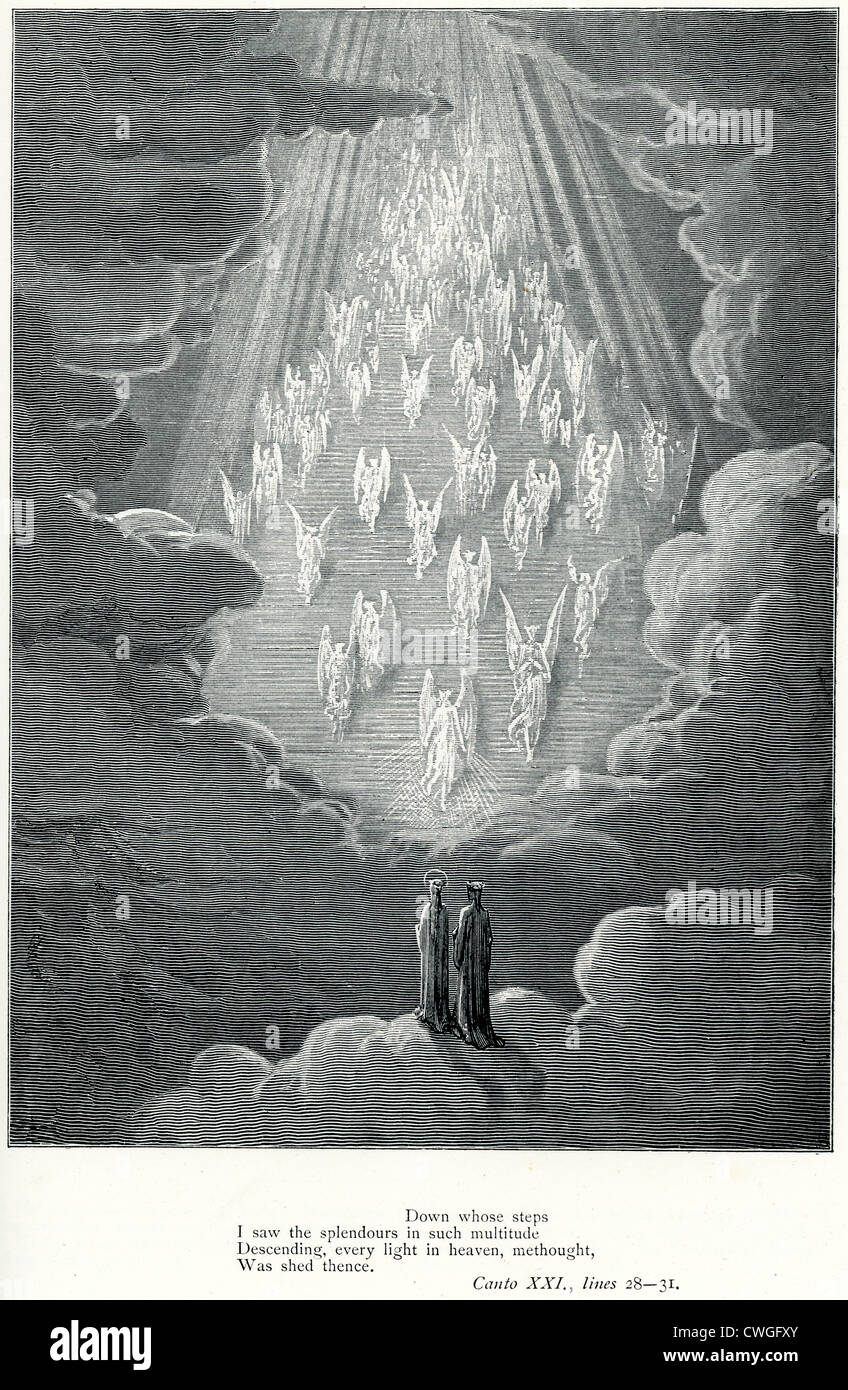 Illustration by Gustave Dore from The Vision of Purgatory and Paradise by Dante Alighieri Stock Photohttps://www.alamy.com/image-license-details/?v=1https://www.alamy.com/stock-photo-illustration-by-gustave-dore-from-the-vision-of-purgatory-and-paradise-50150883.html
Illustration by Gustave Dore from The Vision of Purgatory and Paradise by Dante Alighieri Stock Photohttps://www.alamy.com/image-license-details/?v=1https://www.alamy.com/stock-photo-illustration-by-gustave-dore-from-the-vision-of-purgatory-and-paradise-50150883.htmlRMCWGFXY–Illustration by Gustave Dore from The Vision of Purgatory and Paradise by Dante Alighieri
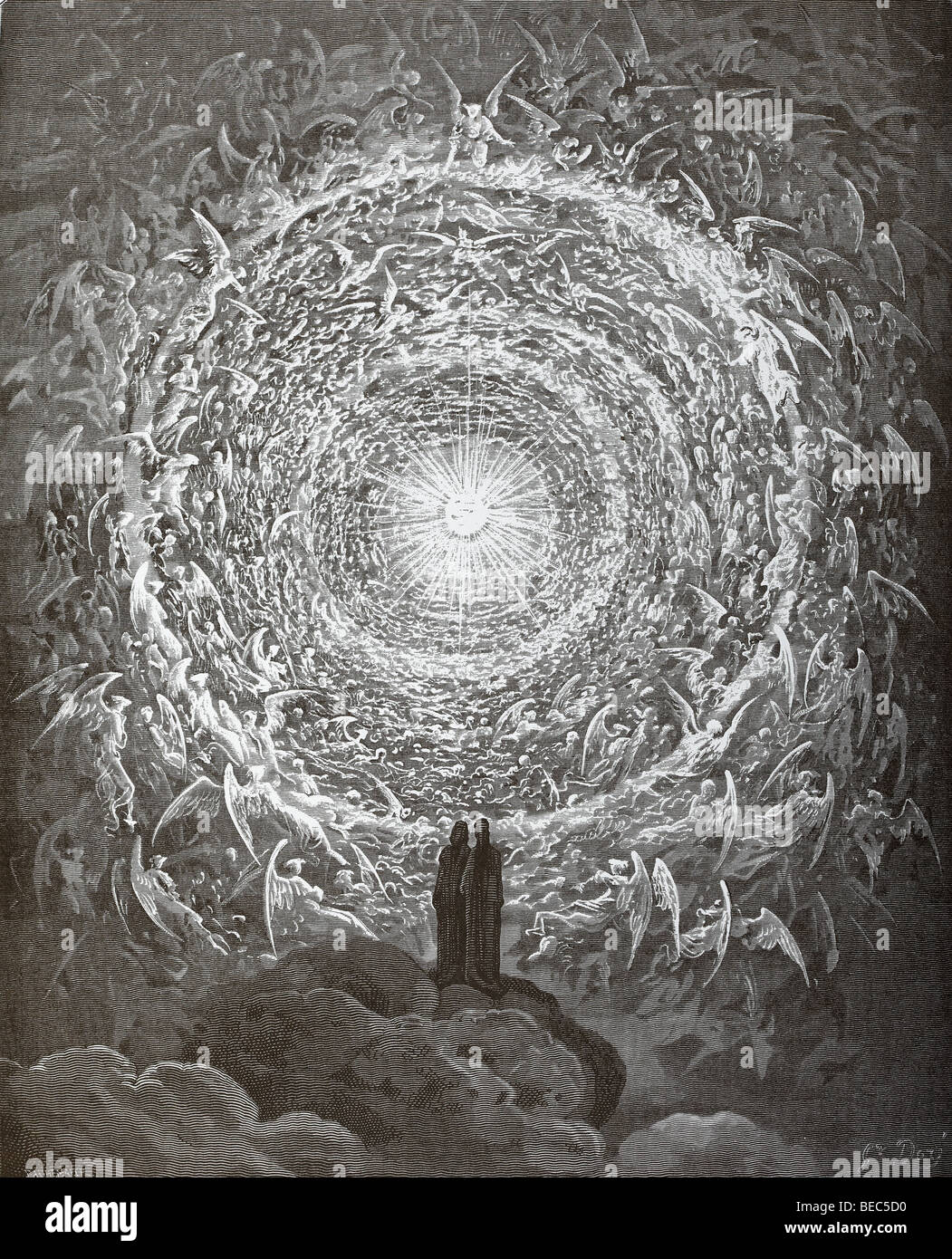 Gustave Dore's Illustration 'The Empyrean' from Dante's Divine Comedy Stock Photohttps://www.alamy.com/image-license-details/?v=1https://www.alamy.com/stock-photo-gustave-dores-illustration-the-empyrean-from-dantes-divine-comedy-26083260.html
Gustave Dore's Illustration 'The Empyrean' from Dante's Divine Comedy Stock Photohttps://www.alamy.com/image-license-details/?v=1https://www.alamy.com/stock-photo-gustave-dores-illustration-the-empyrean-from-dantes-divine-comedy-26083260.htmlRMBEC5D0–Gustave Dore's Illustration 'The Empyrean' from Dante's Divine Comedy
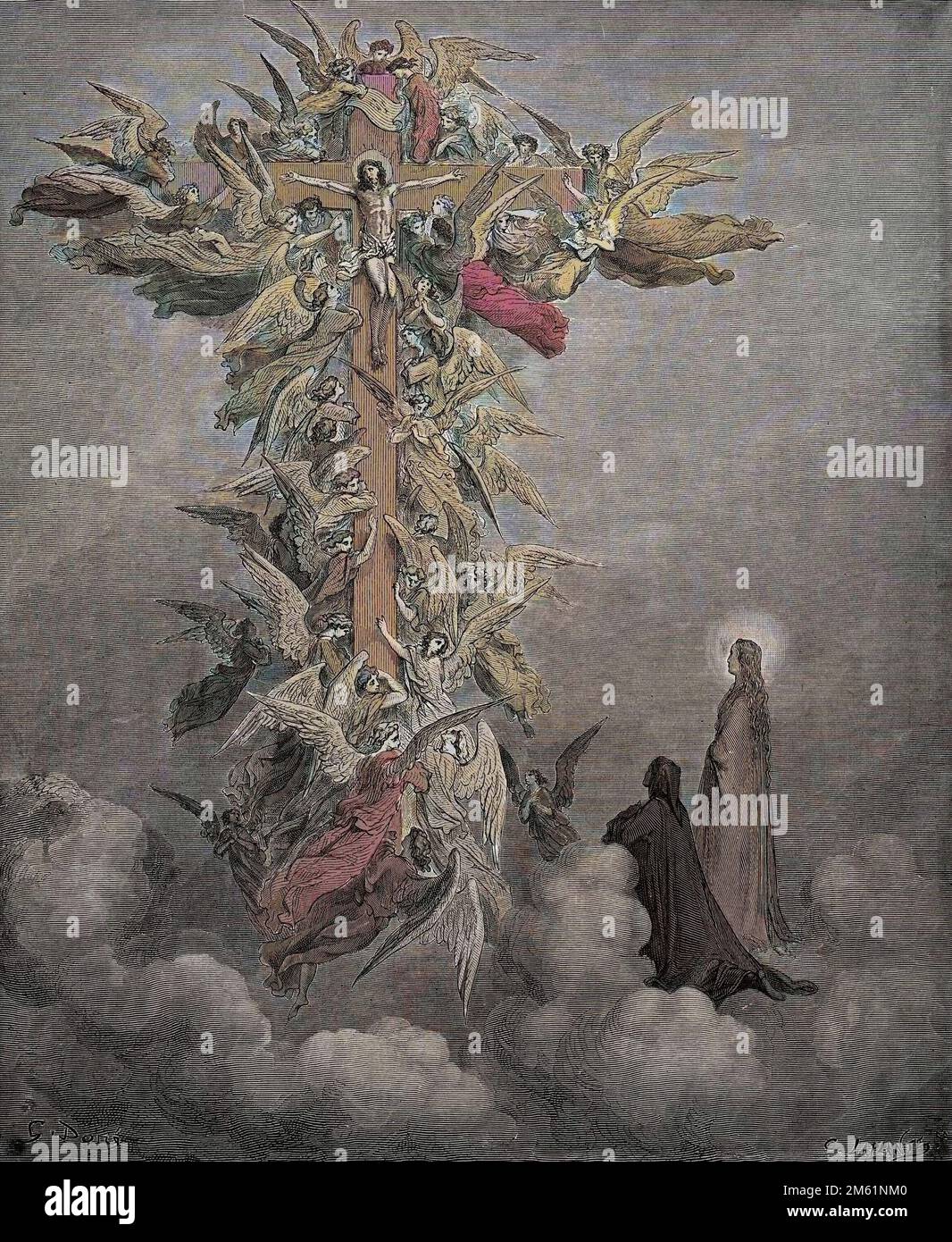 The Divine Comedy by Dante Alighieri , Paradiso, Canto 14 : Dante and Beatrice see the angels with Christ on the cross - by Dante Alighieri (1265-1321) - Illustration de Gustave Dore (1832-1883), 1885 - Colorisation digitale d'apres l'originale Stock Photohttps://www.alamy.com/image-license-details/?v=1https://www.alamy.com/the-divine-comedy-by-dante-alighieri-paradiso-canto-14-dante-and-beatrice-see-the-angels-with-christ-on-the-cross-by-dante-alighieri-1265-1321-illustration-de-gustave-dore-1832-1883-1885-colorisation-digitale-dapres-loriginale-image502827584.html
The Divine Comedy by Dante Alighieri , Paradiso, Canto 14 : Dante and Beatrice see the angels with Christ on the cross - by Dante Alighieri (1265-1321) - Illustration de Gustave Dore (1832-1883), 1885 - Colorisation digitale d'apres l'originale Stock Photohttps://www.alamy.com/image-license-details/?v=1https://www.alamy.com/the-divine-comedy-by-dante-alighieri-paradiso-canto-14-dante-and-beatrice-see-the-angels-with-christ-on-the-cross-by-dante-alighieri-1265-1321-illustration-de-gustave-dore-1832-1883-1885-colorisation-digitale-dapres-loriginale-image502827584.htmlRM2M61NM0–The Divine Comedy by Dante Alighieri , Paradiso, Canto 14 : Dante and Beatrice see the angels with Christ on the cross - by Dante Alighieri (1265-1321) - Illustration de Gustave Dore (1832-1883), 1885 - Colorisation digitale d'apres l'originale